
Title: The Great Lakes
Author: James Oliver Curwood
Release date: September 4, 2016 [eBook #52976]
Most recently updated: October 23, 2024
Language: English
Credits: Produced by Roger Frank, Charlie Howard, and the Online
Distributed Proofreading Team at http://www.pgdp.net (This
book was produced from images made available by the
HathiTrust Digital Library.)


The Fountain of the Great Lakes
Lorado Taft, Sculptor
The Vessels That Plough Them: Their Owners,
Their Sailors, and Their Cargoes
Together with
A Brief History of Our Inland Seas
By
James Oliver Curwood
With 72 Illustrations and a Map
G. P. Putnam’s Sons
New York and London
The Knickerbocker Press
1909
Copyright, 1909
BY
JAMES OLIVER CURWOOD
The Knickerbocker Press, New York
TO HIS
FATHER AND MOTHER
WHOSE ENCOURAGEMENT AND FAITH IN HIM HAVE BEEN UNFAILING,
THE AUTHOR
AFFECTIONATELY DEDICATES THIS BOOK
In this volume, it has been my object to tell of the people and of the picturesque life of the Great Lakes, and to set before my readers actual facts about the cities, the commerce, and the future of the greatest fresh-water seas in the world. For some unaccountable reason, the Great Lakes, notwithstanding the fact that more than thirty million people live in the States bordering their shores, and in spite of the still more remarkable fact that they are doing more than anything else on the American continent for the commercial progress of the nation, have been almost entirely neglected by writers. To-day there are but few people who know that one of the three greatest ports and the largest fleet of freighters in the world are on these unsalted waters; and I mention the fact in this particular place simply to bring home to the casual reader how little is known by the public at large about our Inland Seas. For this reason, I have not dealt with any single side of Lake life, but have attempted to present as many phases of it as I could; and, for the same reason, I have added a brief historical account of the Lakes atvi the end of the book. It has been my desire, too, that these pages, from the beginning, should prove of especial value to those many thousands all over the world who are, or may in the future be, directly interested in the Lakes in a business way; and a great deal of attention has, therefore, been given to the commercial side of my subject—statistics and facts regarding Lake commerce, the opportunities of the present day, and a forecast of what the coming years hold in store for the men who have investments, or who plan to invest in business enterprises, on or about the Great Lakes.
While dwelling upon the importance of the commercial life of the Inland Seas, I wish also to emphasise the fact that I have kept always in mind another large class of people who are keenly interested in my subject, though not from a commercial standpoint. The present volume is designed to interest this latter class by portraying another side of Lake life—the human side, the romance and the tragedy that have played their thrilling parts upon these waters; the wonders of their progress; the story of their ships, their men, their wars, for of all the pages in the history of the North American continent none are more thrilling, or more filled with the romantic and the picturesque, than those which tell the story of our fresh-water seas.
In conclusion, I wish to say that I owe a great debt of gratitude to the scores of Lake “owners,” ship-builders,vii and captains who have aided me, in every way possible, in the preparation of this volume, and without whose personal co-operation the writing of it would have been impossible.
J. O. C.
Detroit, Michigan, 1909.
| PAGE | ||
| PART I | ||
| THE SHIPS, THEIR OWNERS, THEIR SAILORS, AND THEIR CARGOES | ||
| I— | The Building of the Ships | 3 |
| II— | What the Ships Carry—Ore | 25 |
| III— | What the Ships Carry—Other Cargoes | 46 |
| IV— | Passenger Traffic and Summer Life | 68 |
| V— | The Romance and Tragedy of the Inland Seas | 89 |
| VI— | Buffalo and Duluth: the Alpha and Omega of the Lakes | 113 |
| VII— | A Trip on a Great Lakes Freighter | 137 |
| PART II | ||
| ORIGIN AND HISTORY OF THE LAKES | ||
| I— | Origin and Early History | 159 |
| II— | The Lakes Change Masters | 175 |
| III— | The War of 1812 and After | 194 |
| Index | 223 | |
| Page | |
| The Fountain of the Great Lakes | Frontispiece |
| Lorado Taft, Sculptor. | |
| The First Step in the Making of a Ship—Laying the “Keel Blocks” | 4 |
| Second Step—Laying the Keel, or Bottom of the Ship, on the “Keel Blocks” | 6 |
| The Growing Ship | 8 |
| Vessel Almost Ready for Launching | 10 |
| A Monster of Steel and Iron Ready to be Launched | 12 |
| Weight 9,500,000 lbs. | |
| The Launching | 14 |
| The “Thomas F. Cole,” 11,200 Tons, Being Fitted with Engines and Boilers after her Launching | 16 |
| The “Cole” is the largest ship on the Lakes. Length, 605 feet 5 inches. | |
| Her First Trip—Off for the Ore Regions of the North | 18 |
| This Shows Some of the 800,000 Rivets that Go to the Making of a 10,000-Ton Leviathan of the Inland Seas | 22 |
| Ice-Bound. Thirty-two Boats Tied up in the Ice at the Soo | 26 |
| From a Photograph by Lord & Thomas, Sault Ste. Marie, Mich. | |
| A Network of Tracks Running through the Ore Lands | 28xii |
| Captains of the Vessels of the American Steamship Company | 30 |
| The “Montezuma” | 32 |
| The largest wooden ship on fresh water being towed out of the Maumee River, Toledo. | |
| A Coal Dock at Superior, Wisconsin | 34 |
| The pile of coal is 1400 feet long and 30 feet high. | |
| The Record Load Hauled by One Team out of the Michigan Woods, 20,000 Feet | 36 |
| One Steam Shovel Keeps Three Locomotives and Trains Busy | 38 |
| Steamers at a Modern Ore Unloading Plant at Conneaut | 40 |
| The Main Slip in the Harbour of Conneaut | 42 |
| Conneaut is the second largest ore-receiving port on the Lakes. | |
| One of the Huge Open Pits of the Mesaba Range | 44 |
| A Raft of Five Million Pulp Logs on the North Shore of Lake Michigan | 48 |
| Scooping up Ore from the Mahoning Mine at Hibbing | 52 |
| The largest open pit mine in the world. | |
| A Mining Town on the Mesaba Range, where a Few Years ago the Deer and Bear Roamed Undisturbed | 54 |
| Harbour View at Conneaut, Ohio, Showing Docks and Machinery | 56 |
| A Steam Shovel at Work | 58 |
| This removes from 4000 to 8000 tons of ore a day. | |
| The Old and the New | 62xiii |
| A modern freight carrier passing one of the old schooners. | |
| A Shaft on One of the Ranges | 66 |
| The “North West” | 68 |
| One of the finest passenger steamers on the Great Lakes. | |
| The Stop at Tashinoo Park, St. Clair Flats | 70 |
| The Landing at Mackinac Dock, Michigan | 72 |
| Hickory Island at the Mouth of Detroit River | 74 |
| From a Photograph by Manning Studio, Detroit. | |
| The “City of Erie” | 76 |
| The fastest steamer on the Lakes, holding a record of 22.93 miles per hour. | |
| Little Venice, St. Clair River | 80 |
| Showing the type of “Inns,” where people may pass their holidays at small expense. Courtesy of Northern Steamship Co. | |
| A Scene on Belle Isle, Detroit River | 82 |
| Steamer “Western States” | 84 |
| One of the largest and fastest boats on the Lakes. Carries 2500 people and her fastest speed is 20 miles an hour. From a Photograph by Detroit Photographic Co. | |
| Steamship “North West” in American Lock | 86 |
| Cottages Built at Small Expense along the St. Mary’s River | 88 |
| A Steamer Stripped by a Tow-line by Running between a Steamer and her Consort | 90 |
| From a Photograph by Lord & Rhoades, Sault Ste. Marie, Mich. | |
| A Remarkable Photograph Showing the Big Freighter “Stimson” in a Holocaust of Smoke and Flame | 94 |
| After a Fierce Night’s “Late Navigation” Run across Lake Superior | 96xiv |
| A Ship that Made the Shore before she Sank. The Work of Raising her in Progress | 100 |
| A Treacherous Sea in its Garb of Greatest Beauty | 102 |
| One phase of Lake navigation. | |
| A View of the “Zimmerman” | 104 |
| After a collision with another freighter. | |
| The Steamer “Wahcondah” | 108 |
| One of the Lake grain carriers which was caught in a storm late in the season after being buffeted by the waves of Lake Superior for about fourteen hours. | |
| This is One of the Most Remarkable Photographs Ever Taken on the Lakes. It Shows a Sinking Lumber Barge just as She Was Breaking in Two | 110 |
| The photograph was taken from a small boat. | |
| The Residence of Ansley Wilcox at Buffalo | 114 |
| Where President Roosevelt took the oath of office. Copyright 1908 by Detroit Photographic Co. | |
| A Bird’s-eye View of the Harbour of Duluth, Taken from the Hill | 116 |
| From a Photograph by Maher, Duluth. | |
| The Ship Canal and Aërial Bridge, Duluth, Minn. | 118 |
| Copyright 1908 by Detroit Photographic Co. | |
| Fleet of Boats in Duluth Harbour Waiting to Unload | 122 |
| View Looking South-west from the New Chamber of Commerce Building, Buffalo | 124 |
| Unloading at One of the Coal Docks at Duluth | 126 |
| A Fleet of Erie Canal Boats—Capacity of Each 150 Tons | 128xv |
| The boats on the new canal will be 1000 tons each. | |
| The Jack-Knife Bridge at Buffalo | 132 |
| A Scene on Blackwell Canal | 134 |
| The winter home of big boats in Buffalo. | |
| Some of the Grain Elevators at Duluth, which Have a Combined Storage Capacity of 35,550,000 Bushels | 136 |
| The Mesaba Ore Docks | 138 |
| From the Deck of the Ship the Tug Looks Like an Ant Dragging at a Huge Prey | 142 |
| Observation Room on the “Wm. G. Mather” | 144 |
| Which gives an idea of the luxuriousness of the guests’ quarters on a Great Lakes freighter. | |
| The Luxurious Dining-room on the 10,000-Ton Steamer “J. H. Sheadle” | 146 |
| Tugs Trying to Release Boats Held in the Ice at the Soo | 150 |
| Copyright 1906 by Young, Lord & Rhoades, Ltd. | |
| Whaleback Barges Preparing for Winter Quarters at Conneaut, Ohio | 152 |
| (The Whaleback is a type of vessel that has been tried and found wanting. They are going out of use.) | |
| Ashore | 154 |
| Arch Rock, Mackinac Island | 160 |
| One of the natural wonders of the world. | |
| Fort Mackinac | 168 |
| Marquette’s Grave, St. Ignace, Michigan | 174xvi |
| Monument at Put-in-Bay in Memory of the British and Americans who Died in the Battle of Lake Erie | 182 |
| Old West Blockhouse, Fort Mackinac | 186 |
| Built by the British, about 1780. | |
| The Monument Erected to those who Fought and Died on Mackinac Island | 190 |
| Mackinac Island, Showing Old Fort Mackinac | 194 |
| Once the Scene of Bloodshed and Strife, these Old Trees Stand where French, Indian, and British Fought Years ago | 200 |
| A View of the Historic Battle-ground on Mackinac Island | 206 |
| An Old British Gunboat Discovered in the River Thames | 212 |
| Scene when Admiral Dewey Passed through the Soo Locks | 216 |
| Map | At End |
Not long ago, I was on a Lake freighter pounding her way up Huron on the “thousand-mile highway” that leads to Duluth. Beside me was a man who had climbed from poverty to millions. He was riding in his own ship. His interests burned ten thousand tons of coal a year. He was one of the ore kings of the North—as rough as the iron he dug, filled to the brim with enthusiasm and animal energy of the Lake breed; a man who had helped to make the Lakes what they are, as scores of others like him have done. Before and behind us there trailed the smoke of a dozen of the steel leviathans of the Inland Seas. I had asked him a question, and there was the fire of a great pride in his eyes when he answered.
“It would make a nation by itself—this Lake country!” he said. “And it would be America. It’s America from Buffalo to Duluth, every inch of it, and the people who are in it are Americans. That’s American smoke you see off there, and American ships are making it; they’re run by a thousand or4 more American captains, and they’re Americans fore ’n’ aft, too. We’ve got only eight States along the Lakes, but if we should secede to-morrow the world would find us the heart and power of the nation. That’s how American we are!”
This is the patriotism one finds in the Lake country, from the roaring furnaces of the East to the vast ore beds of Minnesota. It is representative of the spirit that rules the Inland Seas; it is this spirit that has built an empire, and is building a vaster empire to-day, along the edges of the world’s greatest fresh-water highways.
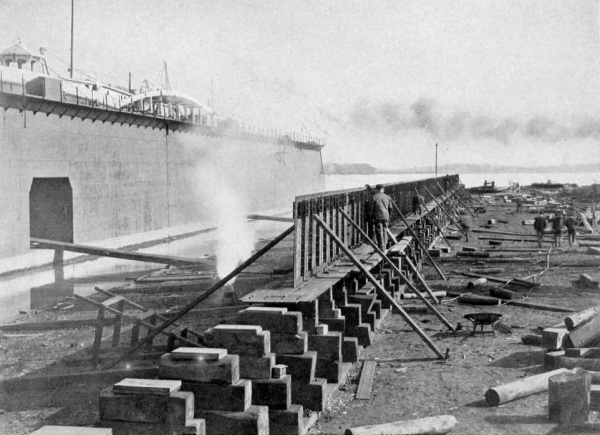
With more than thirty-four millions of people living in the States bordering on them, possessing one third of the total tonnage of North America, and saving to the people of the United States five hundred million dollars each year, or six dollars for every man, woman, and child in the country, one of the most inexplainable mysteries of the century exists in the fact that the Great Lakes of to-day are as little known to the vast majority of Americans as they were a quarter of a century ago. While revolutions have been working in almost all lines of industry, while States have been made and cities born, America’s great Inland Seas have remained unwatched and unknown except by a comparative few. Upon them have grown the greatest industries of the nation, yet the national ignorance concerning them can hardly find a parallel in history. Were they to5 disappear to-morrow the industrial supremacy of the republic would receive a blow from which it could never recover. The steel industry, as a dominant commercial factor, would almost cease to exist. One half of the total population of the country would be seriously affected, and America would fall far behind in the commercial race of the nations.
Notwithstanding these things, not one person in ten knows what the Great Lakes stand for to-day. While a thousand writers have sung of the greatness and romance of the watery wastes that encircle continents, none has told of those “vast unsalted seas” which mean more to eighty-five millions of Americans than any one of the five oceans. What has been written has been for those who find their commerce upon them; for the owners of ships and the masters of men; for the kings of ore and grain—a little statistical matter here and a little there, but nothing for the millions who are not at hand to feel the pulse of traffic or to see the great commercial pageant as it passes before their eyes. Even of those who live in the States bordering the Great Lakes but few know that these fresh-water highways of traffic possess the greatest shipping port in the world, that upon them floats the largest single fleet of freighters in existence, that in their great construction yards shipbuilding has been reduced to a science as nowhere else on earth, and that in their life the elements of romance and tragedy6 play their parts even as on the big oceans that divide hemispheres.
In a small way the general lack of knowledge of the Great Lakes is excusable, for their development has been so rapid and so stupendous that people have not yet grasped its significance. Within the last quarter of a century or less they have become the industrial magnets of the nation. Along their shores have sprung up our greatest cities, with populations increasing more rapidly than those of New York, Boston, Philadelphia, or San Francisco. In the eight States which have ports on them is more than one third of the total population of the North American continent. Along their three thousand three hundred and eighty-five miles of United States shore line will be built this year more than one half of the tonnage constructed in America, and over their highways will travel at least six times as much freight as all the nations of the world carried through the Suez Canal in 1908.
Just what this means it is hard for one to conceive when told only in figures. Perhaps in no better way can the immensity and importance of their traffic be described than by showing briefly one of the ways in which they earned a “dividend” of six dollars for every person living in the United States in 1907. This immense “dividend” did not go into the coffers of corporations, but actually, though indirectly, into the pockets of the people.
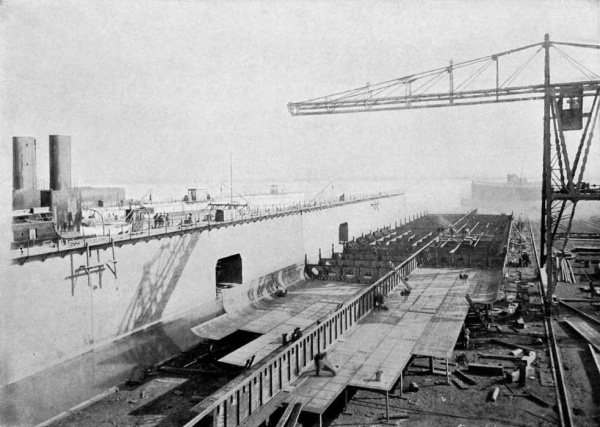
7 It is only fair to the Lakes and the vast interests upon them to use the figures of 1907 instead of those of 1908. In the following pages it is the author’s intention to paint conditions as they actually exist upon our Inland Seas under normal conditions. During 1908, the financial depression that swept over the entire country produced conditions upon the Lakes which, in the author’s opinion, will not be seen again for a great many years to come. “Panic figures” give a wrong impression. Those of 1908 would show a falling off of business in various branches of Lake traffic of from twenty to sixty per cent. As one of the best known vessel-men in Duluth said to me recently, “We can count that the Lakes have lost just one year of progress because of the panic.” In other words, it is highly probable that the business of the Lakes will in this year of 1909 be just about what it should have been under normal conditions in 1908, and there are many who believe that within the next two years the loss of the “panic year” will be more than discounted.
For this reason, in order to show how the Lakes earn their tremendous dividend for the people of the United States, we use the figures of 1907, when traffic was normal. In that year, for instance, it cost a little over ten cents to ship a bushel of grain from Chicago to New York by rail, and only five and one half cents by way of the Lakes and the Erie Canal. This saving on transportation of five cents a bushel8 is divided between the producing farmer and the consuming public. It is a “nickel on which no trust can place its hands”—and this nickel, when multiplied by the number of bushels of grain produced in Ohio, Illinois, Indiana, Wisconsin, Iowa, and Michigan, reaches the stupendous figure of ninety-eight million dollars! In the matter of iron ore the saving is still greater. Were it not for this saving all steel necessities, from rails to common kitchen forks, would advance tremendously in price, and the United States would not be able to control the steel markets of the world. To-day you can ship a ton of ore from Duluth to Ashtabula, Conneaut, or Cleveland, a distance of nearly one thousand miles, for less than you can send by rail that same ton from one of these ports to Pittsburg, a distance of only one hundred and thirty miles. In other words, while it costs about eighty cents to send a ton of ore from the vast ranges of the North to an Erie port by ship, the rail rate is seven times greater, which means that the vessels of the Great Lakes saved in 1907 on ore alone no less than one hundred and seventy-three million dollars!
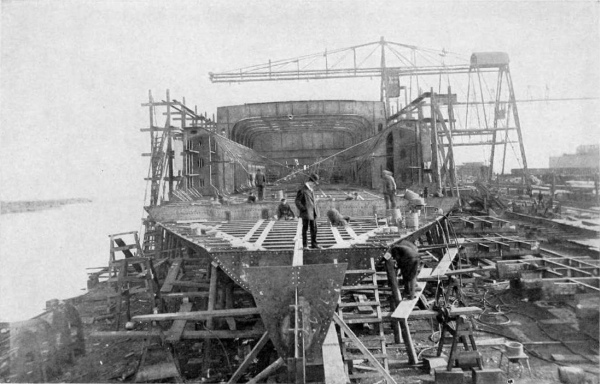
In another way than in this annual saving in cost of transportation are the Lakes fighting a great and almost unappreciated battle for the people. They are to-day the country’s greatest safeguard against excessive railroad charges. They are the governors of the nation’s internal commerce, and will be for all time to come. There is not a State north of the Ohio9 River and east of the Rocky Mountains which is not affected by their cheap transportation, and the day is not distant when hundreds of millions of bushels of grain raised in the Canadian west will go to the seaboard by way of the lake and canal route. At the present time there are about two hundred and forty thousand miles of railroad in the United States, constructed and equipped at a cost of more than thirteen billion dollars; yet, on the basis of ton miles, the traffic on the Lakes will in 1909 be one sixth as great as on all the roads in the country.
These facts are given here to show in a small way the gigantic part the Great Lakes are playing to-day in the industrial progress of the nation. Yet, as paradoxical as it may seem, the nation itself has hardly recognised the truth. The “helping” hand that the Government has reached out has been pathetically weak. In history to come it must be recorded that great men—men of brain and brawn and courage—have “built up” the Lakes, and not the Government. And these men, scores and hundreds of them, are continuing the work to-day. Since the dawn of independence to the present time, the United States has expended for all harbours and waterways on the Great Lakes above the Niagara Falls less than ninety million dollars, yet each year this same Government hands out one hundred and forty million dollars to the army and navy and one hundred and twenty-seven million dollars to the postal service! In the face of this is the astonishing10 fact that, in 1907, the saving in freight rates on Lake Superior commerce alone exceeded by a million dollars the total sum expended by the Government on the Inland Seas since the day the first ship was launched upon them!
In this building of the “greater empire” of the Lake country there is now no rest. Wherever ships are built the stocks are filled. From the uttermost end of Erie to the shipyards of the north—in Buffalo, Lorain, Cleveland, Toledo, Detroit, West Superior, Chicago, and Manitowoc—the making of American ships is being rushed as never before. In the larger yards powerful arc-light systems allow of work by night as well as by day. The roaring of forges, the hammering of steel, the tumult of labouring men, and the rumbling of giant cranes are seldom stilled. With almost magical quickness a ten-thousand-ton monster of steel rises on the stocks—and is gone. Another takes its place, and even as they follow one another into the sea, racing to fill demands, there still comes the cry: “Ships—ships—we want more ships!”
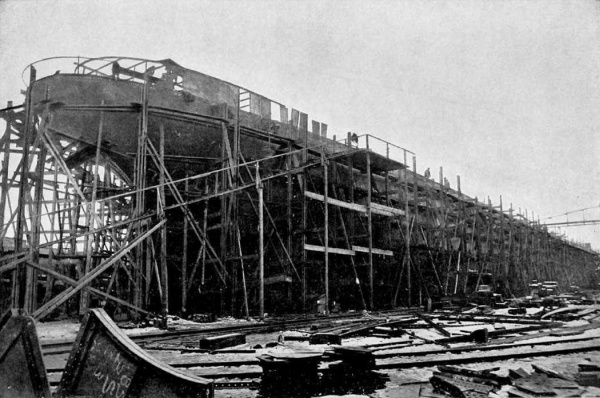
In the year 1908, it is estimated that very nearly three fifths of the total ship tonnage built in the United States was constructed in these busy yards of the Great Lakes. As early as January they were choked with orders for 1908 delivery, and even that early a number of them had orders running well into 1909. A brief glance at the vessel construction of the Lakes during the six years up to and including11 1907 will give a good idea of the rapid growth of this industry along the Inland Seas. In 1902, the product was forty-two vessels, thirty-two of them being bulk freighters. In 1903, forty-two of the fifty vessels built were bulk freight steamers, with a carrying capacity of 213,250 tons. In 1904, the output was only thirteen vessels, but in 1905 twenty-nine bulk freighters with a carrying capacity of 260,000 tons were built. In 1906, there were turned out from the Great Lakes yards forty-seven vessels, of which forty were bulk freighters, and in 1907, the total was fifty-six vessels, including forty bulk freighters, three package freighters, and one passenger steamer. The early months of 1908 saw contracts in force for the construction of twenty-five bulk freighters for delivery before 1909.
Taking the forty bulk freighters built in 1907, one gets a fair idea of the immensity of Lake traffic. They are but a drop in the bucket—a single year’s contribution to the great argosies of the Inland Seas; yet these forty ships have a carrying capacity of three hundred and sixty thousand tons. In other words, within four days after loading at Duluth they could be discharging this mountain of ore at Erie ports. To carry this same “cargo” by rail would require over three hundred trains of thirty cars each, or a single train seventy miles in length!
But this is not particularly astonishing when one is studying the commerce of the Great Lakes. True,12 it represents considerably over a half of the tonnage built in the United States during 1907, but even at that it “isn’t much to shout about,” as one builder of ships said to me. These men of the Lakes never express surprise at the wonders of the Inland Seas. They are used to them. They meet with them every day of their lives. On either coast these same “wonders” would be made much of. But the Lake breed is not the breed that boasts—unless you drag opinions from them. Why, over in Cleveland there is one man who directs the destinies of twice as many ships as the forty-eight mentioned above—a single commercial navy that can move six hundred and forty-eight thousand tons of ore in one trip, or enough to “make up” a train of sixteen thousand two hundred cars, which train would be one hundred and twenty miles in length! This man’s name is Coulby—Harry Coulby, President and General Manager of the Pittsburg Steamship Company, Lake arm of the United States Steel Corporation. There was a time when Coulby was a poor mechanic, working his ten hours a day. Then he developed “talent” and went into a shipyard draughting-room. Now he is undeniably the king of Lake shipping. His word is law in the directing of more than a hundred vessels, the greatest fleet in the world; and it is law in other ways, for it is common talk in marine circles that he (with the trust behind him) is responsible for nearly every important move on the Great Lakes. He is the eye and the13 ear and the mouth of the trust, and it is the trust that practically fixes the ore rates for each season, and does other things of interest. If these ships of Coulby’s were placed end to end they would reach a distance of eight miles! During the eight months of Lake navigation they can transport as much freight over the “thousand-mile highway” as the combined fleets of all nations take through the Suez Canal in twelve! Yet who has heard of Coulby? How many know of the gigantic fleet he controls? A few thousand Lake people, and that is all. A magnificent illustration is this of the national ignorance concerning the Great Lakes.
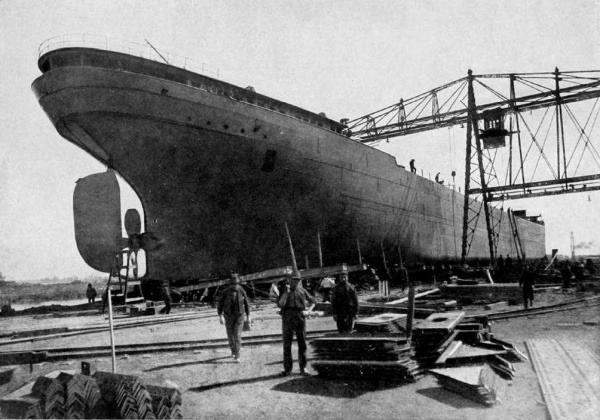
A Monster of Steel and Iron Ready to be Launched.
Weight 9,500,000 lbs.
And Coulby is only one of many. The fleet he controls is only one of many. The Lakes breed great men—and they breed great fleets. How many of our millions have heard of J. C. Gilchrist and the Gilchrist fleet?—a man in one way unique in the marine history of the world, and a fleet which, if plying between New York and Liverpool, would be one of the present-day sensations. Gilchrist, like Coulby, “worked up from the depths,” and to-day, as the head of the Gilchrist Transportation Company, he holds down seventy-five distinct jobs! Seventy-five owners have placed seventy-five ships under his generalship, and from each he receives a salary of one thousand dollars a season, or a total of seventy-five thousand dollars. He is one of the Napoleons of the Lakes. He handles ships and men like a magician; his holds are never14 empty; his dividends are always large. There was a day when one thousand dollars looked like a fortune to Gilchrist, and when eight dollars a week was an income of which he was mightily proud. That was when, from away down in Michigan, he turned his face northward toward the Lakes, filled with big ambition and a desire for adventure, but with little more than what he carried on his back. He got work as a sailor before the mast at forty dollars a month and board. From there he graduated to “bell hop” on a passenger steamer, and continued to graduate until the owners of great ships began to see in him those things which they themselves did not possess, and so handed over to him the destiny of the second greatest fleet of freight carriers in the world.
Such men as Coulby and Gilchrist and the ships they have would make the fame of any nation on the high seas. They and men like Captain John Mitchell, who is the head of a fleet of twenty ships, J. H. Sheadle, G. Ashley Tomlinson, and G. L. Douglas, are of the kind that are choking the Great Lakes shipyards with orders, while along the ocean seaboards stocks are rotting and builders of ocean marine are starving. Cleveland claims the headquarters of both of these immense fleets—and Cleveland is fortunate in many other things. She counts her strong men of the Lakes by the score. She is a great owner of ships, a great buyer of ships, and a great builder.
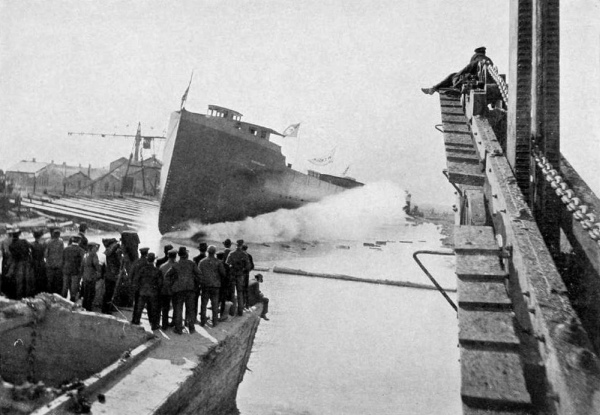
But when it comes to the production of “bottoms,”15 Cleveland and all other Lake cities must give way to Detroit. There was a day when Detroit was one of the important ports of the Lakes, but that day is long past. Now she is the centre of shipbuilding. In 1907, there was built at Detroit more tonnage than in any other city in the United States. Of the vessels launched, twenty-one of the largest took their first dip in or very near Detroit. The tonnage of these vessels aggregated over one half of the total tonnage of the forty freighters constructed for the season’s delivery.
It has been said that Detroit is a great shipbuilding city by accident, and there is a good deal of truth in the assertion. Six years ago the American Shipbuilding Company, the greatest trust of its kind in the world, held undisputed sway over the Lakes. It knew no competition. No combination of capital had dared to grapple with it. With eleven huge construction yards strung along the Lakes between Buffalo, Duluth, and Chicago, it held a monopoly of the shipbuilding industry. It was at this time that one of the country’s great industrial generals sprang up in Detroit. Then he was practically unknown; now as a leader and master of men, he is known in every city of this country where iron and steel are used. His name is Antonio C. Pessano. Detroit must always be proud of this man. He must count in the history of her future greatness, and always her citizens should be thankful that he and his indomitable courage did16 not first appear in Buffalo, Cleveland, or some other Lake city. Mr. Pessano’s ambition was to build at Detroit the most modern shipbuilding plant in the world. Some people laughed at him. Others pitied him. The trust twiddled its fingers, so to speak, and smiled. In the face of it all Mr. Pessano won the confidence of such Gibraltars of industrial finance as George H. Russel, Colonel Frank J. Hecker, Joseph Boyer, William G. Mather, Henry B. Ledyard, and others—won it to the extent of raising one million five hundred thousand dollars, with which he built the greatest shipbuilding yards on the Lakes and which have developed since then into the greatest in America, employing more than three thousand men.
Mr. Pessano’s shipbuilding rival is the president of the trust. His name is Wallace, “son of Bob Wallace, the elder,” Lake men will tell you, for Robert Wallace, the father, was a shipbuilder himself for a great many years. He is very proud of his boy.
“I had three boys,” said he. “Two of ’em went to college, but Jim he wanted an education, so he didn’t take much stock in books, but got out among men. That was what made Jim!”
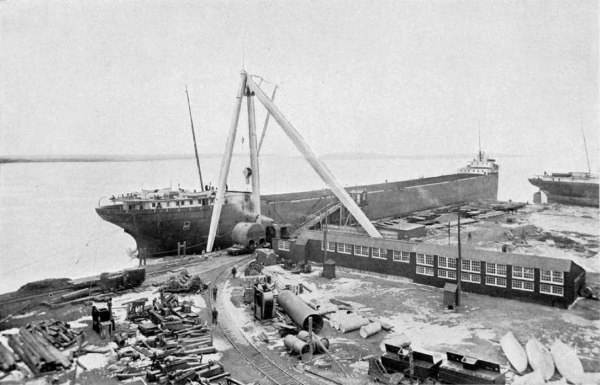
The “Thomas F. Cole,” 11,200 Tons, Being Fitted with Engines and Boilers after her Launching.
The “Cole” is the largest ship on the Lakes. Length, 605 feet 5 inches.
To-day it is “Jim,” or James C. Wallace, of Cleveland, as he is better known, who is the champion shipbuilder of the world. He is President of the American Shipbuilding Company. Probably in no other part of the world is the romantic more largely associated with modern progress than on the Great Lakes, and in17 these two men—Wallace and Pessano—it is revealed in a singular way. Together they govern shipbuilding on the Inland Seas. Both of these great men began in the dinner-pail brigade. They worked in overalls and grease, not for “experience,” but because they had to; they pulled and heaved with common labourers; they rose, step by step, from the lowest ranks—and to-day, monuments to courage and ambition, they are the earth’s two greatest builders of ships. In a novel such characters would be declared almost impossible. But the Lakes breed such as these. There are others whose careers have been even more remarkable, and I will tell of these later—men whose rise from poverty to wealth and power rivals in romance and adventure the most glowing stories of the Goulds and Astors.
Mr. Pessano, “the independent,” does not entirely monopolise Detroit shipbuilding, for Wallace was there ahead of him with one of the trust’s big yards, which is known under the name of the Detroit Shipbuilding Company. It materially assists in the city’s greatness, and will continue to do so more and more each year. During 1907, it launched six big freighters in Detroit, and that city, together with eight other Lake cities, heaps blessings on the trust. For the trust is most generous and unprejudiced in its distribution of yards. It builds ships in one huge yard at Superior, in two at Chicago, two at Cleveland, and in one at Lorain, Buffalo, Wyandotte, Detroit, and Milwaukee. Among these cities it has distributed over fifteen18 million dollars in capital, and it is estimated that it affords a livelihood for between fifty and sixty thousand people. In 1907, the different yards built twice the tonnage of the next two largest shipbuilding concerns in the world combined—those of Doxford and Sons, of Sunderland, and Harland and Wolff, of Belfast, whose aggregate tonnage was not over one hundred and fifty thousand. The astonishing rate at which Lake shipbuilding is increasing is shown in the fact that the trust’s production for 1907 was twice that of 1905, which was 117,482 tons, divided among twenty vessels. A new factor has come into Lake shipbuilding which will count considerably in the future. This is the Toledo Shipbuilding Company, which purchased the Craig yards in 1906, and which has expended a great deal of money since that time in perfecting its plant, until now it has one of the most modern construction yards on the Lakes.
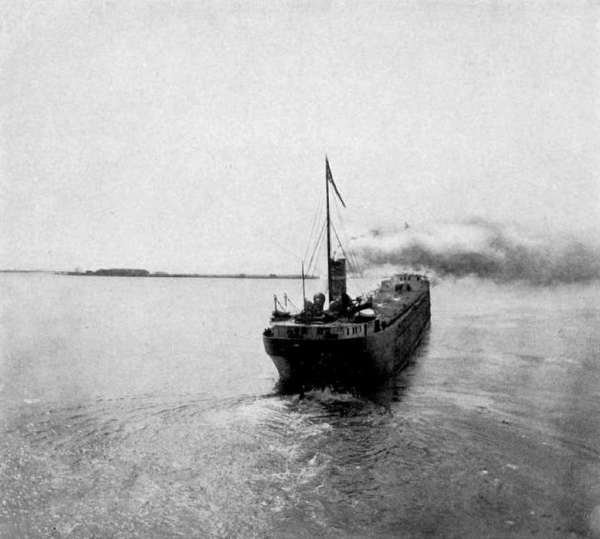
It would seem that this activity in Lake shipyards must soon supply demands, but such will not be the case for many years to come. While the depression of 1908 has cast its gloom, Lake men cannot see the end of their prosperity. They are in the midst of fortune-making days on the Inland Seas. To-day one of the steel ships of the Lakes is as good as a gold mine, and will continue to be so for a quarter of a century to come. The shipyards are growing each year, but the increase of tonnage is outstripping them, and until cargo and ships are more evenly balanced the owners19 of vessels on the Great Lakes must be counted among the most fortunate men in the world.
It is only natural that these conditions should have developed shipbuilding on the Lakes to a science unparalleled in any other part of the earth. I once had the good fortune to talk with a shipbuilder from the Clyde. He had heard much of the Lakes. He had built ships for them. He had heard of the wonders of shipbuilding in their cities. So he had come across to see for himself.
“I had thought that your ships would not compare with ours,” he said. “You build them so quickly that I thought they would surely be inferior to those of the Clyde. But they are the best in the world; I will say that—the best in the world, and you build them like magicians! You lay their keels to-day—to-morrow they are gone!”
This is almost true. A ten-thousand-ton leviathan of the Lakes can now be built almost as quickly as carpenters can put up an eight-room house. Any one of several shipyards can get out one of these monsters of marine commerce within ninety days, and the record stands with a ten-thousand-ton vessel that was launched fifty-three days after her keel was laid! One hardly realises what this means until he knows of a few of the things that go into the construction of such a vessel. Take the steamer Thomas F. Cole, for instance, launched early in 1907 by the Great Lakes Engineering Works. This vessel is the giant of the Lakes, and is six hundred20 and five feet and five inches long. She is fifty-eight feet beam and thirty-two feet deep, and in a single trip can carry as great a load as three hundred freight cars, or twelve thousand tons. In her are nine million five hundred thousand pounds of iron and steel! What does this mean? It means that if every man, woman, and child in Indiana, Michigan, Wisconsin, and Minnesota were to join in carrying this material to a certain place, each person would have to transport one pound. In the mass would be eight hundred thousand rivets, ranging in size from five eighths of an inch to one and one eighth inches in diameter.
One who is investigating Lake shipbuilding for the first time will be astonished to discover that the modern freighter is in many ways a huge private yacht. They are almost without exception owned by men of wealth, and their cabins are fitted out even more luxuriously than those of passenger boats, for while these latter are intended for the use of the public, the passenger accommodations of freighters are planned for the friends and families of the owners. So above the deck which conceals ten thousand tons of ore the vessel may be a floating palace. The keenest rivalry exists between owners as to who shall possess the finest ships, and fortunes are expended in the fittings of cabins alone. Nothing that money can secure is omitted. In the words of a builder: “The modern freighter is like a modern hotel—only much more luxuriously furnished.” There is an electric light system throughout21 the ship; the cabins are equipped with telephones; there is steam heat; there are kitchens with the latest cooking devices, elegantly appointed dining-rooms; there are state-rooms which are like the apartments in a palace, and other things which one would not expect to see beyond the black and forbidding steel walls of these fortune-makers of the Lakes.
With the first peep into modern methods one realises that the romantic shipbuilding days of old are gone. No longer does the shape, beauty, and speed of a vessel depend upon the eyes and hands of the men who are actually putting it together. For the ship of to-day is built in the engineering offices. In the draughting-room skilled men lay out the plans and make the models for a ship just as an architect does for a house, and when these plans are done they go to a great building which reminds one of a vast dance hall, and which is known as the “mould loft.” Seemingly the place is not used. Yet at the very moment you are looking about, wondering what this vacancy has to do with shipbuilding, you are walking on the decks of a ship. All about upon the floor, if you notice carefully, you will see hundreds and thousands of lines, and every one of these lines represents a line of the freighter which within three or four months will be taking her trial trip. Here upon the floor is drawn the “line ship” in exactly the same size as the vessel which is to be built. Over certain sections of this “line ship” men place very thin pieces of basswood, which they22 frame together in the identical size and shape of the ship’s plates. By the use of these moulds, or templates, the workman can see just where the rivet holes should be, and wherever a rivet is to go he puts a little spot of paint. These model plates are then numbered and sent to the “plate department,” where the real sheets of steel are made to conform with them and where the one million five hundred thousand or more rivet holes are punched. With the plates ready, the real ship quickly takes size and form.
Some morning a little army of men begins work where to the ordinary observer there is nothing but piles of steel and big timbers. From a distance the scene reminds one of a partly depleted lumber yard. On one side of this, and within a few yards of the water of a slip, are first set up with mathematical accuracy a number of square timbers called “keel blocks.” Upon these blocks will rest the bottom of the ship, and from them to the water’s edge run long shelving timbers, or “ways,” down which she will slide when ready for launching.
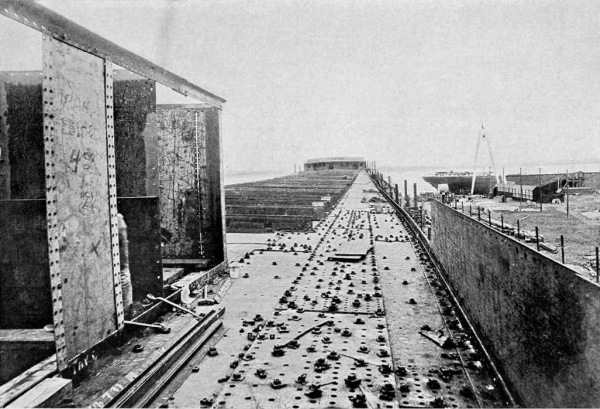
Children frequently play with blocks which, when placed together according to the numbers on them, form a map of the United States. This is modern shipbuilding—in a way. It is on the same idea. There is a proper place for every steel plate in the yards, and the numbers on them are what locate them in the ship. A giant crane runs overhead, reaches down, seizes a certain plate, rumbles back, to hover23 for a moment over the growing “floor,” lowers its burden—and the iron workers do the rest. Within a few days work has reached a point where you begin to wonder, and for the first time, perhaps, you realise what an intricate affair a great ship really is, and what precautions are taken to keep it from sinking in collision or storm. You begin to see that a Lake freighter is what might be described as two ships, one built within the other. As the vessel increases in size, as the sides of it, as well as the bottom, are put together, there are two little armies of men at work—one on the outer ship and one on the inner. From the bottom and sides of the first steel shell of the ship there extend upward and inward heavy steel supports, upon which are laid the plates of the “inner ship.” In the space between these two walls will be carried water ballast. The chambers into which it is divided are the life-preservers of the vessel. A dozen holes may be punched into her, but just as long as only this outer and protecting ship suffers, and the inner ship is not perforated, the carrier and her ten-thousand-ton cargo will keep afloat.
When the construction of the vessel has reached a point where men can work on the inner as well as the outer hull, it is not uncommon for six hundred to eight hundred workmen to be engaged on her at one time. Frequently as high as one hundred gangs of riveters, of four men each, are at work simultaneously, and at such times the pounding of the automatic24 riveting machines sounds at the distance of half a mile like a battery of Gatling guns in action. So the work continues until every plate is in place and the vessel is ready for launching, which is the most exciting moment in the career of the ship—unless at some future day she meets a tragic end at sea. One by one the blocks which have been placed under her bottom are removed, until only two remain, one at each end. Then, at the last moment, these two are pulled away simultaneously, and the steel monster slides sidewise down the greased ways until, with a thunderous crash of water, she plunges into her native element.
Thus ends the building of the ship, with the exception of what is known as her “deck work,” the fitting of her luxurious cabins, the placing of her engines, and a score of other things which are done after she is afloat. She is now a “carrier” of the Lakes. A little longer and captain and crew take possession of her, clouds of bituminous smoke rise from her funnels, and with flying pennants and screaming whistles she turns her nose into the great highway that leads a thousand miles into the North—to the land of the ore kings.
Picture a train of forty-ton freight cars loaded to capacity, the engine and caboose both in New York City, yet extending in an unbroken line entirely around the earth—a train reaching along a parallel from New York to San Francisco, across the Pacific, the Chinese Empire, Turkestan, Persia, the Mediterranean, mid the Atlantic—and you have an idea of what the ships of the Great Lakes carry during a single eight months’ season of navigation. At least you have the part of an idea. For were such a train conceivable, it would not only completely engirdle the earth along the fortieth degree of north latitude, but there would still be something like two thousand miles of it left over. In it would be two million five hundred thousand cars, and it would carry one hundred million tons of freight! Were this train to pass you at a given point at the rate of twenty miles an hour, you would have to stand there forty days and forty nights to see the end of it.
Only by allowing the imagination to paint such a26 picture as this can one conceive to any degree at all the immensity of the freight traffic on our Inland Seas.
“A hundred million tons,” repeated the mayor of one of our Lake ports when I told him about it recently. “A hundred million tons! That’s quite a lot of stuff, isn’t it?”
Quite a lot of stuff! It might have been a hundred million bushels and he would have been equally surprised. His lack of enthusiasm does not discredit him. He does not own ships; neither does he fill them. He is like the vast majority of our millions, who have never given more than a passing thought to that gigantic inland water commerce which has largely been the making of the nation. It did not dawn on him that it meant more than a ton for every man, woman, and child on this North American continent; that in dollars it counted billions; that on it depended the existence of cities; that largely because of it foreign nations acknowledged our commercial prestige.
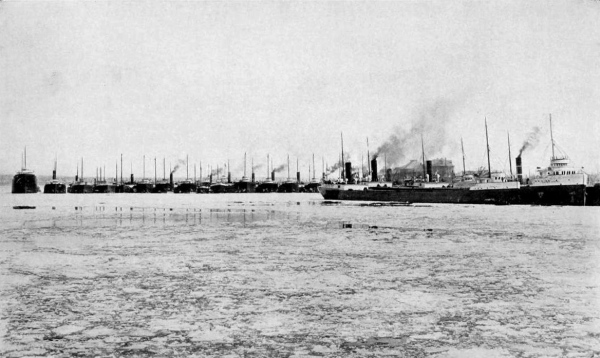
Ice-Bound. Thirty-two Boats Tied up in the Ice at the Soo.
From a Photograph by Lord & Thomas, Sault Ste. Marie, Mich.
No other hundred million tons of freight in all the world is as important to Americans as this annual traffic of the Great Lakes. To move it requires the services of nearly three thousand vessels of all kinds, employing twenty-five thousand men at an aggregate wage of thirteen million dollars a year. A million working people are fed and clothed and housed because of the cargoes this huge argosy carries from port to port.
27 It is impossible to say with accuracy how this hundred million tons of freight is distributed and of what it consists. Only at the Soo and at Detroit are records kept of passing tonnage, so the figures which are given showing the tremendous commerce that passes these places do not include the enormous tonnage which is loaded and emptied without passing through the Detroit River or the Sault Ste. Marie canals. The Detroit River is the greatest waterway of commerce in the world, and in 1906 there passed through it over sixty million tons, or more than three fifths of the total tonnage of the Lakes. Of this about a quarter moved in a northerly direction and three quarters toward the cities of the East. The principal item of the up-bound traffic was 14,000,000 tons of coal, of the south-bound 37,513,600 tons of iron ore, 110,598,927 bushels of grain, 1,159,757 tons of flour, 14,888,927 bushels of flaxseed, and over 1,000,000,000 feet of lumber. In 1907, there was a big increase, the commerce passing through the Detroit River being over 75,000,000 tons.
“And when you are figuring out what the ships carry, be sure and don’t leave out the smoke!” said the captain of an ore carrier, pointing over our port to a black trail half a mile long. “Never thought of it, did you? Well, last year our Lake ships burned three million tons of coal. Think of it! Three million tons—enough to heat every home in Chicago for two years!”
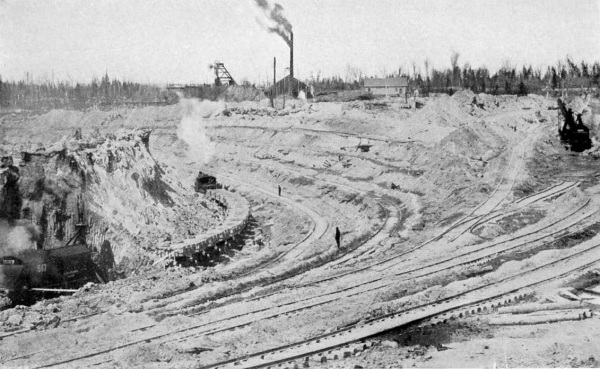
But in this chapter I am not going to deal with smoke; neither with the grain that feeds nations, nor the lumber that builds their homes. They will be described in their time. The backbone of American manufacturing industry—the mainspring of our commercial prestige abroad—is iron; and it is this iron, gathered in the one-time wildernesses of the Northland and brought down a thousand miles by ship, that stands largely for the greatness of the Lakes to-day. “Gold is precious, but iron is priceless,” said Andrew Carnegie. “The wheels of progress may run without the gleam of yellow metal, but never without our ugly ore.” And the Lake country, or three little patches of it, produce each year nearly a half of the earth’s total supply of iron. Farmers in the wake of their ploughshares, our millions of workers in metal, and our other millions whose fingers daily touch the chill of iron have never dreamed of this. Few of them know that eight hundred great vessels are engaged solely in the iron ore traffic; that in a single trip this immense fleet can transport more than three million tons, and that in 1907, they brought to the foundries of the East and South over forty-one million tons. If every man, woman, and child, savage or civilised, that inhabits this earth of ours were to receive equal portions of this one product carried by Lake vessels in 1907, each person’s share would be forty pounds! And still the world is crying for iron. There is not enough to supply the29 demand, and there never will be. The iron ore traffic of the Lakes has doubled during the last six years; it will double again during the next ten—and iron will still be the most precious thing on earth.
If the iron ore mines of the North were to go out of existence to-morrow nearly half of the commerce of the Inland Seas would cease to be. With it would go the strongest men of the Lakes. For our iron has made iron men. In that Northland, along the Mesaba, Goebic, and Vermilion ranges, from Duluth’s back door to the pine barrens of northern Michigan and Wisconsin, they have practically made themselves rulers of the world’s commerce in steel and iron. To follow the great ships of the Lakes over their northward trail into this country is to enter into realms of past romance and adventure which would furnish material for a hundred novels. But people do not know this. The picturesque days of ’49, the Australian fever, and the Klondike rush are as of yesterday in memory—but what of this Northland, where they load dirty ore into dirty ships and carry it to the dirty foundries of the East? Ask Captain Joseph Sellwood; ask the “three Merritts,” Alfred, Leonidas, and N. B.; or John Uno Sebenius, David T. Adams, and Martin Pattison; ask any one of a score of others who are living, and who will tell you of the days not so very long ago when the iron prospectors went out with packs on their backs30 and guns in their hands to seek the “ugly wealth.” These are of the old generation of “iron men”—the men who suffered in the days of exploration and development in the wilderness, who starved and froze, who survived while companions died, who suffered adventures and hardships in the death-like grip of Northland winters that rival any of those in Klondike history. And the new generation that has followed is like them in “the strength of man” that is in them. They are a powerful breed, these iron kings, down to the newest among them; men like Thomas F. Cole, who rose from nothing to a position of power and wealth, and W. P. Snyder, the poverty-stricken Methodist minister’s son, who has fought the Steel Corporation to a standstill and who is talked of as its president of the future.
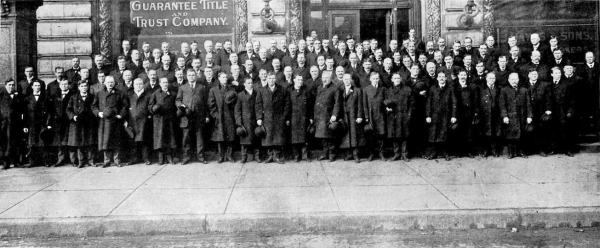
It will be a great “coming together” for the iron and steel industry, this winning of William Penn Snyder. To-day he is the king of pig iron. When he refused to deal with those who formed the United States Steel Corporation, his friends said that he was ruined. But he stood on his feet alone—and fought. He got a neck hold on the corporation. He cornered pig iron and because of him at the present time the corporation is paying very heavy prices for its outside product. Snyder is worth fifteen million dollars. In 1906, he cleaned up one million five hundred thousand dollars on pig iron alone, and there is no reason for doubting that his 1907 earnings were greater31 still. He is a powerful enemy to have as a friend—and the corporation wants him, and will probably get him.
If you are going into the North to study the ore traffic at close range, the first man you will probably hear of after leaving your ship is Thomas F. Cole, of Duluth. You must know Cole before you go deeper into the subject of the forty or fifty million tons of ore which the ships will carry during the present year of 1909. The United States Steel Corporation will use about thirty million tons of the total output of the ore regions this year, and Cole is the United States Steel Corporation in this big Northland. He is the head of the finest and most delicate industrial mechanism in the world. This mechanism, in a way, is so fine that it may be said to be almost non-existent. It is simply an “organized and capitalized intelligence.” The Steel Corporation will mine some eighteen or twenty million tons of ore in Minnesota alone this year. Yet it owns not a dollar’s worth of property in the State. As a corporation it does no business in the State. It might be described as a huge octopus, and each arm of this octopus, representing a big mining interest, works independently of all other arms and of the body of the octopus itself. Through these arms the corporation accomplishes its aims. Each huge mine has its own executive organisation, is responsible for its own acts—but it must obtain results. The “central intelligence,” or body of32 the corporation, is there to judge results, and Cole is the power that watches over all. Officially he is known as the president of the Oliver Mining Company, the greatest organisation of its kind in existence, which attends not only to the Steel Corporation’s interests in Minnesota, but in Michigan and Wisconsin as well. As the great eye of the world’s largest trust he guards the interests of thirty-one mines, employs fifteen thousand men, and gives subsistence to sixty thousand people.
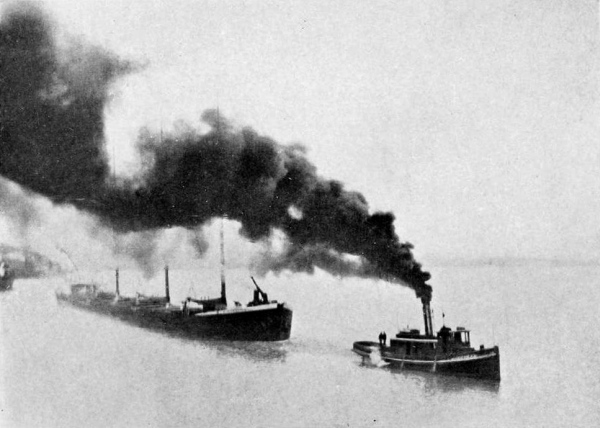
The “Montezuma.”
The largest wooden ship on fresh water being towed out of the Maumee River, Toledo.
Because of the transportation of this mighty product Cole is as closely associated with the Lakes and their ships as with the ranges and their mines. It has been said that he was “born between ships and mines,” and he has always remained between them. He is one of the most remarkable characters of the Inland Seas. Cole is only forty-seven years old, and for thirty-nine years he has earned his own livelihood, and more. When six years old, his father was killed in an accident in the Phœnix Mine. Baby Tom was the oldest of the widowed mother’s little brood, and he rose to the occasion. At the age of eight he became a washboy in the Cliff stamp mill. He had hardly mastered his alphabet; he could barely read the simplest lines; never in this civilised world did a youngster begin life’s battle with greater odds against him. But even in these days the great ambition was born in him, as it was born in Abraham Lincoln; and like Lincoln, in his little wilderness home of poverty and33 sorrow, he began educating himself. It took years. But he succeeded.
This is the man whose name you will hear first when you enter the mining country. To chronicle his rise from a dusty Calumet office of long ago to his present kingdom of iron would be to write a book of romance. And there are others of the iron barons of the North whose histories would be almost as interesting, even though fortune may have smiled on them less kindly.
From the immensity of the interests which Cole superintends one might be led to believe that the iron ore industry is almost entirely in the hands of the trust. This, however, is not so. For every ship that goes down into the South for the trust another leaves for an independent. Nearly every maker of steel owns a mine or two in the ranges of Minnesota, Michigan, or Wisconsin. There are five of these ranges. The Mesaba and Vermilion ranges, both in Minnesota, produce about two thirds of the total product carried by the ships of the Lakes; the Goebic, Menominee, and Marquette ranges are in Michigan and Wisconsin.
Somehow it is true that nearly every great thing associated with the Lakes is unusual in some way—unusual to an astonishing degree, and the iron ore industry is not an exception. Probably not one person in ten thousand knows that one lone county in this great continent is the very backbone of the steel industry in the United States. This county is in34 Minnesota. It is the county of St. Louis, and is about as big as the State of Massachusetts. Not much more than twenty years ago it was a howling wilderness. Even a dozen years ago the Mesaba bore but little evidence of the presence of man. Now this country is alive with industry. Buried in the wilderness which still exists are thriving towns; where a short time ago deer and bear wandered unmolested, is now the din of innumerable locomotives, the rumbling of thousands of trains, the screeching of whistles, and the constant groaning of steam shovels. There is not a richer county on the face of the earth. In it are over one hundred mines, from which one hundred and twenty-three million tons of ore have been taken since Charlemagne Tower, now Ambassador to Germany, brought down the first carload to Duluth in 1884. These mines afford livelihood for more than two hundred thousand people, and because of them St. Louis County possesses the greatest freight traffic road in existence—the Duluth, Mesaba, and Northern Railway—which, in 1907, carried about fourteen million tons of ore from the mines to the docks.
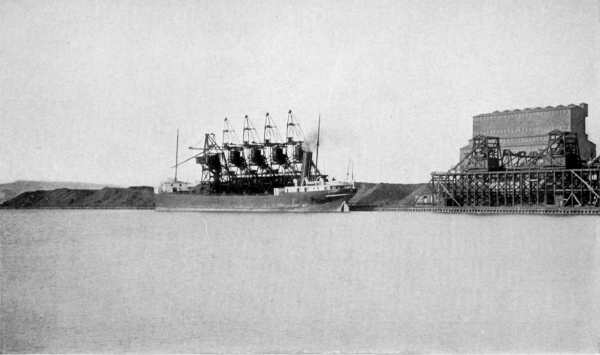
A Coal Dock at Superior, Wisconsin.
The pile of coal is 1400 feet long and 30 feet high.
This comparatively little corner of Minnesota practically runs the whole State in so far as expenses are concerned. To administer the affairs of the State, including all of its activities, costs about two million six hundred thousand dollars, and, as inconceivable as it may seem, the three railroads in the ore region pay in taxes one fifth of this sum. They pay one35 third of the total railroad tax of the State, notwithstanding the fact that some of the greatest lines in the country centre at Minneapolis and St. Paul. To this must be added about seven hundred thousand dollars paid in direct taxes by the mines themselves, so that the iron ore which the ships of the Lakes bring down to Eastern ports each season pays almost half of the total expense of running the State of Minnesota!
And these mines will add more and more to the State exchequer each year, as will also the mines of the three ranges in Michigan and Wisconsin. For in no part of the world has mining been undertaken on a scale so gigantic as that of the Superior region, and every contrivance known to mining science is being used to increase month by month the mountains of ore which ever fail to satisfy the hungry furnaces of the East. It is predicted by Captain Joseph Sellwood, of Duluth, one of the oldest and greatest of the iron barons, that the time is not distant when the Mesaba range alone will be producing forty million tons of ore a year—as much as all five ranges are producing now.
“It will cost over a billion dollars to get this ore to the docks,” said he. “And seven hundred and fifty million dollars more to land it in Lake Erie ports.”—Nearly a two-billion-dollar mining and transportation business for the people of the Lakes to look forward to, and this from a single range!
“But will not this tremendous activity exhaust36 your mines?” I asked of several of these iron barons. “The ore doesn’t go down to China, and it doesn’t extend all over the State. What is the future?”
The future! Few have thought of this. There are just at present too many millions of dollars in the making to give one time or inclination to picture the days when only black and silent scars will remain to give evidence of the time when this Northland was one of the treasure houses of the earth. But that time must come. Old mining men say so if you can get them to talk about it, and scientific computations, as far as they go, are proof of it. These computations differ, but they agree pretty generally that there are still between a billion and a half and two billion tons of ore in the Superior district. Within the next five years the ships will be bringing down fifty million tons a year, and there is no reason for believing that this will be the maximum. So it is obvious that the ore of the Lake Superior regions will not last beyond the year 1950 unless new deposits are discovered, or methods are found for the utilisation of immense deposits that cannot now be used.
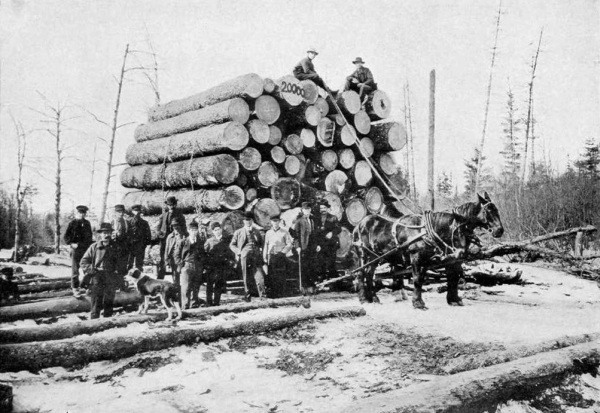
“Will this event not prove ruinous to a large extent to shipping interests?” I asked G. Ashley Tomlinson, of Duluth, and others closely associated with iron and vessel interests. “To-day nearly half of the total tonnage of the Lakes is from the mines. If this industry becomes practically extinct what will become of the hundreds of ships engaged in the traffic?”
37 Mr. Tomlinson’s answer struck me as extremely logical. “The production of ore will probably reach its maximum within the next ten years,” he said. “It will then begin to decline. But the decrease will be gradual, and meanwhile other freight traffic on the Lakes will be increasing so rapidly that each year ships that were intended originally for the ore trade will carry other business. There will be no loss for the ships. The development of our own and the Canadian West has only begun, and the Lakes are the great links of commerce between their vast enterprises of the future and the East. The grain trade of the Canadian West alone will in the not distant future be something tremendous.”
But whatever the future of the ore regions of the North may be, their present is one of great interest and importance to the world at large. Mining, like shipbuilding, has been reduced to a science on the Lakes. A stranger visiting for the first time any one of the five ranges is filled with astonishment. I will never forget the sensations with which I first saw mining on the Mesaba range. We had come up over a forest-clad hill and stood on the very edge of the mine before I had been made aware of its nearness. Below me there stretched a mile of deep, huge scars in the bottom of what seemed to be a great hole dug into the earth. One of these pits, half a mile in diameter, and, as I afterward discovered, nearly two hundred feet in depth, was almost at my feet.
38 “That’s iron ore,” said my companion. “And right there it goes one hundred feet deeper down.”
This was one of the great “open pits” of the Mesaba range. There are many others like it in the Superior regions. They are the most wonderful mines in the world. Imagine that you take a barrel of salt, dig a hole, pour the salt into this hole, and cover it with a few inches of earth. This gives you an idea of one of these ore mines. After the earth has been “stripped” from the top the ore is reached and it is found in much the same way that the salt would be found. In the words of one superintendent, it is “all together.” It is as if Nature, like a pirate, had dug holes here and there in which she had hidden her treasure, covering it over for concealment with a few feet of earth.
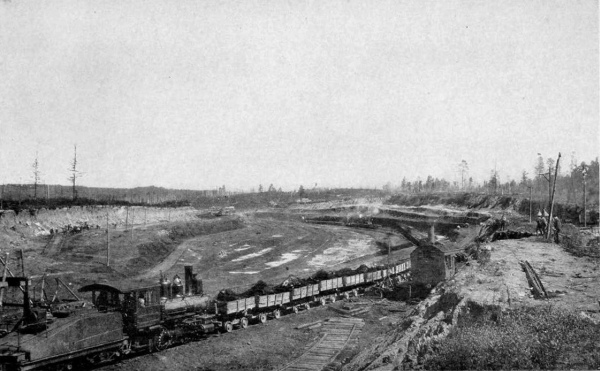
Down into these pits and along their edges run the tracks of the ore cars. There is here but little of the shovelling and “picking” of men. Steam shovels, weighing from sixty to seventy-five tons each, do the work. Like a great hand one of these shovels dips down into the soft mass of ore, buries its great dipper until it holds from four to eight tons, and then, groaning and rumbling, slowly lifts its burden aloft, swings it over a car, and the actual work of mining is done. A thousand times a day it will repeat this operation, lifting from three thousand to eight thousand tons of ore. This one shovel keeps busy three locomotives and as many trains of dump cars. And there are nearly two hundred of these shovels in use on the39 Mesaba range alone. It costs only about six cents a ton to mine in this way, after the “stripping” has been done, or, in other words, after the ore has been laid bare. There are two other processes on the ranges where the ore is not so soft or so closely laid. One of these is the milling process, and the other is the blasting out of hard ore. Milling costs about thirty-five cents per ton, and the blasting process from one dollar to one dollar and twenty-five cents.
Why it has for some time been impossible to build ships too fast for the demand may most graphically be shown, perhaps, by quoting a few figures which demonstrate the tremendous energy now being exerted in the ore regions of the North. Figures as a usual thing are uninteresting, but these enter so vitally into the welfare of every American citizen that they should be regarded with more than ordinary respect. As stated before, we are now making nearly half of all the iron and steel produced on earth. In 1880, we made only 1,240,000 tons of steel; in 1890, this had increased to over 4,000,000; in 1900, to 10,188,000 tons, and in 1905, to 20,023,000 tons. Lake ships and Lake mines had to supply this. And now we come to mine figures which almost stagger belief. In 1904, the Mesaba range, for instance, yielded only a little over 12,000,000 tons. In the following year the production was nearly doubled, the ore carriers bringing down 20,153,699 tons, which in 1906 was increased to almost 24,000,000!
40 This enormous annual tonnage of the Mesaba range, together with that of the other four ranges of the Superior region, is carried by rail directly from the mines to the great ore docks of Lake ports. The product of the Mesaba and Vermilion ranges, in Minnesota, is shipped from Duluth and Two Harbors; the eight million tons of the Goebic and Marquette ranges, in Michigan, from Escanaba and Marquette; and the five million tons of the Menominee range, in Wisconsin, from Ashland and Superior.
To these six ports of the Northland come the vikings of the Lakes and their immense fleets. Four of these ports are within a radius of seventy-five miles, and the two others, in Michigan, are about one hundred and fifty miles farther east and south. No other area of lake or ocean in the world is as much travelled by shipping as that along which these ore harbours are situated. The people of Duluth have witnessed blockades of vessels such as have never been seen in the greatest ocean ports. Over this part of Superior there is a constant trail of smoke from the funnels of ships. During one month there were 1221 arrivals and clearances from Duluth alone, an average of forty a day.
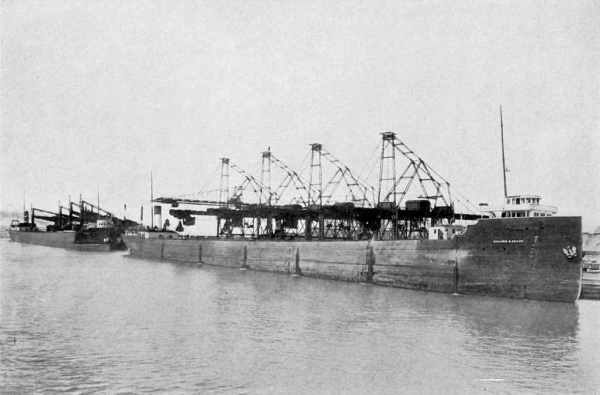
Behind these great ships, which rest never a day nor an hour for eight months of the year, are the kings of Lake commerce—such men as J. C. Gilchrist, James Davidson, Captain Mitchell, William Livingstone, Harry Coulby, W. C. Richardson, A. B. Wolvin, G. Ashley41 Tomlinson, and scores of others. To write of these would be to chronicle a history of men who have fought their way to the top through sheer force of the “breed that is in them.”
Take G. Ashley Tomlinson, of Duluth, for instance, whose ships carry a couple of million tons of ore a year. “Not a great record,” as Mr. Tomlinson modestly says, but still enough to supply every man, woman, and child in the United States with a little matter of fifty pounds each twelvemonth! In a novel Tomlinson would make an ideal soldier of fortune; in plain, matter-of-fact life he represents those elements which make the great men of the Lakes. He is forty years old. He has sixteen ships. His income is over one hundred and fifty thousand dollars a year.
Yet Tomlinson began, as did many other Great Lake men of to-day, with just two assets—the clothes on his back and a huge ambition. He started his career as a messenger boy in the State treasurer’s office at Lansing, Michigan. But there was not enough of the strenuous life in this for him, so he went West to become a cowboy. He succeeded, much to his regret; for soon after he had mastered the broncho and could handle a lasso there came the war between the cowboys and the White River Utes. In one of the fights Tomlinson was wounded and afterward captured by the redskins. During the whole of one night he was subjected to torture, and at dawn of the following day, when almost at the point of death, he was delivered42 by a party of ranchmen. Tomlinson was not one to display the white feather—but he had had enough of Western life, and as soon as possible he worked himself from Rawlins, Wyoming, to Chicago on a cattle train. After a time he came to Michigan, and with his savings attended the University of Michigan for about a year. This was enough of “higher education” for him, so he sold his text-books and went to work on the Detroit Journal at the munificent salary of six dollars a week. Newspaper work was all right until Buffalo Bill came along. Tomlinson joined the show, rode a bucking broncho for a year, then “developed” a voice and cast his fortunes with the Mapleson Opera Company. In 1889, he went to New York as a reporter on the Sun, returned the following year to become night editor of the Detroit Tribune, and in 1893 moved to Duluth.
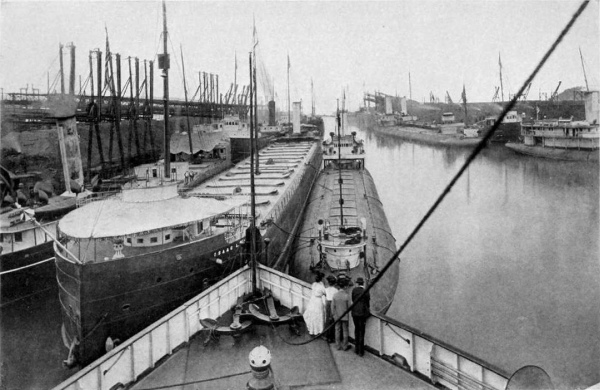
The Main Slip in the Harbour of Conneaut.
Conneaut is the second largest ore-receiving port on the Lakes.
The Lakes began to hold a peculiar fascination for him. He went into the vessel brokerage business mostly on his nerve; but nerve made him money, and his capital began to grow. How fast it has grown during the past dozen years one must judge by his ships and his income. He is president of five steamship companies, vice-president of another, secretary to three more, and a director in the American Exchange Bank, of Duluth, and the Cananea Central Copper Company. He has developed from a typical adventurer of fortune into one of the great men of the Lakes. His romantic career is described here because43 it is illustrative of the fact that brain and brawn, not “pull” and money, have made the vikings and iron barons of the Inland Seas. No millionaires’ sons here, living on their fathers’ prestige—no blue-blooded drones in these regions of the five little seas, where only red blood counts!
When the first ships of the season come up from the South in April or May nearly a million and a half tons of ore are awaiting them in the docks of the ore-shipping ports. There are twenty-six of these ore docks, one of which, at Duluth, has a storage capacity of ninety-six thousand tons. From a distance these docks look like great trestles, from fifty to one hundred feet above the water, some of them running for nearly half a mile out into the lake. Out upon these docks run the cars from the mines. From these cars the ore is dropped into huge pockets, from which run downward long chutes, or spouts. A ten-thousand-ton carrier runs alongside. Her hatches are opened. Into each hatch runs a chute. The chute “doors” are opened, and with a dull, rumbling, rushing sound the ore pours down by force of gravity from the huge pockets above. At dock No. 4, Duluth, 9277 tons were put aboard the steamer E. J. Earling in seventy minutes, being at the rate of 7988 tons an hour. The rapidity with which Lake transportation is carried on is shown in the fact that upon this occasion the Earling was in port only two hours and fifteen minutes before she began her thousand-mile return trip eastward.
44 And now comes the last important phase. One viewing the continuous activity at the mines, the building up of cities on the ranges, and the tremendous interests represented in the great shipping ports may forget that this is but one end of the gigantic industry which makes the United States the steel-maker for the world. At the other end of the fresh-water highways is seen the other half of the picture. Down into Erie come the ships from the North. A few of them go to Chicago, but only a few. Out of a total movement of thirty-seven million tons, in 1906, thirty-two million tons were received at Lake Erie ports. There are eleven of these “receiving ports”—Toledo, Sandusky, Huron, Lorain, Cleveland, Fairport, Ashtabula, Conneaut, Erie, Buffalo, and Tonawanda.
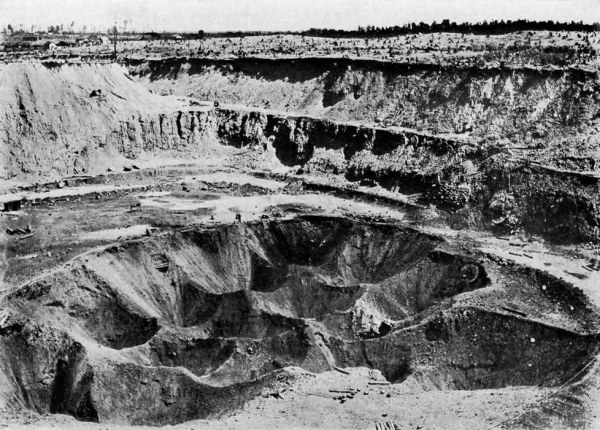
Between these cities there is a constant battle for prestige. Now one leads in tonnage received, now another. At the present time the bitterest rivalry exists between Cleveland, Ashtabula, and Conneaut, the three greatest ore ports in the world. In 1901, Ashtabula led. In 1902, Cleveland bore away the “pennant,” with Ashtabula and Conneaut second and third. Cleveland was still ahead in 1903, but in 1904, Conneaut became the greatest ore-receiving port in the world. In 1905, Ashtabula had again won the ascendency, and in 1906, she maintained her prestige, receiving in that year 6,833,352 tons; Cleveland was second, and Conneaut third. Lorain, Fairport, Ashtabula, Conneaut, and Erie practically exist because45 of the ore which comes down from the northern mines. Seven million dollars are now being expended in the improvement of Ashtabula harbour by the Lake Shore and Pennsylvania railroad companies, and the capacity of the harbour has been doubled since 1905. With the improvement of that harbour Conneaut’s greatest advantage will be gone, for until a comparatively recent date nearly all of the largest vessels went to that port. The tremendous activity in Ashtabula must be seen to be fully appreciated. In one day lately almost four thousand ore and coal cars were moved between that port and Youngstown.
At this end of the great ore industry the wonderful mechanism for the handling of cargoes is even more astonishing than that of the Northland. The ore carrier is run under a huge unloading machine which thrusts steel arms down into the score or more hatches of the vessel, and without the assistance of human hands the cargo is emptied so quickly that the uninitiated observer stands mute with astonishment. How quickly this work is done is shown in the record of the George W. Perkins, which discharged 10,346 tons at Conneaut in four hours and ten minutes.
Once more, after this unloading, the steel monster of the Lakes is all but ready for her long journey into the North. Within a few hours she is reloaded, with a few sonorous blasts of her whistle she bids a last adieu, and again she is off on the long trail that leads to the “ugly wealth” in the ore ranges of Superior.
Not long ago I went to see William Livingstone, President of the Lake Carriers’ Association—Great Admiral, in a way, of the world’s mightiest fleet of steel—an enrolled navy of 593 ships and a tonnage of nearly one million nine hundred thousand. Unconsciously I had come to call this man the Grey Man and the Man who Knows. Both titles fit, as they will tell you from the twin Tonawandas to Duluth. For six consecutive years president of the greatest organisation of its kind on earth, an association of ships made up, if weighed, of half of the iron and steel floating on the Inland Seas, he has become a part of Lake history. I sought him for an idea. I found it.
The Grey Man was at his desk studying over the expenditure of a matter of several millions of dollars for a new canal at the “Soo.” He turned slowly—grey suit, grey tie, grey eyes, grey beard, grey hair—all beautifully blended. He seldom speaks first. He is always fighting to be courteous, yet the days are ten hours too short for him.
47 “I want a new idea,” I opened bluntly. “I want something new in marine—something that will make people sit up and take notice, as it were. Can you help me?”
He swung slowly about in his chair until his eyes rested upon a picture on the wall. It was a picture of the old days on the Lakes. My eyes, too, rested on the old picture. It reminded me of things, and I kept pace with the thoughts that might be his. I saw him, more than half a century before, the stripling son of a ship’s carpenter, swimming in the shadows of the big fore-’n’-afters that were monarchs before steam came—glorious days when ninety-eight per cent. of vessels carried sail, and sailors dispensed law with their fists and bore dirks in their bootlegs. Later I saw the proud moment of his first trip to “sea”—and then, quickly, I noted his rise: his saving dollar by dollar until he bought an interest in a tug, his monopolisation of it later, his climb—up—up—until——
“I’m busy, very busy!” he broke in quietly. “But say, did you ever think of this? Did you ever build a city of the lumber we carry each year, populate that city, feed it with the grain we carry, and warm it with our coal? You can do it on paper and you will be surprised at what you find. It will show you more graphically than anything else just what the ships carry. Try it. You’ll be interested.”
I have kept that idea warm. Now I am going to48 use it. For probably in no better way can the immensity of the lumber, grain, coal, flour, and package freight traffic of the Great Lakes be given. Imagine, then, this “City of the Five Great Lakes.” We will build it, we will people it, feed it, and heat it—and our only material, with the exception of its inhabitants, will be the cargoes of the Lake carriers for a single season. And these carriers? If you should stand at the Lime Kiln Crossing, in the Detroit River, one would pass you on an average every twelve minutes, day and night, during the eight months of navigation; and when you saw their number and size you would wonder where they could possibly get all of their cargoes. The cargoes with which we will deal in this article will be of lumber, grain, flour and coal, for these, with iron ore, constitute over ninety per cent. of the commerce of the Inland Seas.

To build our city we first require lumber. During the 1909 season of navigation about 1,500,000,000 feet of this material will be carried by Lake ships. What this means it is hard to conceive until it is turned into houses. To build a comfortable eight-room dwelling, modern in every respect, requires about 20,000 feet of lumber, and when we divide a billion and a half by this figure we have 75,000 homes, capable of accommodating a population of about 400,000 people. With the thousands of tons of building stone transported by lake each year, the millions of barrels of cement, the cargoes of shingles, sand, and brick, our49 “City of the Lakes” for 1909 would be as large as Buffalo, Cleveland, or Detroit.
But one does not begin fully to comprehend the significance of the enormous commerce of the Great Lakes, and what it means not only to this country but to half of the civilised world, until he begins to figure how long the grain which will be carried by ships during the present year would support this imaginary city of 400,000 adult people. There will pass through the “Soo” canals this year at least 90,000,000 bushels of wheat and 60,000,000 bushels of other grain, besides 7,500,000 barrels of flour, all of which represents the “bread stuff” that is shipped from Lake Superior ports alone. There will, in addition, be shipped by lake at least 50,000,000 bushels from Chicago, Milwaukee, and other ports whose eastbound commerce is not reported at the “Soo.” In short, estimating conservatively from the past four years, it is safe to say that at least 200,000,000 bushels of grain and 11,000,000 barrels of flour will have been transported by the Great Lakes marine by the end of this year’s season of navigation.
But what do these figures mean? They seem top-heavy, unwieldly, valuable perhaps to the scientific economist, but of small interest to the ordinary everyday eater of bread. Let us reduce this grain to flour. It takes from four and a half to five bushels of grain for a barrel of flour and dividing by the larger figure our grain would give us 40,000,000 barrels, which,50 plus the 11,000,000, would make a total of 51,000,000 barrels. Now we come right down to dinner-table facts. At least 250 one-pound loaves of bread can be made from each 196-pound barrel of flour, or a total of 12,750,000,000 from the whole, which would mean at least five loaves for every man, woman, and child of the two and one half billion people who inhabit this globe! In other words, figuring from the reports of food specialists, the grain and flour carried by the ships of the Lakes for one year would give the total population of the earth a food supply sufficient to keep it in life and health for a period of two weeks!
This enormous supply of the staff of life would give each of the 400,000 bread-eating people in our “City of the Lakes” a half-pound a day for one hundred and seventy-five years, or it would supply a city of the size of Chicago with bread for fifty years! To each of the 60,000,000 bread-eaters in the United States it would give 212 one-pound loaves, or, with an allowance of half a pound for each person per day, it would feed the nation for one year and two months!
Now, having built our city, peopled it, and supplied it with food, we come to the point of heating it. In 1907, there were transported by Lake nearly 15,000,000 tons of coal, and this year another million will probably be added to that figure. Here again mere figures fail to tell the story. But when we come to divide this coal among the homes of a city like Cleveland, Detroit, or Buffalo, which rank with our 75,000-home “City51 of the Lakes,” we again come to an easy understanding. Each of these 75,000 home-owners would receive as his share over 213 tons of coal, and if he burned six tons each winter this would last him for thirty-five years!
In a nutshell, there is enough lumber and other material carried by Lake ships each year to build a city the size of Detroit; there is enough grain transported to supply its 400,000 inhabitants with bread-stuffs for a period of one hundred and seventy-five years, conceding the total population of the city to be adults; and enough coal is shipped from Erie ports into the North to heat the homes in this city for thirty-five years!
When one knows these facts, when perhaps for the first time in his life he is brought to a realisation of the enormous proportions of the commerce of the Inland Seas, he may, and with excellent excuse, believe that he has reached the limit of its interest. But as a matter of fact he has only begun to enter upon its wonders, and the farther he goes the more he sees that economic questions which have long been mysteries to him are being unravelled by the Great Lakes of the vast country in which he lives.
“Because of the ships of our Inland Seas,” James A. Calbick, late President of the Lumber Carriers’ Association, said to me, “the people of the United States, from the Atlantic Ocean to the Rocky Mountains, and as far south as Kentucky and Tennessee,52 have been able to build the cheapest homes in the world—and the best,” and this assertion, which can be proved in several different ways, brings us at once to the lumber traffic as it exists on the Lakes to-day.
Going through almost any one of the Eastern and Central States one will find thousands of old sheds and barns, travelling the road to ruin through age alone, though built of the best of pine and oak—materials of a quality which cannot be found in the best of modern homes in this year of 1909. For ten years past the price of lumber has been steadily climbing, and since 1900 the increase in the cost of building construction has brought lumber to a par with brick. While the commerce of the Lakes is increasing by tremendous bounds in other ways, people are now, perhaps unknowingly, witnessing the rapid extinction of one of their oldest and most romantic branches of traffic—the lumber industry; and each year, as this industry comes nearer and nearer to its end, the price of lumber climbs higher and higher, home-owners become fewer in comparison with other years, and fleets and lumber companies go out of existence or direct their energies into other channels.
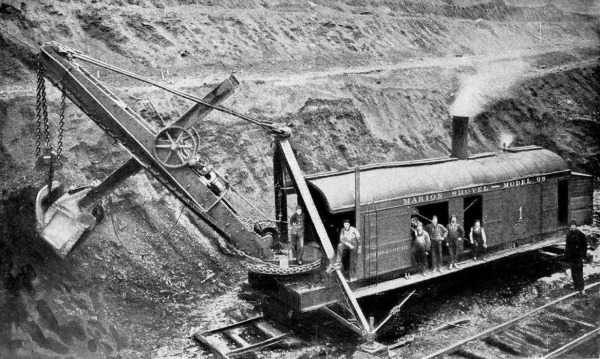
Scooping up Ore from the Mahoning Mine at Hibbing.
The largest open pit mine in the world.
To Lake people it is pathetic, this death of the lumber fleets of the Inland Seas. An old soldier who had sailed on a lumber hooker since the days of the Civil War once said to me, “They’re the Grand Army of the Lakes—are those old barges and schooners, and53 they’re passing away as fast as we old fellows of the days of ’61.” To-day no vessels are built along the Lakes for the carrying of lumber. Scores of ancient “hookers” and picturesque schooners of the romantic days of old are rotting at their moorings, and when a great steel leviathan of ten thousand tons passes one of these veterans the eyes of her crew will follow it until only her canvas remains above the horizon.
Yet from the enormous quantity of lumber which will be transported by Lake during the present year, one would not guess that the great fleet which will carry it is fast nearing the end of its usefulness in this way. In every lumbering camp along the Lakes, in the great forests of Minnesota, and in the wilderness regions of Canada, unprecedented effort has been expended in securing “material” because of the high prices offered, and the result has been something beyond description. Recently I passed through the once great lumbering regions of the Lakes to see for myself what I had been told. Michigan is stripped; the “forest” regions of Georgian Bay are scrub and underbrush; for hundreds of square miles around Duluth the axe and the saw have been ceaselessly at work, though there is still a great deal of timber land in the northern part of the State. In the vast lumber regions of a decade ago, once lively and prosperous towns have become almost depopulated. Scores of lumbering camps are going to rot and ruin; saw-mills are abandoned to the elements, and in places where lumbering54 is still going on, timber is greedily accepted which a few years ago would have been passed by as practically worthless. A few years more and the picture of ruin will be complete. Then the lumber traffic on the Great Lakes will virtually have ceased to be, the old ships will be gone, and past forever will be the picturesque life of the lumberjack and those weather-beaten old patriarchs who, since the days of their youth, have been “goin’ up f’r cedar ’n’ pine.”
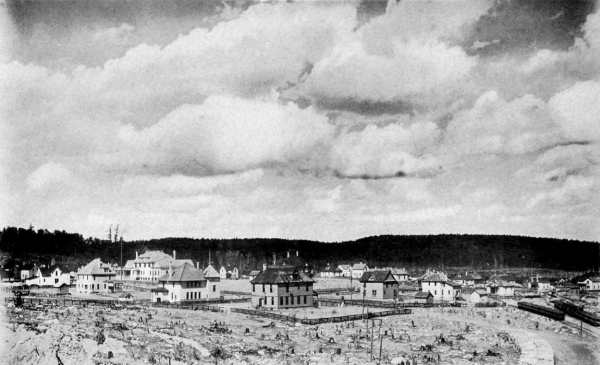
But even in these last days of the lumber industry on the Lakes the figures are big enough to create astonishment and wonder, and give some idea of what that industry has been in years past. Take the Tonawandas, for instance—those two beautiful little cities at the foot of Lake Erie, a few miles from Buffalo. Lumber has made these towns, as it has made scores of others along the Lakes. They are the greatest “lumber towns” in the world, and estimating from the business of former years there will be carried to them by ship in 1909 between 300,000,000 and 400,000,000 feet of lumber. In 1890, there entered the Tonawandas 718,000,000 feet, which shows how the lumber traffic has fallen during the last nineteen years. It is figured that about 10,000,000 feet of lumber, valued at $200,000, is lost each year from aboard vessels bound for the “Twin Cities.” In 1905, the vessels running to the Tonawandas numbered 300; this year their number will not exceed55 250—another proof of the rapidly failing lumber supply along America’s great inland waterways.
“This talk of a lumber famine is all bosh,” I was informed with great candour a short time ago. “Look at the great forests of Washington and Oregon! Think of the almost limitless supply of timber in some of the Southern States! Why, the stripping of the Lake States ought not to make any difference at all!”
There are probably several million people in this country of ours who are, just at the present moment, of the above opinion. They have never looked into what I might call the “economy of the Lakes.” A few words will show what part the Lakes have played in the building of millions of American homes. At this writing it cost $2.50 to bring a thousand feet of lumber from Duluth to Detroit aboard a ship. It costs $5.50 to bring that same lumber by rail! Conceding that this year’s billion and a half feet of lumber will be transported a distance of seven hundred miles, the cost of Lake transportation for the whole will be about $3,750,000. The cost of transportation by rail of this same lumber would be at least $7,500,000, or as much again! Now what if you, my dear sir, who live in New York, had to have the lumber for your house carried fourteen hundred miles instead of seven, or three thousand miles, from Washington State? To-day your lumber can be brought a thousand miles by water for $3 per thousand feet; by rail it would cost you $7! And this, with competition playing a tremendous part in the game.56 When lumber is gone from the Lake regions, will our philanthropic railroads carry this material as cheaply as now, when for eight months of the year they face the bitter rivalry of our Great Lakes marine?
“When the time comes that there is no more lumber along the Lakes, what will be the result?” I asked Mr. Calbick, the late President of the Lumber Carriers’ Association. He replied:
“Lumber will advance in price as never before. No longer will the frame cottage be the sign of the poor man’s home; no longer will the brick mansion be the manifestation of wealth. It will then cost much more to build a dwelling of wood than of brick or stone. The frame house will in time become the sign of aristocracy and means. It will pass beyond the poor man’s pocket-book, and while this poor man may live in a house of brick it will not be his fortune to live in a house of wood. That is what will happen when the lumber industry ceases along the Great Lakes.”
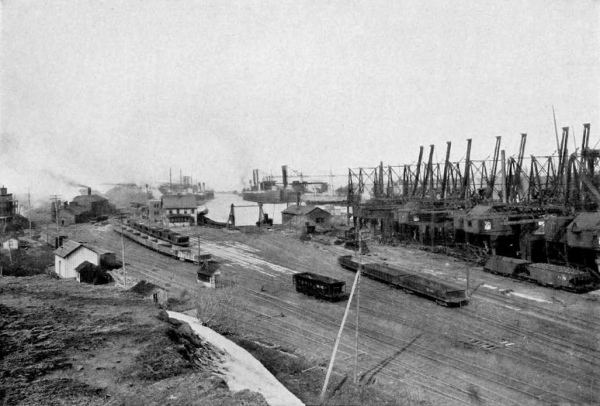
Then this great lumberman went on to say:
“People are beginning to see, and each year they will see more plainly, how absolutely idiotic our State and National governments have been in not compelling forest preservation. For all the centuries to come Michigan, Wisconsin, and Minnesota should be made to supply the nation with timber. In these three Lake States there are millions of acres of ideal forest land which is good for nothing else. Yet for at least half a century must these millions of acres now remain57 worthless. Nothing has been left upon them. They are “barrens” in the true sense of the word, and before forests are regrown upon them fifty or a hundred years hence, the greatest timber famine the world has ever seen will have been upon us for generations.”
Hardly could the significance of the passing of the lumber industry along our Inland Seas be appreciated without taking a brief glance into the past, to see what it has already done for the nation. There is now practically no white pine left in the State of Michigan—once the home of the greatest pine regions in the whole world. Michigan’s tribute to the nation has been enormous. For twenty years she was the leading lumber-producing State of the Union. As nearly as can be estimated, her forests have yielded 160,000,000,000 feet of pine, more than one hundred times the total amount of lumber that will be transported on the Lakes this year. These are figures which pass comprehension until they are translated into more familiar terms. This enormous production would build a board walk five feet wide, two inches thick, and three million miles long—a walk that would reach one hundred and twenty times around the earth at the equator; or it would make a plank way one mile wide and two inches thick that would stretch across the continent from New York to San Francisco! In other words, Michigan’s total contribution of pine would build ten million six-room dwellings capable58 of housing over half the present population of the United States.
As a consequence of this absolute spoliation of the forest lands, a large part of Michigan is now practically worthless. First, the lands were bought by lumbering companies; the timber was stripped—then came the tax-collector! But why pay taxes on worthless barrens, with only stumps and brush and desert sand to claim? So people forgot they owned them, and as a result one seventh of the State of Michigan is to-day on the delinquent tax list.
Minnesota is going the way of Michigan. In 1906, there was cut in the Duluth district a total of 828,000,000 feet of white pine; but each year this production will become smaller, until in the not distant future there will be nothing for the lumber ships of the Lakes to carry. What this will mean to the home-builders of the nation can be shown in a few words. Previous to 1860, the Chicago man could buy 1000 feet of the best white pine for $14. To-day it costs him $80! What will it cost ten years hence?
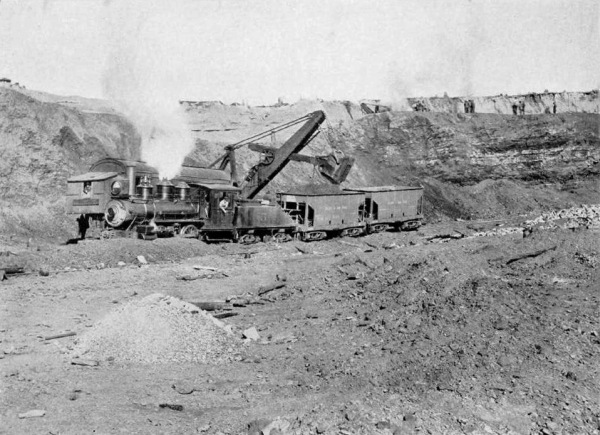
A Steam Shovel at Work.
This removes from 4000 to 8000 tons of ore a day.
Already the centre of lumber production has swung from the North to the South. The yellow pine of Louisiana is now taking the place once filled by white pine, and at the rate it is being cut another decade will see that State stripped as clean as Michigan now is, and then the country’s last resort will be to turn to the Pacific coast with its forests of Douglas fir. And still, as though blindfolded to all sense and reason,59 almost every State government continues to look upon the fatal destruction without a thought for the future, though before us are facts which show that Americans are using nearly eight times as much lumber per capita as is used in Europe, and that the nation is consuming four times as much wood annually as is produced by growth in our forests.
Ten years more and the last of the romantic old lumber ships of the Inland Seas will have passed away; gone forever will be the picturesque life of those who have clung thus long to the fate of canvas and the four winds of heaven; and with it, too, will pass the remaining few of those old lumber kings who have taken from Michigan forests alone fifty per cent. more wealth than has been produced by all the gold mines of California since their discovery in 1849.
But in the place of this passing industry is rapidly growing another, the effect of which is already being felt over half of the civilised world, and which in a very few years from now will be counted the greatest and most important commerce in existence. The iron mines of the North may become exhausted, the little remaining forest of the Lake regions will fade away; but the grain trade will go on forever. Just as the Superior mines have produced cheap iron and steel, just as the Inland Seas have been the means of giving the nation cheap lumber, so will they for all time to come supply unnumbered millions with cheap bread. Like great links, they connect the vast grain-60producing West with the millions of the bread-consuming East. And not only do they control the grain traffic of the United States. To-day western Canada is spoken of as the future “Bread Basket of the World,” and over the Lakes will travel the bulk of its grain. Looking ahead for a dozen centuries, one cannot see where there can be a monopoly of grain transportation, either by railroad or ship. The water highways are every man’s property; a few thousand dollars—a ship—and you are your own master, to go where you please, carry what you please, and at any price you please. For all time, in the carrying of grain from field to mouth, the Great Lakes will prove themselves the poor man’s friend. To bring this poor man’s bushel of wheat over the one thousand miles from Duluth to Buffalo by Lake now costs only two cents.
And according to the predictions of some of the oldest ship-owners of the Lakes, the tremendous saving to the poor man because of the cheapness of Lake freightage is bound to increase in the not distant future. It must be remembered that at the present time ships are not built too fast for Lake demand, and as a consequence transportation rates, while exceedingly low when compared with rail rates, are such as to make fortunes each year for the owners of ships. Take the cargo of the B. F. Jones, for instance, delivered at Buffalo in October of 1906. She had on board 370,273 bushels of wheat which she had brought from Duluth at two and three fourths cents a bushel, making her61 four-day trip down pay to the tune of $7500! The preceding year one cargo of 300,000 bushels was brought down for six cents a bushel, a very extraordinary exception to the regular cheap rate—one of the exceptions which come during the last week or two of navigation. The freight paid on this cargo was $18,000. In other words, if this vessel had made but this one trip during the season the profit on the total investment of $300,000 represented by the ship would have been six per cent. There are on the Lakes vessels which pay from twenty to thirty per cent. a year, and an “ordinary earner” is supposed to run from ten to twenty.
In viewing these enormous profits, however, the layman has no cause for complaint, for the vessels that make them do so not to his cost, but from the rapidity with which they achieve their work. The W. B. Kerr is a vessel that can carry 400,000 bushels of wheat. Figure that she makes twenty trips a season. If she carried grain continually she would transport a total of 8,000,000 bushels in a single season, which would supply Chicago with bread for nearly a year and a half. And it is an interesting fact, too, that with few exceptions the ships of the Lakes are not owned by corporations, but by the American people. Their stock is held, not by thousands, but by hundreds of thousands. Recognised as among the best and safest investments in the United States, they are the property of farmers, mechanics, clerks, and62 other small investors, as well as of capitalists. Recently one of the largest shipbuilders on the Lakes said to me, “A third of the farmers in the Lake counties of Ohio have money invested in shipping.” Which shows that not only in the way of cheap transportation are the common people of the country profiting because of the existence of our Inland Seas. It may be interesting to note at this point that the tonnage shipped and received at Ohio ports in 1907 exceeded that of all the ports of France.
The rate at which the grain traffic of the Lakes is increasing is easily seen in the figures of the last few years. In 1905, over 68,000,000 bushels of wheat passed through the “Soo” canals. In 1906, this increased to more than 84,000,000, showing a growth in one year of 16,000,000 bushels, or 23 per cent. This rate of increase is not only being maintained, but it is becoming larger; and the grain men of the Lakes are unanimous in the opinion that even from the big increase of recent years cannot be figured the future grain business of the Inland Seas.
“Ten years more will see the American and Canadian Wests feeding the world,” a grain dealer tells me. “Within that time I look to see the wheat production of North America not only doubled, but trebled.”
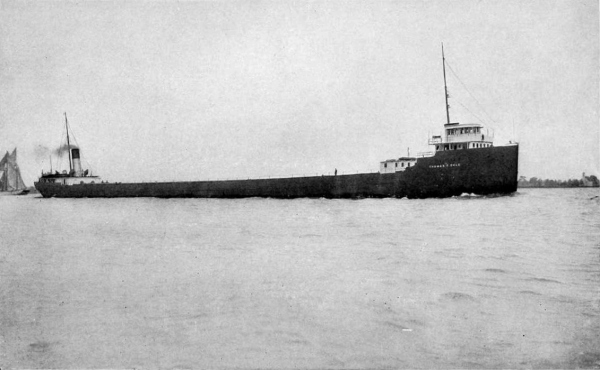
The Old and the New.
A modern freight carrier passing one of the old schooners.
What western Canada is destined to mean to Lake commerce is already shown in marine figures. From Port Arthur and Fort William, the “twin cities” of Thunder Bay, were shipped in 1907 over 60,000,00063 bushels of grain, and it is safe to predict that the shipment of these two little cities will this year exceed 70,000,000 bushels. The largest elevator in the world, with a capacity of 7,500,000 bushels, has been constructed at Port Arthur; and Fort William already has a capacity of 13,000,000 bushels.
And as yet the fertile regions of western Canada have hardly been touched! These 70,000,000 bushels of 1909 will represent part of the production, not of a nation, but of a comparatively few pioneers in what is destined to become the greatest grain-growing country in the world—a country connected with the East and the waterways to Europe by the Five Great Lakes. When the task now under way of widening and deepening the Erie Canal is accomplished, the enormous Lake traffic in grain may continue without interruption to the Atlantic coast. Even as it is, the transportation of grain from Buffalo to New York by canal is showing a phenomenal increase. The value of the freight cleared by canal from Buffalo in 1907 was nearly $19,000,000, while in 1905 it was less than $12,000,000.
Like the building of ships the building of elevators is now one of the chief occupations along the Lakes. The “grain age,” as vessel-men are already beginning to call it, has begun. In the four chief grain ports of the Lakes, Chicago, Duluth-Superior, Buffalo, and Port Arthur-Fort William, there are now 145 elevators with a capacity of 138,000,000 bushels. Chicago64 leads, with 83 elevators and a capacity of 63,000,000, although Duluth-Superior with their 27 elevators and 35,000,000-bushel capacity shipped half again as much grain to Buffalo in 1907 as did Chicago. Buffalo is the great “receiving port” of the lower Lakes. There vast quantities of grain are made into flour, and the rest is transhipped eastward. At present the city possesses 28 elevators with a capacity of 23,000,000 bushels.
There is another potent reason why the passing of the lumber traffic and the future exhaustion of the iron mines do not trouble ship builders and owners. It has been asserted that when lumber and iron are gone there will no longer be business for all of the ships of the Lakes. How wrong this idea is has been shown by the growth of the grain trade. But grain will be only one item in the enormous commerce of the future. Each year the coal transportation business is growing, and the constantly increasing saving to coal consumers because of this commerce is astonishing. At one end of the Lakes are the vast coal deposits of the East; at the other is Duluth, the natural distributing point for a multitude of inland coal markets. Of the 16,000,000 tons of coal to be shipped by water this year probably 8,000,000 will go to Duluth, and will be carried a distance of one thousand miles for thirty-five cents a ton, just about what one would pay to have it shovelled from a waggon into his basement window! The remaining 8,000,000 tons will be unloaded at Chicago, Milwaukee, etc.
65 One of the most interesting sights to be witnessed along the Lakes is the loading and unloading of a big cargo of coal. The W. B. Kerr holds the record at this writing. She loaded 12,558 tons at Lorain for Duluth, and took on 400 tons of fuel in addition. Inconceivable as it may seem, such a cargo under good conditions can be loaded on a ship in from ten to fifteen hours. The vessel runs alongside the coal dock, her crew lifts anywhere from a dozen to twenty hatches, and the work begins. In the yards are hundreds of loaded cars. An engine quickly pushes one of these up an inclined track to a huge “lift,” or elevator, to the tracks of which the wheels of the car are automatically clamped. Then the car, with its forty or fifty tons of coal, scoots skyward, and when forty feet above the deck of the ship great steel arms reach out and turn it upside down. With a thunderous roar the coal rushes into a great chute, one end of which empties into a hatch. Then the car tips back, is quickly carried down by the elevator, and is “bumped off” by another loaded car, which goes through the same operation. Four or five days later, at the other end of the Lakes, powerful arms, high in the air, reach out over the open hatches of the same vessel. Out upon one of these arms suddenly darts a huge “clamshell” bucket; for a moment it poises above a hatch, then suddenly tumbles downward, its huge mouth agape, and half buries itself in the cargo of coal. As it is pulled up, the “jaws” of the clam are closed, and66 with it ascend several tons of fuel. Three or four of these clam-shells may be at work on a vessel at the same time, and can unload 10,000 tons in about two days. In the days of old, it would have taken three weeks and scores of men to unload such a cargo.
“And in looking into the future we must take another item into consideration,” said President Livingstone to me. “And that is package freight. It is almost impossible to estimate the amount that is carried, but it is enormous, and has already saved the country millions in transportation.”
There is one other “item” that is carried in the ships of the Inland Seas—not a very large one, judging by bulk alone, but one which shows that the possibilities of romance are not yet gone from modern commerce. Perhaps, sometime in the not distant future, you may have the fortune to see a Lake ship under way. She is long, and black, and ugly, you may say; she carries neither guns nor fighting men, nor is she under convoy of a man-o’-war. Yet it may be she carries a richer prize than any galleon that ever sailed the Spanish Main. She is a “treasure ship” of the Inland Seas, bringing down copper from the great Bonanzas of the North. The steamer Flagg holds the record, carrying down as she did in 1906 $1,250,000 worth of metal.
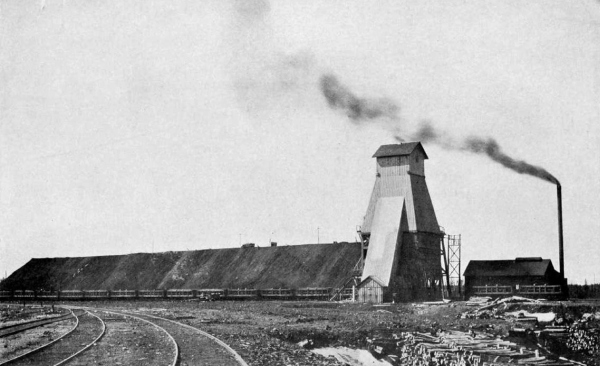
Once a copper ship was lost——
But I will keep that story a little longer, for it67 properly belongs in “The Romance and Tragedy of the Inland Seas,” in which I pledge myself to show that the great salt oceans are not the only treeless and sandless wastes rich in mysterious, romantic, and tragic happenings.
In a previous article I have shown how the saving to the people of the United States by reason of Great Lake freight transportation is more than five hundred million dollars a year, or, in other words, an indirect “dividend” to the nation of six dollars for every man, woman, and child in it. Yet in describing how this enormous saving was accomplished I touched upon but one phase of what I might term the “saving power” of the Lakes. To this must be added that dividend of millions of dollars which indirectly goes into the pockets of the people because of the cheapness of water transportation and because of the extraordinarily low cost at which one may enjoy, both afloat and ashore, the summer life of the Lakes. These two phases of Lake life are among the least known, and have been most neglected.
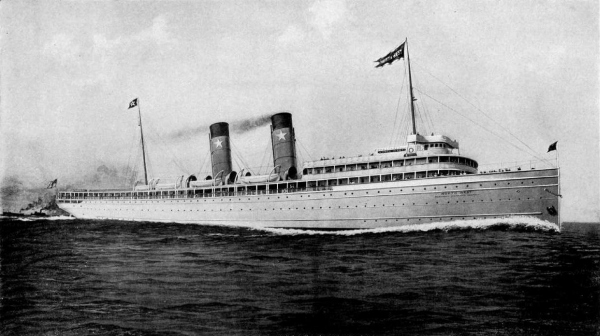
The “North West.”
One of the finest passenger steamers on the Great Lakes.
At the same time, considering the health and pleasure as well as the profit of the nation, they are among the most important. To-day it is almost unknown outside of Lake cities that one may travel on the Inland Seas at less cost per mile than on any other waterway in69 the civilised world, and that the pleasure-seeker in New York, for instance, can travel a thousand miles westward, spend a month along the Lakes, and return to his home no more out of pocket than if he had indulged in a ten-day or two-week holiday at some seacoast resort within a hundred miles of his business. This might be accepted with some hesitancy by many were there not convincing figures behind the statements, figures which show that the Lakes are primarily the “poor man’s pleasure grounds” as well as his roads of travel, and that on them he may ride in company with millionaires and dine with the scions of luxury and fashion without overreaching himself financially. This has been called the democracy of the Lakes. And only those who have travelled on the Inland Seas or summered along their shores know what the term really means. It is a condition which exists nowhere else in the world on such a large scale. It means that what President Roosevelt describes as “the ideal American life” has been achieved on the Lakes; that the bank clerk is on a level, both socially and financially, for the time, with the bank president, with the same opportunities for pleasure and with the same luxuries of public travel within his reach. The “multi-millionaire” who boards one of the magnificent passenger steamers at Buffalo, Cleveland, Detroit, or Chicago, or any other Lake port, has no promenade decks set apart for himself and others of his class, as on ocean vessels; there are no first-, second-, and third-70class specifications, no dining-rooms for the especial use of aristocrats, no privileges that they may enjoy alone. The elect of fortune and fashion becomes a common American as soon as he touches a plank of a Lake vessel, rubs elbows with the everyday crowd, smokes his cigars in company with travelling men, rural merchants, and clerks, forgets himself in this mingling with people of red blood and working hands—and enjoys himself in the experience. It is a novel adventure for the man who has been accustomed to the purchase of exclusiveness and the service of a prince at sea, but it quickly shows him what life really is along the five great waterways that form the backbone of the commerce of the American nation.
This is why the passenger traffic of the Inland Seas is distinctive, why it is the absolute antithesis of the same traffic on the oceans. If a $2,000,000 floating palace were to be launched upon the Lakes to-morrow and its owners announced that social and money distinctions would be recognised on board, the business of that vessel would probably be run at a loss that would mean ultimate bankruptcy. It is an experiment which even the wealthiest and most powerful passenger corporations on the Lakes have not dared to make, though they have frequently discussed it. A score of passenger traffic men have told me this. It is a splendid tribute to the spirit of independence and equality that exists on these American waters.
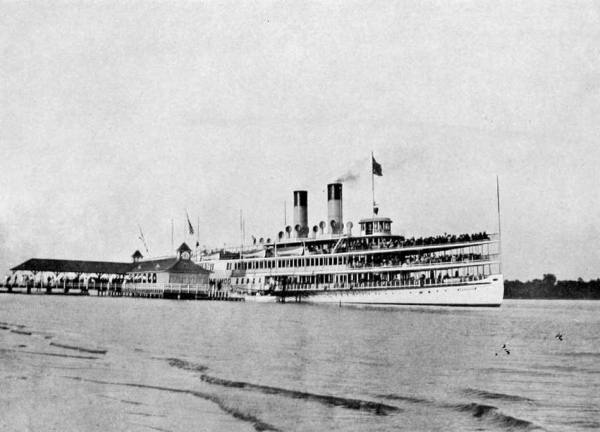
And there is a good reason for this spirit. In 1907,71 sixteen million passengers travelled on Lake vessels and of these it is estimated that less than five hundred thousand were foreign tourists or pleasure-seekers from large Eastern cities. In other words, over fifteen million of these travellers were men and women of the Lake and central Western States, where independence and equality are matters of habit. Twelve million were carried by vessels of the Eighth District, which begins at Detroit and ends at Chicago, while only three and a half million were carried in the Ninth District, including all Lake ports east of the Detroit River. From these figures one may easily get an idea of the class of people who travel on the Lakes, and at the same time realise to what an almost inconceivable extent our Inland Seas are neglected by the people of many States within short distances of them. Astonishing as it may seem, nearly eight million passengers were reported at Detroit in 1907—as many as were reported at all other Lake ports combined, including great cities like Buffalo, Cleveland, and Chicago. These millions were drawn almost entirely from Michigan and Ontario, with a small percentage coming from Indiana, Ohio, and Kentucky. Ninety per cent. of the Chicago traffic of two million was from Illinois, Indiana, and Wisconsin, while of the three and a half million carried east of the Detroit River, from Erie and Ontario ports, fully two thirds were residents of Ohio and Pennsylvania. At Buffalo, which draws upon the entire State of New York and72 upon all States east thereof, there were reported only a million passengers! To sum up, figures gathered during the year show that fully ninety per cent. of all travel on the Inland Seas is furnished by the States of Ohio, Indiana, Michigan, Illinois, Wisconsin, Minnesota, western New York, western Pennsylvania, and northern Kentucky.
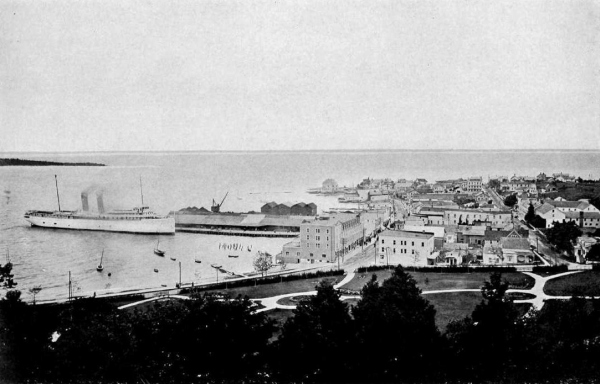
Why is this? Why are the most beautiful fresh-water seas in the whole world neglected by their own people? Why is it that from the single city of Boston there travel by water two million more people than on all of the Lakes combined, which number on their shores the second largest city on the continent and four others well up in the front rank? I have asked this question of steamship companies in a dozen ports along the Lakes, and from them all I have received practically the same reply. There is a man in Detroit who has been in the passenger traffic business for more than a quarter of a century. I refer to A. A. Schantz, general manager of the largest passenger business on the Lakes. He was managing boats at the age of twenty, he has studied the business for thirty years, and he hits the nail squarely on the head when he says: “It’s because people don’t know about the Lakes. For generations newspapers and magazines have talked ocean to them. They know more about Bermuda and the Caribbean than they do about Mackinaw and the three thousand islands of Lake Huron. The people of three States out of four73 are better acquainted with steamship fares to London and Liverpool than to Duluth or Chicago; they have been taught to look to the oceans and ocean resorts, and to-day the five Great Lakes of America are more foreign, so far as knowledge of them is concerned, than either the Atlantic or the Pacific.”
This is true. When Admiral Dewey made his triumphal journey through the Inland Seas even he found himself constantly expressing astonishment at what he saw and heard. It is so with ninety-nine out of every hundred strangers who come to them. Think, for instance, of travelling from Detroit to Buffalo, a distance of two hundred and sixty miles, for $1.25!—less than half a cent a mile! I recently told a Philadelphia man who has been to Europe half a dozen times about this cheap travel, and he laughingly asked, “What kind of tubs do you have on the Lakes that can afford to carry passengers at these ridiculous rates?”
Well, there is one particular “tub” which offers this cheap transportation once a week, which cost a little over a million and a quarter dollars! Every bit of woodwork in the parlours, promenades, and dining-rooms is of Mexican mahogany. It carries with it a collection of oil paintings which cost twenty-five thousand dollars. Every one of four hundred state-rooms is equipped with a telephone and there is a telephone “central,” so that passengers may converse with one another or with the74 ship’s officers without leaving their berths. There are reading-rooms, and music-rooms, and writing-rooms, magnificently upholstered and furnished; and on more than one of these Lake palaces passengers may amuse themselves at shuffle-board, quoits, and other games which fifty millions of Americans believe are characteristic only of ocean craft. Another of these “tubs”—the Eastern States—broke Lake records in 1907 by berthing and feeding fifteen hundred people on a single trip; and the new City of Cleveland will accommodate two thousand without crowding.
Notwithstanding the extreme cheapness of their rates of transportation, Lake passenger vessels constantly vie with one another in maintaining a high standard of appearance and comfort. This is illustrated in the interesting case of the City of St. Ignace, which was built a number of years ago at a cost of $375,000. Since that time, in painting, decorating, refurnishing, etc., and not including the cost of broken machinery or expense of crew, nearly $500,000 have been spent in the maintenance of this vessel, a sum considerably greater than her original cost. A Government law says that thirty per cent. of the cost of a vessel must be expended in this kind of maintenance before that particular boat can change its name. The City of St. Ignace could have changed her name four times! And the case of the St. Ignace is only one of many.
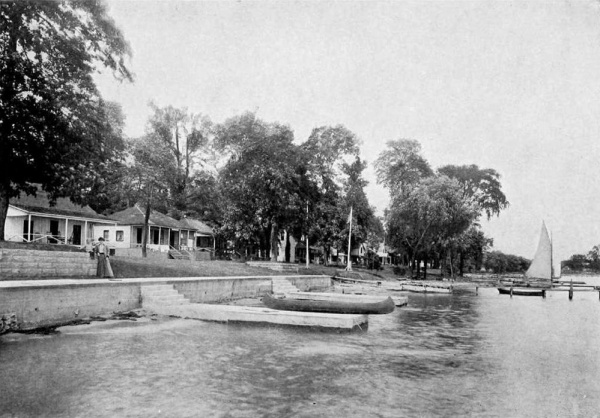
Hickory Island at the Mouth of Detroit River.
From a Photograph by Manning Studio, Detroit.
I have gone into these facts with some detail for75 the purpose of showing that the extreme cheapness of travel and living along the Lakes does not signify a loss of either comfort or luxury. In few words, it means that the Lakes, as in all other branches of their industries, are agents of tremendous saving to the nation at large in this one; and that, were the pleasure-seekers and travellers of the country to become better acquainted with them, the annual “dividend” earned in freight transportation would be doubled by passenger traffic. The figures of almost any transportation line on the Lakes will verify this. Last year, for instance, one line carried two hundred thousand people between Detroit and Cleveland. The day fare between these points is one dollar, the distance 110 miles. Estimating that four fifths, or one hundred and sixty thousand, of these passengers travelled by day, their total expense would be $160,000. By rail the distance is 167 miles, and the fare $3.35, making a total railway fare of $536,000. These figures show that one passenger line alone, and between just two cities, saved the travellers of the country $376,000 in 1908. The saving between other points is in many instances even greater. Once each week one may go by water from Detroit to Buffalo, or from Buffalo to Detroit, a distance of 260 miles, for $1.25, while the rail rate is seven dollars; and at any time during the week, and on any boat, the fare is only $2.50. These low rates prevail, not only in localities, but all over the Lakes. The tourist may board a Mackinaw boat at any time in76 Cleveland, for instance, travel across Lake Erie, up the Detroit River, through Lake St. Clair and Lake Huron, and back again—a round trip of nearly one thousand miles—at an expense of ten dollars. The round trip from Detroit to Mackinaw, which gives the tourist two days and two nights aboard ship and a ride of six hundred miles, costs eight dollars. The rail fare is $11. At a ticket expense of less than twenty-five dollars one may spend a whole week aboard a floating palace of the Lakes and make a tour of the Inland Seas that will carry him over nearly three thousand miles of waterway, his meal service at the same time being as good and from a third to a half as expensive as that of a first-class hotel ashore. Excursion rates, which one may take advantage of during the entire season, are even less, frequently being not more than half as high as those given above.
When one becomes acquainted with these facts it is easy for him to understand the truth of Mr. Schantz’s statement that “people don’t know about the Lakes.” If they did, the annual passenger traffic on them would be thirty million instead of sixteen; and, instead of an estimated saving of ten million dollars to the people because of Lake passenger ships, the “dividend” that thus goes into their pockets would be twice that amount.
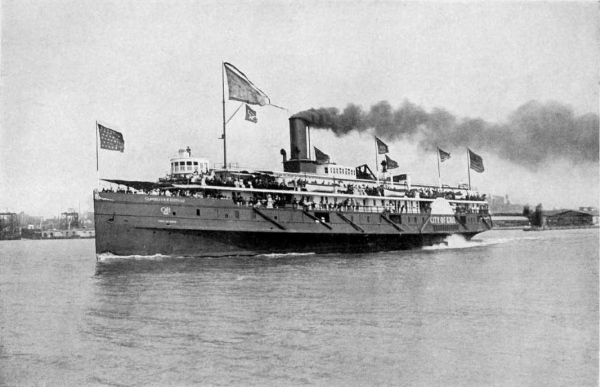
The “City of Erie.”
The fastest steamer on the Lakes, holding a record of 22.93 miles per hour.
Foreign shipbuilders as well as Americans along the seacoasts frankly concede that vessel-building on the Lakes has developed into a science which is equalled77 nowhere else in the world, evidence of which I have offered in a former article. This is true of passenger ships as well as of freighters, and the strongest proof of this fact lies in the almost inconceivably small loss of life among travellers on the Lakes. There was a time when the marine tragedies of the Inland Seas were appalling, and if all the ships lost upon them were evenly distributed there would be a sunken hulk every half-mile over the entire thousand-mile waterway between Buffalo and Duluth. But those days are gone. Lake travel has not only become the cheapest in the world, but the safest as well. The figures which show this are of tremendous interest when compared with other statistics. Of the sixteen million men, women, and children who travelled on Lake passenger ships in 1907, only three were lost, or one out of every 5,300,000. Two of these were accidentally drowned, and the third met death by fire. The percentage of ocean casualties is twelve times as great, and of the eight hundred million people who travelled on our railroads during 1906 approximately one out of every sixty thousand was killed or injured.
To the great majority of our many millions of people the summer life of the Lakes is as little known as the passenger traffic. And, if possible, it offers even greater inducements, especially to those who wish to enjoy the pleasures of an ideal summer outing and who can afford to spend but a very small sum of money. Notwithstanding this fact, the shores and78 countless islands of the Great Lakes are taken advantage of even less than their low transportation rates. Only a few of the large and widely-advertised resorts receive anything like the patronage of seacoast pleasure grounds. If a person in the East or West, for instance, plans to spend a month somewhere along the Lakes, about the only information that he can easily obtain is on points like Mackinaw Island: popular resorts which are ideal for the tourist who wishes to pass most of his time aboard ship, or who, in stopping off at these more fashionable places, is not especially worried about funds.
It is not of such isolated places as the great resorts that I shall speak first. They play their part, and an important one, in the summer life of the Lakes; but it is to another phase of this life, one which is almost entirely unknown, that I wish to call attention. The man who does not have to count the contents of his pocket-book when he leaves home will find his holiday joys without much trouble. But how about the man who works for a small salary, and who with his restricted means wishes to give his wife and children the pleasures of a real vacation? What about the men and women and children who look forward for weeks and months, and who plan and save and economise, sometimes hopelessly, that somewhere they may have two weeks together, free from the worry and care and eternal grind of their daily life? It is to such people as these, unnumbered thousands of them, that the79 Lakes should call—and loudly. And it is to such as these that I wish to describe the astonishing conditions which now exist along thousands of miles of our Great Lakes coast line—conditions which, were they generally known, would attract many million more people to our Inland Seas next year than will be found there during the present summer.
“But where shall I go?” asks the man who is planning a vacation, and who may live two or three hundred miles away from the nearest of the Great Lakes. He is perplexed, and with good cause. He has spent other vacations away from home and generally speaking he knows what a hold-up game ordinary summer-resort life is. But he need not fear this on the Lakes. All that he has to do in order successfully to solve this problem of “where to go” is to get a map, select any little town or village situated on the fresh-water sea nearest to him, or three or four of them, for that matter, and write to the postmasters. They can turn the communications over to some person who will interest himself to that extent. Say, for instance, that you write to the little port of Vermilion, on Lake Erie. Your reply will state that “Shattuck’s Grove would be a nice place for you to spend your holidays; or you may go to Ruggles’ Grove, half a dozen miles up the beach; or you can get cheap accommodations, board and room for three or four dollars a week apiece, at any one of a hundred farmhouses80 that look right out over the lake.” In fact, it is not necessary for you to write at all. When you are ready to leave on your vacation, when your trunk is ready and the wife and children all aglow with eagerness and expectancy—why, start. Go direct to any one of these little Lake towns. Within a day after arriving there, or within two days at the most, you will be settled. I have passed nearly all of my life along the Lakes, and have travelled over every mile of the Lake Erie shore; I have gone from end to end of them all, and I do not know of a Lake town that does not possess in its immediate vicinity what is locally known as a “grove.” A grove, on the Lakes, means a piece of woods that the owner has cleared of underbrush, where the children may buy ice-cream and candy, where there are plenty of swings, boats, fishing-tackle, and perhaps a merry-go-round, and where the pleasure-seeker may rent a tent at almost no cost, buy his meals at ridiculously low prices and live entirely on the grounds, or board with some farmer in the neighbourhood. A “grove,” in other words, is what might be called a rural resort, a place visited almost entirely by country people and the residents of neighbouring towns, and where one may fish, swim, and enjoy the most glorious of all vacations for no more than it would cost him to live at home, and frequently for less.
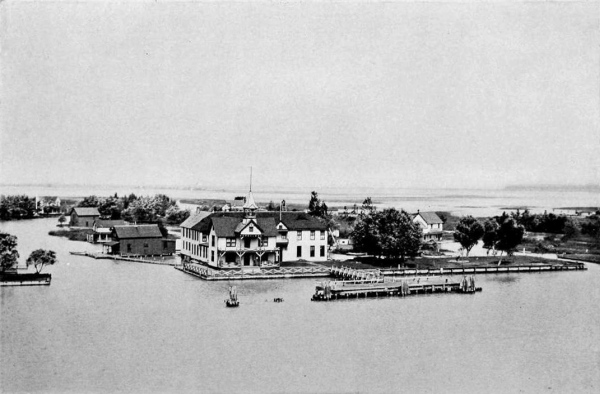
Little Venice, St. Clair River.
Showing the type of “Inns,” where people may pass their holidays at small expense.
Courtesy of Northern Steamship Co.
There are many hundreds of these “groves” along the Lakes, unknown to all but those who live near81 them. Only on occasion of Sunday-school picnics or Fourth of July celebrations are they crowded. They are the most ideal of all places in which to spend one’s holidays, if rest and quiet recreations are what the pleasure-seeker desires. And these groves are easily found. I do not believe there is a twenty-mile stretch along Lake Erie that does not possess its grove, and sometimes there are a dozen of them within that distance. I know of many that are not even situated near villages, being five or six miles away and patronised almost entirely by farmers. In almost any one of them a family may enjoy camp life if they wish, buy their supplies of neighbouring farmers, do their own cooking, rent a good boat for from twenty-five to fifty cents a day, and get other things at a corresponding cost. I am personally acquainted with one family of four who came from Louisville to one of these sylvan resorts on Lake Huron last year, and the total expense of their three weeks’ vacation, not including railroad fare, was under fifty dollars. The experience of these parents and their children is not an exception. It is a common one with those who are acquainted with the Lakes and who know how to take advantage of them to their own profit.
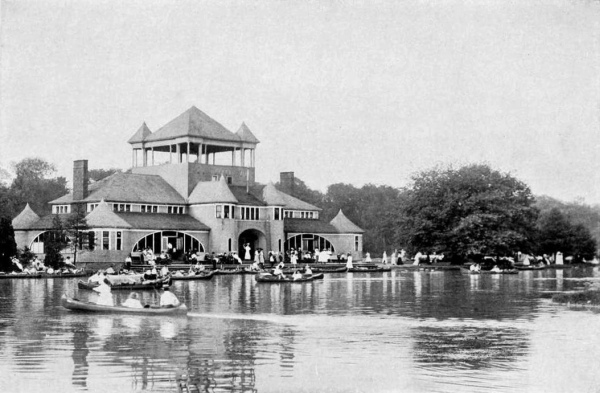
There is another phase of Lake life, a degree removed from that which I have described, which is also unknown beyond its own local environment and which ought to be made to be of great profit and pleasure to those seeking holiday recreation along82 our Inland Seas. The shores of the Lakes, from end to end, are literally dotted with what might appropriately be called lakeside inns—places located far from the dust and noise and more fashionable gaiety of crowded resorts and cities, where one may enjoy all of the simpler pleasures of water-life for from six to eight dollars a week. This price includes room, board, boats, fishing-tackle, and other accommodations. At most of these places the board is superior to that which one secures at the large resorts. Fish, frogs’ legs, and chickens play an important part in the bill of fare, and almost without exception they are placed upon the table in huge dishes, heaped with fresh viands from the kitchen as soon as they become empty. The fish cost the innkeepers nothing, for they are mostly caught by the pleasure-seekers themselves; frogs usually abound somewhere in the immediate vicinity, and where the landlord does not raise his own fowls they are purchased from neighbouring farmers. The inn is a local market for butter, eggs, celery, and vegetables of all kinds, so it is not difficult to understand why the board at these places is superior to almost any that can be found in a city. I have no doubt that if these lakeside inns were generally known they would be so crowded that life would not be worth living in them. But they are not known and as a consequence are running along in their old-fashioned way, sources of unrivalled summer joy to those who have been fortunate enough to discover them. At many83 of these inns only a dollar a day is charged, all accommodations included, and the price is seldom above $1.50 a day, even for transients. I know of one inn that has been “discovered” by half a dozen travelling men and their wives. Three of these families live in Cleveland, one in Pittsburg, and two in New York, and each year they spend a month together on Lake St. Clair. The cost is six dollars a week for each adult! A few weeks ago I was talking with one of these men, the representative of a New York dry-goods firm, and he told me that for himself, his wife, and two children it cost less to stay a month at this place than it did to pass a single week at an ocean resort, and that the accommodations and opportunities for pleasure were greater there than he had ever been able to afford on the Atlantic. I do not wish to emphasise the attractions of any particular inn, for in most ways all of them are alike. And the holiday-seeker who knows nothing of the Lakes can find them as easily as he can locate the groves I have described. The secret of the whole thing is in the knowledge that hundreds of such places really exist.
I have often thought that if it were possible for every person in the United States to make a trip over the Lakes, beginning at Niagara Falls, our Inland Seas from that day on would be recognised as the greatest pleasure-grounds in the world. At Niagara Falls, the traveller takes the Gorge ride, and perhaps makes a trip on the Maid of the Mist. But he is84 probably unaware that in the immediate neighbourhood are a score of spots hallowed in history, and whose incidents have made up some of the most romantic and tragic pages in the story of our country. He may not know that within walking distance of the falls was fought the battle of Queenston Heights, that at certain points the earthworks of the British still remain, that he may stand in the very spot where General Brock fell dying, and that he may follow, step by step, that thrilling fight far up on the summit of those wild ridges. Neither does the ordinary tourist know that almost within sight of the falls is one of the oldest cemeteries in America, where many of the men who were slain in the battles of those regions are at rest. Old Fort Niagara remains almost unvisited, and the spot not far distant where the adventurer La Salle built the Griffin, the first vessel ever to sail the Lakes, is virtually unknown. Two weeks, and every hour of them filled with interest, might be spent by the Lake tourist at Niagara Falls, yet the average person is satisfied with a day. And it is all because he does not know. This may be said of his experiences from end to end of the Lakes.
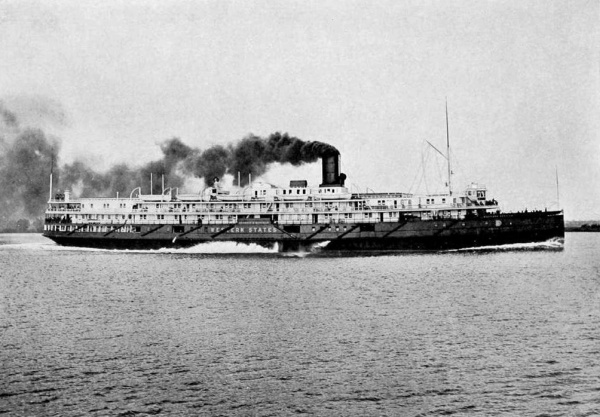
Steamer “Western States.”
One of the largest and fastest boats on the Lakes. Carries 2500 people and her fastest speed is 20 miles an hour.
From a Photograph by Detroit Photographic Co.
When his ship passes into Lake Erie he enters upon new and even more thrilling pages of history. Near Put-in-Bay his captain can point out to him where Perry and his ships of war engaged and whipped the British fleet in 1813; for nearly a hundred miles his vessel will travel over the very course taken by the85 fleeing British ships, and that course, if he follows it to the Thames, will lead to the scenes of the fierce battle that was fought there, and of the sanguinary conflict with the Indians in which the famous chieftain Tecumseh was slain. And all this time he will see rising along the white stretches of shore the smoke of great cities, and hundreds of miles of wooded beach, where unnumbered millions might pass their summer holidays without crowding. And when he enters the Detroit River he looks out upon quiet Canadian shores and little “Sleepy Hollow” towns, still characterised by the quaint French atmosphere and peacefulness that marked them a century ago.
Now he begins to see the crowded, noisy, jostling pleasures of popular river resorts; then comes Detroit, the greatest excursion city on the Lakes. Here again history may add to the pleasure of his reflections, for three nations have fought for and possessed Detroit. He passes Belle Isle, the greatest pleasure ground in the world with the exception of Coney Island, and a few minutes later can almost throw a stone upon the island that was once the home of the famous Indian chief Pontiac, and where the plans for that bloodthirsty warrior’s assaults upon the whites were made. Then follows the course across beautiful Lake St. Clair, and the slow journey through Little Venice, where again the crowds and music and gay vessels of one of the most popular resorts in America greet his eyes for many miles; where every bit of land that86 thrusts itself out of the lake is lined with summer cottages and lakeside inns. Here the tourist may stop for a dollar a day or two dollars a day, and may mingle freely with bankers and merchants and millionaires as well as with the “common herd.” It is a mixed, happy, cosmopolitan life.
From Little Venice the tourist’s ship enters the St. Clair River, along which live innumerable captains of ships. It is a paradise of beauty, yet along its length one may buy cottage sites cheaper than he can purchase ordinary city lots. Here the traveller will see the tents of happy campers from the city, comfortable inns, and now and then a summer resort hotel—a mixed life, one of pleasure for the man with a family and little money as well as for him who has more than he knows well how to spend.
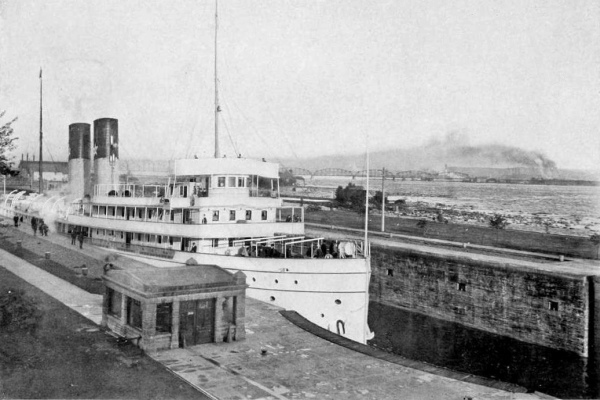
Once out upon the bosom of Lake Huron, the scenes begin to change. Now there are miles of shore on which there is hardly a habitation to be seen. From Saginaw Bay northward for hundreds of miles along the Georgian Bay and Michigan shores, the grandeur and beauty of the wilderness are seen from the deck of the vessel. As one progresses farther north the scenes become wilder and wilder, until the captain may tell you that you are looking out over regions where the bear and the deer and the wolf make their homes; and if you have a drop of sportsman’s blood in you, he adds to your excitement by saying that you may see big game from the deck of the ship before the trip is87 over. At times, and for long distances, the vessel seems to be picking her way between innumerable islands, and if the course is through Georgian Bay their number bewilders the traveller. They are on all sides of him. Here and there upon them are resort hotels; more numerous still are the simple, homelike places where the city worker and his family may stay at comparatively small expense, and along the mainland are the homes of settlers and farmers, nine out of ten of whom are glad to accommodate summer visitors at prices which make living there as cheap as at home.
Farther northward the tourist’s ship carries him deeper into the wilderness country, through St. Mary’s River, with its forest-clad shores and islands, broken here and there by little cottages built and owned by city people; through the locks at the “Soo,” and into Lake Superior. Beyond this, as one captain expressed it to the writer, “there is howling wilderness on every shore.” At times the traveller may have glimpses of the Canadian coast, from which the unbroken wild stretches northward to Hudson Bay; his eyes may travel over the hazy distance of the greatest moose- and caribou-hunting country on the continent; and when near the Michigan shore he may see the smoke rising above the great copper mines of the Upper Peninsula. And at the end of this northern route he comes to Duluth, the second greatest freight-shipping port in the world, and88 destined to become one of the most important cities in America.
At the Straits of Mackinaw, however, the tourist may turn into Lake Michigan instead of continuing into Superior: and if so, he soon comes within sight of Beaver Island, famous for all ages in history as the one-time stronghold of King Strang and his Mormons—an island about which piracy once flourished and where more than one vessel, in the years of long ago, met a mysterious and tragic end at the hands of buccaneers as bloodthirsty as any that ever roamed the seas.
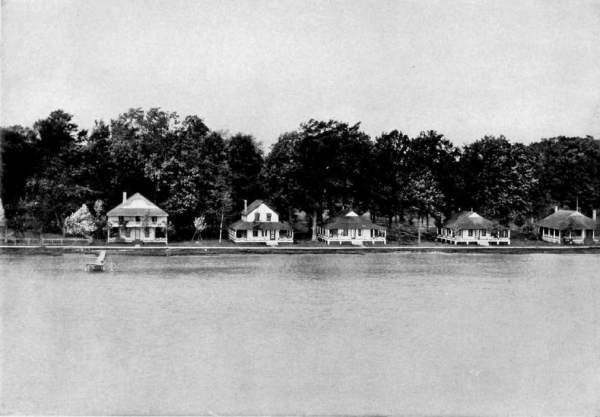
And so it goes, from end to end of the Lakes, every mile fraught with interest, every hour offering the traveller something new of scenery or history. At no time is there the monotonous sameness of ocean travel, and even night is to be regretted because of the things which are passed then and cannot be seen. And this life of the Lakes is not, like that of the salt seas, open only to those of means. It is within the poor man’s reach as well as the rich, is accessible to the hard-working housewife as well as to the woman who possesses her carriage and her servants.
I was watching a blockade of ships in a Lake Erie harbour—a score of striving, crowding, smoking monsters of the Inland Seas, hung under a pall of black smoke, with screeching tugs floundering here and there, megaphone voices shouting curses and orders, and the crashing of chains and steel filling the air. And I thought of a theatre I had visited the night before where, arriving late, I was forced to crush in with the gallery gods and fight for a place in the fifth heaven. In the excitement of this “spring rush” of great ships for the freight-laden docks of the North, I spoke my sentiment to the man beside me—a man who had always before him in his office five miniature lakes, on which miniature vessels represented his steel leviathans of commerce, which he moved about, and played, and watched, day by day and almost hour by hour, as a player might move his men at chess. And this man, I noticed, was regarding the scene before him with different eyes from mine. His face was set in a frown, his eyes stared in their momentary anxiety, and I could almost feel the eager tenseness of his body.90 Out there in that chaotic tangle, where captains were fighting for prestige and taking chances that might cost thousands, he had ships. I saw him clench his hand as a black monster crept forward into the gap between two ships ahead; I saw it forge on, yard by yard, saw the other vessels close up on it as though it were an egg which they were bent on crushing between them, heard the rumbling of steel side against steel side, and when at last I witnessed this ship break triumphantly into the lead, great blotches of paint scraped from it, I looked at the man again, and he was smiling.
Then he turned to me, and as we walked away from the scene, he observed:
“That’s good—that ‘crush’ idea of yours. I’d use it. It’s as pretty a comparison as you could get to the whole situation on the Lakes to-day, and it’s a key to what the situation is going to be ten years from now. It’s crush and crowd all over the Lakes from Duluth to Buffalo. Harbours are getting too small; the ‘Soo’ canals are becoming outgrown; the Lime Kiln crossing is a greater and greater menace as the number of ships increases. And the ships? They’re increasing so fast that unless the Government takes a hand, there will be more tragedies to write down in Lake history during the next decade or two, than in all of the years that have gone before.”
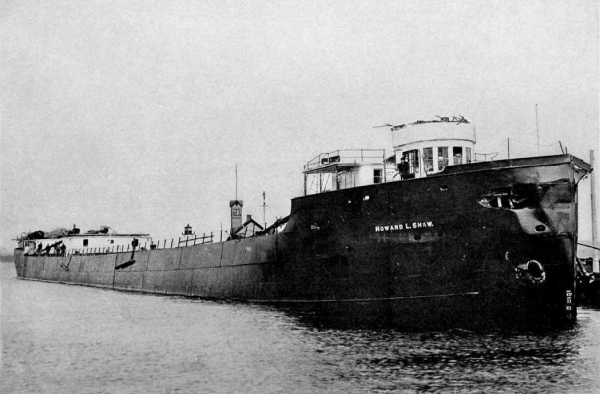
A Steamer Stripped by a Tow-Line by Running between a Steamer and her Consort.
From a Photograph by Lord & Rhoades, Sault Ste. Marie, Mich.
This possibility of the actual overcrowding, of the Lakes is one that I have discussed with half a hundred91 captains and owners. It offers a new “future” for romance and tragedy on the Great Lakes. Since the day the first strong-hearted explorers sailed up the Inland Seas on the Griffin, the unusual, the tragic, and the romantic have made up thrilling chapters in their history—chapters in battle, piracy, and adventure, whose heroes and their exploits rank on even terms with Paul Jones, Kidd, Morgan, Hudson, and other worthies of the open seas. The romance of the old days, as upon the ocean, is gone; a new romance has taken its place—the romance of iron and steel and steam; and a new and greater peril than that born of wind and storm, many believe, is fast developing to face the fresh-water mariner of the future. This is the peril of collision—not as it exists to-day, but as it may exist a few years from now. Already this peril is an ever-present menace upon the Great Lakes, and hardly a day passes during the season of navigation that collisions do not occur. The Lakes, it is probable, will never be able to take entire care of the enormous commerce of the East and West, and as a result ships will continue to increase until, like the streets of a great city with their rushing automobiles and unceasing pandemonium of cars, vans, and seething multitudes, these water highways will become dangerously crowded with the vehicles of trade. Already the Lake Carriers’ Association seems to foresee the danger of future navigation on the Inland Seas, and has recommended that east and west courses92 be established, so that up-bound vessels will be far out of the path of down-bound ships. This is but the first step toward government legislation, many believe, that will bring about the “cutting up of the Lakes into roads,” when vessels bound for given ports will have prescribed courses to travel, from which they will deviate, unless with good cause, at the risk not only of their safety, but of a heavy fine. Thus, it is probable, will the Lakes be made navigable for the myriad ships of the future, when, in the words of one ship-owner, “A pall of smoke will hover overhead day and night for seven months in the year, and when the world will witness water commerce as it has never existed before, and as it will never exist elsewhere on the globe.”
This is looking into the future; but one acquainted with the Lake life of to-day cannot but see the picture. And this picture brings one to the real motif of this chapter—a description of the “human interest side” of America’s vast “unsalted seas,” that side in which the romantic and the tragic and not the realities of statistics and economic progress play the absorbing parts, and which should serve to make them of interest to hundreds of thousands of people who have yet their first trips to take upon them.
From my twenty years of experience with them, I believe that failure to treat of the human interest of the Lakes is one of the most inexcusable omissions of American literature. In the rush of modern progress93 the Lakes have been forgotten—except in the way of their vital importance to the commerce of the nation. And each year their picturesque and thrilling aspects are becoming more deeply engulfed in considerations of profit and loss and corporation finance.
Not long ago I asked a romantically inclined young woman, who was about to spend the savings of several years on an ocean trip, why she did not take a more economical, and pleasanter, holiday by making a tour of the Lakes. She looked at me as if I had gone out of my head.
“Take a trip on the Lakes when I can have one on the ocean!” she cried. After a moment of continued surprise, she added: “I want something that I can think about. I want to go where something has happened—where there have been battles, and pirates, and where there’s sunken ships, and treasure, and things under us! I’m reading a story now that tells of the ocean—The Cruise of a Lonely Heart—situated in the very part of the sea we’re to cross, and I shall read every word of it over again while we’re aboard the ship!”
That is the great trouble. Historians, novelists, and short-story writers have neglected the Lakes. I did not waste my breath in telling this young lady that real pirates flourished in the days of King Strang and his Mormons on the Lakes; that some of the most picturesque “sea fights” of history were fought upon94 them, and that treasure untold, and mysteries without number, lie hidden within their depths. But I am determined that she shall read these few pages, and I pray that she, as well as a few thousand others of my readers, may hereby be induced to “take to their history.”
For centuries the oceans have been regarded as the realm of romance and mystery. In this age, the youths of Chicago, of New York, Cincinnati, or Denver, and even of Lake cities, search public libraries for tales of the South Seas and of the great Pacific; even the youngster whose every day has been spent on the shores of one of the five Great Lakes seeks afar the material that satisfies his boyish imagination. And so is it with his father and mother, his big brothers and sisters. Instead of a glorious trip over the Lakes, they prefer the old and oft-made journey to Europe, to the Bermudas; instead of seeking out the grand scenery and actual romance that environ them, they follow beaten paths laid out in books and pamphlets descriptive of the ocean.
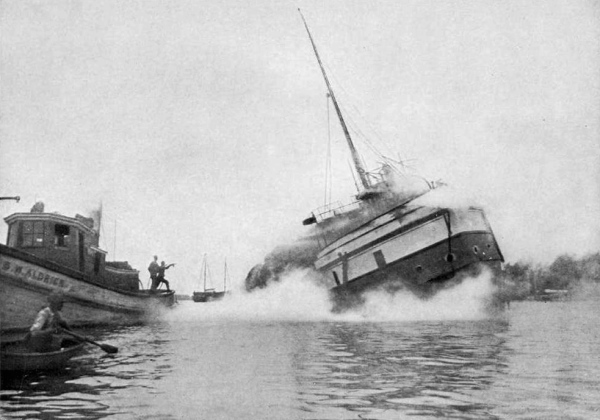
In view of the action already being taken to bring about legislation to prevent collisions, it is interesting to note that no similar area of any ocean, if suddenly robbed of its waters, would expose to human eyes more sunken ships, or more valuable cargoes, than the Great Lakes. During the twenty years between 1878 and 1898, only one less than 6000 vessels were wrecked on the Inland Seas, and 1093 these were95 total losses. The loss of cargo during this period of a little more than one fourth of the years of navigation on the Lakes was nearly $8,000,000, and from this it is quite safe to figure that the total amount of property that has gone to the bottom of the Lakes, including only cargoes, would make a total of at least $15,000,000, involving the wrecking of 14,000 vessels and the total loss of over 2000 ships. Were these “total losses” strung out in a row, there would be a sunken ship at a distance of every half-mile over the thousand-mile length of the Lakes between Buffalo and Duluth. What a field for romance here! What material for the seeker of human achievement, of heroism, of sacrifice! Scores of these vessels disappeared as suddenly and as mysteriously as though some great power had smuggled them from the face of the earth, leaving naught behind to tell of the tragedies; hundreds of ships carried with them valuable cargoes which remain to this day for lucky fortune-hunters to recover from the depths; and in their going thousands of lives were snuffed out, and thousands of unwritten acts of heroism were played and never heard of, or forgotten.
How many remember the name of Captain James Jackson? Jackson is only one of a thousand heroes of the Inland Seas, and the deed which made him famous among Lake seamen is only one of a thousand of a similar kind. It happened one year in the closing days of navigation on Superior. The owners of the96 freighter W. F. Sauber had sent that ship from Duluth with one last load of iron ore under the command of W. E. Morris. Off Whitefish Point the vessel was caught in a fierce storm from the north. All night she weathered the gale, but with morning there came a blinding sleet with fierce wind and intense cold, and the breaking seas froze as they touched the upper works of the ship. Under the increasing weight of ice the disabled Sauber gradually settled. When thus the “little ice devils” of Superior gather upon a victim, it sometimes happens that no power of man can save the ship, and in this instance the crew of the doomed freighter realised that it was only a matter of a short time before the end would come. But strange things happen on the Inland Seas, as on the oceans.
Upon this day, so far as is known, there were just two vessels on Lake Superior, and fate decreed that they should meet off Whitefish Point. While the men of the Sauber were waiting for death, the steamer Yale was tearing her way through the gale toward the “Soo,” and as he passed Captain Jackson sighted the sinking ship. It was then that occurred that act which won him a gold medal and a purse contributed to by hundreds of sailors all over the Lakes.
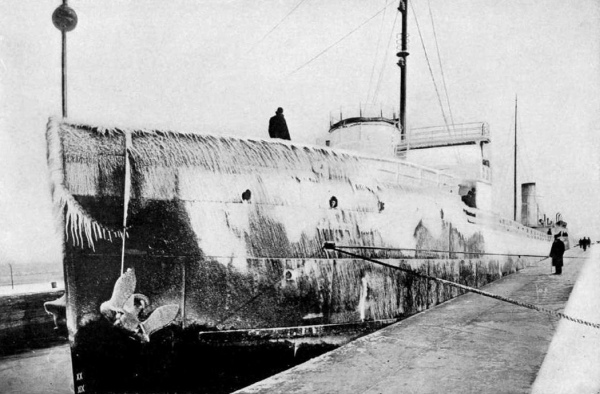
Notwithstanding the peril of his own situation, Captain Jackson brought his vessel to. For hours it was buffeted in the trough of the sea, which was too heavy for small boats to attempt a rescue in. Night came, and the freighters drifted to within a stone’s throw of97 each other. At dawn, when the Yale might have been safely in port, it was found that she, too, was gradually settling, and that the Sauber could not live an hour longer. Captain Jackson at once called for volunteers willing to risk their lives in an attempt at rescue; he himself went out in the first boat. If bravery was ever rewarded it was then. Every member of the Sauber’s crew, with the exception of the captain, was carried to the Yale. At the last moment Captain Morris attempted to lower himself into one of the boats—hesitated—then leaped back to the deck of the sinking ship.
“Go on, boys!” he shouted through the gale. “Good luck to you, but I’m going to stay with the old boat!”
This is heroism, sacrifice, faithfulness, as they are bred on the Inland Seas.
Thirty minutes later the Sauber went under, and immediately after the explosion of her deck, caused by the pressure of air and water, those who were still courageously waiting in a small boat heard the last cries of Captain Morris rising above the gale.
These “last days of navigation”—the season when life and property are hazarded by crews and captains with a recklessness that thrills one’s blood—are justly dreaded, and I have been told by a hopeful few that the time is coming when proper legislation will send ships into winter quarters earlier than now. It is at this time that casualties multiply with alarming rapidity, the perils of Lake navigation becoming tenfold98 as great as those of the ocean. Heavy fogs hide the beacons that mark the danger lines. Blinding snowstorms blot out the most powerful lights. Driven by fierce gales, weighted by ice, with heaven and sea meeting in a pall that conceals the guiding stars ashore, scores of vessels continue to beat onward in the hope of adding one more successful trip to their season’s record.
The history of a Lake Superior tragedy is simple. One more trip from Duluth may mean thousands of dollars. The season is late—too late. But freight rates are high. No risk, no gain, argues the ship-owner, as he sends his vessel from port. Those are days of anxiety for captain, crew, and owner. In a few hours the clear sky may give place to banks of snow clouds. The air turns bitter cold. Darkness falls in the middle of the afternoon. The snow descends in dense clouds. It is far worse than the blackest night, for it shuts out the lights along the treacherous shores as completely as a wall of mountains. Upon the captain alone now depends the safety of the ship, for the Government’s attempts to aid him are futile. Perhaps his vessel is safely making her course miles from the coast. Or it may be that it is driving steadily toward its doom upon the dreaded Pictured Rocks. It was in this way that the steamer Superior was lost with all on board, and in the same way the Western Reserve beat herself to pieces within sight of the Big Sable light. And Superior has a harder fate in store99 for many of those who take the last ill-fated trip of the season. Sailors dread it more than the tragedy of dense snowstorms, when they run upon the rocks, for even there hope does not die; they dread it more than the fierce, sledge-hammer wash of Erie in a storm; more than the fearful dash for port in Lake Michigan, where ports are few; and this fate is the fate of “the little ice devils”—those masses of ice which freeze upon a ship until she is weighted beyond control.
In these days of late navigation—days of fierce battles with snow, ice, and wind, days of death and destruction as they are never known upon the salt seas—is material for a generation of writers; unnumbered stories of true mystery, true romance, and true tragedy, which, if fed to the nation in popular form, would be of immeasurable value to lovers of the literature of adventure. Into what a fascinating tale of mystery, for example, might the loss of the Queen of the West be turned! And, yet, here is a case where truth is in reality stranger than fiction, and possibly an editor might “turn down” the tale as too improbable. Recently I chronicled a true romance of the Lakes. I had dates, names of ships, names of people, and even court records to prove the absolute verity of my story, which was related in the form of fiction. I sent it to several editors who had published other stories of mine, and one after another they returned it, saying that while my proofs were conclusive, the story was so unusual in some of its situations that their readers100 would consider the tale as a gross exaggeration of anything that might occur on the Great Lakes!
Well, here is the story of the Queen of the West—only one of scores of Lake incidents equally unusual; and I hope that it will have at least some weight in showing that things can occur on the Inland Seas. In the late navigation days of 1903, the freighter Cordurus left Duluth on a “last trip down.” In mid-lake, the lookout reported a ship in distress, and upon nearer approach the vessel was found to be the Queen of the West, two miles out of her course, and sinking. Captain McKenzie immediately changed his course that he might go to the rescue, at the same time signalling the other vessel to lay to. What was his astonishment when he perceived the Queen of the West bearing rapidly away from him, as though her captain and crew were absolutely oblivious of their sinking condition, as well as of the fact that assistance was at hand!
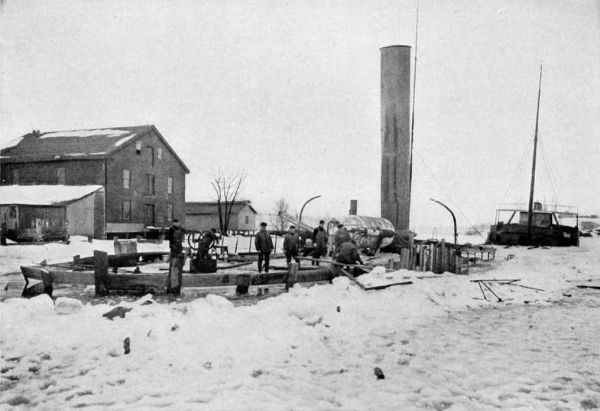
Now began what was without doubt the most unusual “chase” in marine history. Every eye on the deck of the Cordurus could see that the Queen of the West was sinking—that at any moment she might plunge beneath the sea. Was her captain mad? Each minute added to the mystery. The fleeing ship had changed her course so that she was bearing directly on to the north Superior shore. Added fuel was crammed under the Cordurus’s boilers; yard by yard, length by length, she gained upon the sinking vessel. Excited101 figures were seen waving their arms and signalling from the Queen of the West’s deck. But still the ship continued on her mysterious flight. At last Captain McKenzie came within hailing distance. His words have passed down into Lake history:
“You’re sinking, you idiot! Why don’t you heave to?”
“I know it—but I can’t,” came back the voice of the Queen of the West’s captain. “We’re almost gone and if we stop our engines for a second we’ll go down like a chunk of lead!”
Not stopping to consider the risk. Captain McKenzie ran alongside. The Queen of the West’s engines were stopped and her crew clambered aboard. Hardly had the Cordurus dropped safely away when the doomed ship went down. Her momentum alone had kept her from sinking sooner.
One of the most thrilling and interesting pages in the history of Great Lakes navigation, despite the comparative smallness of these fresh-water seas, is made up of “mysterious disappearances.” Ships have sailed from one port for another, and though at no time, perhaps, were they more than ten to thirty miles from shore, they have never been heard from again. Of some not even a spar or a bit of wreckage has been found. Only a few years ago the magnificent passenger steamer Chicora left St. Joseph, Michigan, for Chicago on a stormy winter night. She was one of the finest, staunchest, and best-manned vessels on102 the Lakes. She sailed out into Lake Michigan—and thence into oblivion. Not a soul escaped to tell the story of her end. Through the years that have passed no sign of her has ever been found. Wreckers have sought for her, people along the shore have watched for years; but never a memento has the lake given up from that day to this. And this is only one of the many mysteries of the Inland Seas.
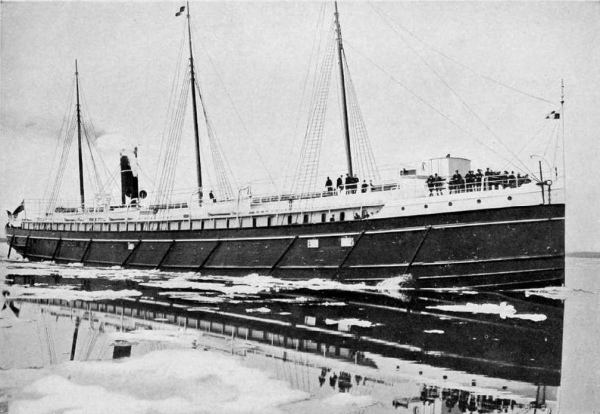
A Treacherous Sea in its Garb of Greatest Beauty.
One phase of Lake navigation.
Captains and sailors theorise and wonder to this day on the loss of the Atlanta, which went down in Lake Superior; and wonderful stories are told of the disappearance of the Nashua, the Gilcher, and the Hudson, and of the nameless vessels spoken of by old Lake mariners as “The Two Lost Tows” of Huron. The disappearance of these tows remains to this day unexplained. During the night the line which held them to their freighter consort parted and unknown to the steamer they fell behind. With the coming of dawn search was made for them, but in vain. What added to the uncanniness of the simultaneous disappearance of the two vessels was the fact that there was no storm at the time. No trace of the missing ships has ever been found. Almost as mysterious was the disappearance of the crack steamer Alpena in Lake Michigan. When last seen she was thirty miles from Chicago. From that day to this no one has been able to say what became of her. Of the fifty-seven people who rode with her that tragic night, not one lived to tell the tale.
103 Of all Lake mysteries, that of the Bannockburn is one of the freshest in the memory. The ill-fated vessel left Duluth in the days of the “ice devils,” a big, powerful freighter with a crew of twenty-two men. What happened to her will never be known. She went out one morning, was sighted the next evening—and that was the last. Not a sign of her floated ashore, not one of her crew was found. For eighteen months the ice-cold waters of Lake Superior guarded their secret. Then one day an oar was found in the driftwood at the edge of the Michigan wilderness. Around the oar was wrapped a piece of tarpaulin, and when this was taken off, a number of rude letters were revealed scraped into the wood—letters which spelled the word B-a-n-n-o-c-k-b-u-r-n. This oar is all that remains to-day to tell the story of the missing freighter. And now, by certain superstitious sailors, the Bannockburn is supposed to be the Flying Dutchman of the Inland Seas and there are those who will tell you in all earnestness that on icy nights, when the heaven above and the sea below were joined in one black pall, they have descried the missing Bannockburn—a ghostly apparition of ice, scudding through the gloom. And this is but one more illustration of the fact that all of the romance in the lives of men who “go down to the sea in ships” is not confined to the big oceans.
Unnumbered thousands of tourists travel over the Lakes to-day with hardly a conception of the unrevealed interests about them. What attracts them is104 the beauty and freshness of the trip; when they go upon the ocean they wonder, and dream, and read history. Tragedy has its allurement for the pleasure-seeker, as well as romance; and while certain phases of tragedy are always regrettable, it is at least interesting to be able at times to recall them. The Lake traveller, for instance, would feel that his trip had more fully repaid him if his captain should say, pointing to a certain spot, “There is where Perry and his log ships of war met the British: the battle was fought right here”; or, “There is where the Lady Elgin went down, with a loss of three hundred lives.”
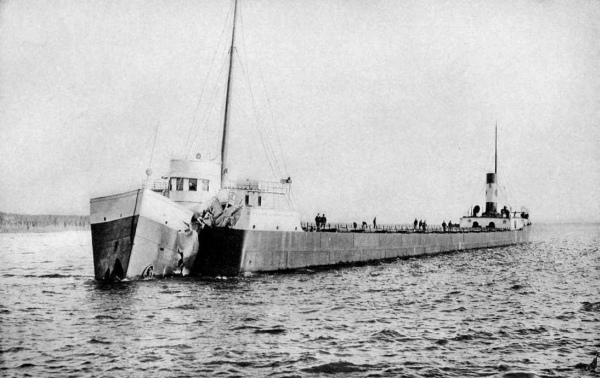
A View of the “Zimmerman.”
After a collision with another freighter.
Three hundred lives! The ordinary modern tourist would hold up his hands in incredulous wonder. “Is it possible,” he might ask, “that such tragedies have occurred on the Lakes?” I doubt if there are many who know that upon the Lakes have occurred some of the greatest marine disasters of the world. On September 8, 1860, the Lady Elgin collided with the schooner Augusta and went down in Lake Michigan, carrying with her three hundred men, women, and children, most of whom were excursionists from Milwaukee. Two months later the propeller Dacotah sank in a terrific gale off Sturgeon Point, Lake Erie, carrying every soul down with her. Nothing but fragments were ever seen afterward, so complete was her destruction. On the steamer Ironsides, which dove down into one hundred and twenty feet of water, twenty-four lives were lost in full sight of Grand105 Haven. Many vessels, like the Ironsides, have perished with their bows almost in harbour. Less than four years ago, for instance, the big steel ship Mataafa was beaten to pieces on the Duluth breakwater, while not more than thirty or forty rods away thousands of people stood helpless, watching the death-struggles of her crew, who were absolutely helpless in the tremendous seas, and who died within shouting distance of their friends.
Probably the most terrible disaster that ever occurred on the Lakes was the burning of the steamer G. P. Griffin, twenty miles east of Cleveland. The vessel was only three miles from shore when the flames were discovered, and her captain at once made an effort to run her aground. Half a mile from the mainland the Griffin struck a sand-bar and immediately there followed one of the most terrible scenes in the annals of marine tragedy. The boats were lowered and swamped by the maddened crowd. Men became beasts, and fought back women and children. Frenzied mothers leaped overboard with their babes in their arms. Scorched by the flames, their faces blackened, their eyes bulging, and even their garments on fire, over three hundred people fought for their lives. Men seized their wives and flung them overboard, leaping after them to destruction; human beings fought like demons for possession of chairs, boards, or any objects that might support them in the water, and others, crazed by the terrible scenes about them,106 dashed into the roaring flames, their dying shrieks mingling with the hopeless cries of those who still struggled for life. From the shore scores of helpless people, without boats, or any means of assistance, watched the frightful spectacle, and strong swimmers struck out to give what aid they could. Only a few were saved. For days scorched and unrecognisable corpses floated ashore, and when the final death-roll was called, it was found that 286 lives had gone out in that frightful hour of fire.
Is there a more tragic page in the history of any ocean than this?—a page to which must still be added the burning of the steamer Erie, with a loss of one hundred and seventy lives, the sinking of the Pewabic with seventy souls off Thunder Bay Light, in Lake Huron, the loss of the Asia with one hundred lives, and scores of other tragedies that might be mentioned. The Inland Seas have borne a burden of loss greater in proportion than that of any of the salt oceans. Their bottoms are literally strewn with the bones of ships and men, their very existence is one of tragedy coupled with the greatest industrial progress the world has ever seen. But there are no books descriptive of their “attractions,” no volumes of fiction or history descriptive of those “thrilling human elements” that tend to draw people from the uttermost ends of the earth. This field yet remains for the writers of to-day.
And romance walks hand in hand with tragedy on107 the Inland Seas. For two or three years past a new epidemic has been sweeping the world, an epidemic which has attracted attention in every civilised land and to which I might give the name “treasuritis”—the golden ignis fatuus of hidden treasure which is luring men to all parts of the world, and which is bringing about the expenditure of fortunes in the search for other fortunes lost on land or at sea. While South Sea treasure-hunts have been exploited by newspapers and magazines, while Cocos Island and the golden Pacific have overworked the imaginations of thousands, few have heard of the treasure-hunts and lost fortunes of the Lakes. So businesslike are these ventures of the Inland Seas regarded by those who make them, that little of romance or adventure is seen in them.
How treasures are lost, and sometimes found, in the depths of the Great Lakes is illustrated in the tragic story of the Erie. This vessel, under command of Captain T. J. Titus, left Buffalo for Chicago on the afternoon of August 9, 1841. When thirty-three miles out, off Silver Creek, a slight explosion was heard and almost immediately the ship was enveloped in flames. In the excitement of the appalling loss of life that followed, no thought was given to a treasure of $180,000 that went down with her—the life savings of scores of immigrants bound for the West. For many years the Erie lay hidden in the sands, seventy feet under water. In 1855, a treasure-seeking party left Buffalo,108 discovered the hull, towed it into shallow water, and recovered a fortune, mostly in foreign money.
Not very long ago a treasure-ship came down from the North—the William H. Stevens, loaded with $101,880 worth of copper. Somewhere between Conneaut, Ohio, and Port Burwell, Ontario, she caught fire and sank. For a long time unavailing efforts were made to recover her treasure. Then Captain Harris W. Baker, of Detroit, fitted out a modern treasure-hunting expedition that was as successful in every way as the most romantic youngster in the land could wish, for he recovered nearly $100,000 worth of the Stevens’s cargo, his own salvage share being $50,000.
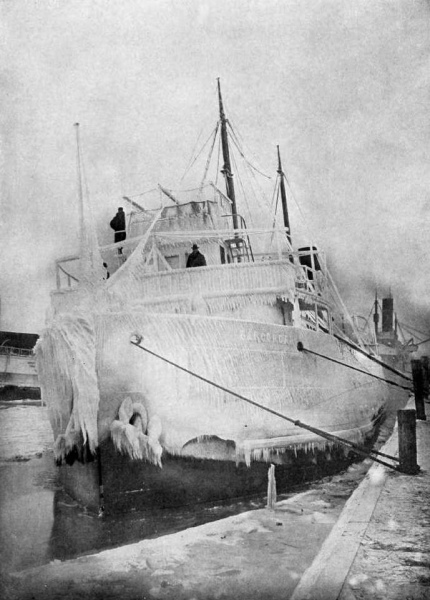
The Steamer “Wahcondah.”
One of the Lake grain carriers which was caught in a storm late in the season after being buffeted by the waves of Lake Superior for about fourteen hours.
While there have been many fortunes recovered from the bottoms of the Lakes, there are many others that still defy discovery. Somewhere along the south shore of Lake Erie, between Dunkirk and Erie, lies a treasure-ship which will bring a fortune to her lucky discoverer, if she is ever found. One night the Dean Richmond, with $50,000 worth of pig zinc on board, mysteriously disappeared between those two places. All hands were lost and their bodies were washed ashore. In vain have search parties sought the lost vessel. The last attempt was made by the Murphy Wrecking Company, of Buffalo, which put a vessel and several divers on the job for the greater part of a season. In the deep water of Saginaw Bay lies the steamship Fay, with $20,000 worth of steel billets in her hold; and somewhere near Walnut Creek, in109 Lake Erie, is the Young Sion, with a valuable cargo of railroad iron. Off Point Pelee is the Kent, with a treasure in money in her hulk and the skeletons of eight human beings in her cabins; and somewhere between Cleveland and the Detroit River is a cargo of locomotives, lost with the Clarion. In Lake Huron, near Saginaw Bay, are more lost ships than in any other part of the Great Lakes, and for this reason Huron has frequently been called the “Lake of Sunken Treasure.” In the days when the country along the Bay was filled with lumber-camps, large sums of money were brought up in small vessels, and many of these vessels were lost in the sudden tempests and fearful seas which beset this part of Huron. Beside these treasure lumber barges, it is believed that the City of Detroit, with a $50,000 treasure in copper, lies somewhere in Saginaw Bay. The R. G. Coburn, also laden with copper, sank there in 1871, with a loss of thirty lives. Although searches have been made for her, the location of the vessel is still one of the unsolved mysteries of the Lakes.
That treasure-hunting is not without its romance, as well as its reward, is shown by the case of the Pewabic. This vessel, with her treasure in copper, disappeared as completely as though she had been lifted above the clouds. Expedition after expedition was fitted out to search for her—a search which continued over a period of thirty years. In 1897, a party of fortune-seekers from Milwaukee succeeded in finding the long-110lost ship six miles south-east of Thunder Bay. Another terrible event was the loss of the steamer Atlantic, off Long Point, Lake Erie, with three hundred lives. For many years, futile search was made for her; not till nearly a quarter of a century was she found, and $30,000 recovered.
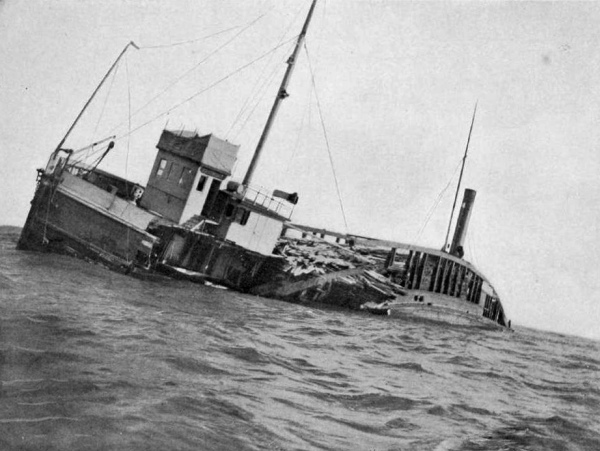
This is One of the Most Remarkable Photographs ever Taken on the Lakes. It Shows a Sinking Lumber Barge just as She Was Breaking in Two.
The Photograph was taken from a small boat.
Whisky and coal form quite an important part of the treasure which awaits recovery in the Inland Seas. Many vessels with cargoes of whisky have been lost, and this liquor would be as good to-day as when it went down. In 1846, the Lexington, Captain Peer, cleared from Cleveland for Port Huron, freighted with one hundred and ten barrels of whisky. In mid-lake, the vessel foundered with all on board, and though more than sixty years have passed, she has never been found. To-day her cargo would be worth $115 a barrel. The Anthony Wayne also sank in Lake Erie with three hundred barrels of whisky and of wine; and five years afterwards, the Westmoreland sank near Manitou Island with a similar cargo. These are only a few of many such cargoes now at the bottom of the Lakes. Of treasure in lost coal, that of the Gilcher and Ostrich, steamer and tow, that disappeared in Lake Michigan, is one of the largest. The two vessels carried three thousand tons, and as yet they have not been traced to their resting place. In 1895, the steamer Africa went down in a gale on Lake Huron, carrying two thousand tons of coal with her, and at the bottom of Lake Ontario is the ship St. Peter, with a big cargo111 of fuel. It is estimated that at least half a million dollars in coal awaits recovery at the bottom of the Lakes.
But, after all, perhaps the most romantic of all disappearances on the Inland Seas is that of the Griffin, built by La Salle at the foot of Lake Erie, in January, 1679. The Griffin sailed across Lake Erie, up the Detroit River, and continued until she entered Lake Michigan. In the autumn of 1680, she started on her return trip, laden with furs and with $12,000 in gold. She was never heard of again, and historians are generally of the opinion that the little vessel sank during a storm on Lake Huron.
Or it may be that one must choose between this earliest voyager of the Lakes and that other shrouded mystery—the “Frozen Ship.” Lake Superior has been the scene of as weird happenings as any tropic sea, and this of the Frozen Ship, perhaps, is the weirdest of all. She was a schooner, with towering masts, of the days when canvas was monarch of the seas; and the captain was her owner, who set out one day in late November for a more southern port than Duluth. And then came the Great Storm—that storm which comes once each year in the days of late navigation to add to the lists of ships and men lost and dead—and just what happened to the schooner no living man can say. But one day, many weeks afterward, the corpse of a ship was found on the edge of the pine wilderness on the north Superior shore; and around112 and above this ship were the tracks of wild animals, and from stem to stern she was a mass of ice and snow, and when she was entered two men were found in her, frozen stiff, just as the “Frozen Pirate” was discovered in a story not so true.
So might the tragedy and the romance of the Inland Seas be written without end, for each year adds a new chapter to the old; and yet, how many thousands of our seekers of novelty say, with the young woman I know, “I want to go where something has happened—where there have been battles, and pirates, and where there’s sunken ships, and treasure, and things!”
Is the day approaching when Buffalo and not Chicago will be the second largest city in the United States? and when, at the end of Lake Superior, her back doors filled with the treasures of the earth and with a developed empire about her, Duluth will claim a million inhabitants? Is the day far distant when the world’s greatest manufacturing city will be located on the Niagara River? and when, as steel men all the world over believe, Duluth will be a second and perhaps greater Pittsburg?
These are questions which have never been of greater interest than now, when the State of New York is expending over a hundred million dollars on the new Erie Canal, thus “bringing Buffalo and the Lakes to the sea,” and when, at the same time, the United States Steel Corporation is devoting ten million dollars to the erection of the most modern steel plant in the world at Duluth.
“Buffalo is the great doorway of the Inland Seas,” said President McKinley only a short time before114 his tragic death. “Some day she will reach out to the ocean, and when that time comes she will be one of the greatest cities in the world.” For many years the people of Buffalo have dreamed of this. And now it is coming true. And while the Pittsburger, entrenched in the prosperity of steel and fortified behind the smoke of his own mills, has been laughing at prophecies, away up at the end of the thousand-mile highway that leads to Duluth, other people have been dreaming. And their dreams, too, are coming true. For years the silent struggle for the supremacy of cities has been in progress along the Great Lakes. The outside world has seen little of it, and has heard little of it. Now the beginning of the end is at hand. The two great doors of the Inland Seas have been opened wide. At one end is Duluth, at the other Buffalo. Chicago is great, Buffalo may be greater. Pittsburg, like ancient Rome, feels that hers is to be a reign unbroken, and that she will still be “Pittsburg, Queen of the World of Steel” until the last call of Judgment Day. In another ten years—perhaps in less time—she will recognise the power of her rival in the North.
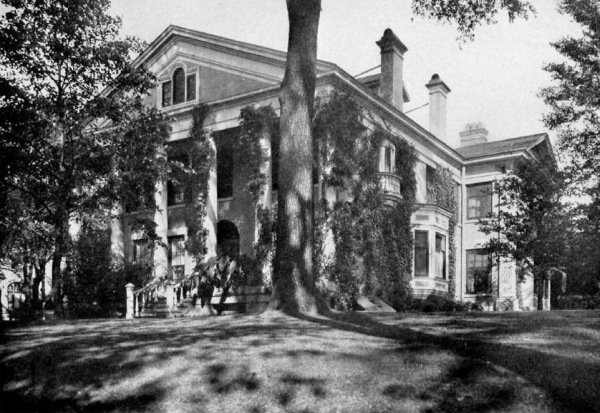
The Residence of A. Wilcox at Buffalo.
Where President Roosevelt took the oath of office.
Copyright 1908 by Detroit Photographic Co.
These are predictions, but they are well founded. To find just why they are made, one must go among the powerful men of the Lakes, among the iron barons of the North and the coal barons of the South and East—must, in short, become acquainted with the entire commercial and industrial mechanism which115 exists on the Great Lakes to-day. They are not predictions that can be arrived at from New York, or San Francisco, or London, or Liverpool. One must talk with the men who make them, must live among those commercial and industrial conditions for a long time, and must know at first hand the two cities we speak of—Buffalo and Duluth. They are predictions which have a solid foundation of facts, and these facts are what make these two cities the most interesting as well as the most important ports in the Western World, with the exception of New York City. I venture to say that only a ridiculously small percentage of our own people—of Americans, whose very existence as an industrial and commercial power depends largely upon the Lakes—know these two cities beyond their names, their location, and possibly the number of their inhabitants. How many, for instance, know that to-day Duluth is the second greatest freight-shipping port on earth; that London, the capital of the British Empire, queen of the world’s commerce for many years, has abdicated in favour of a port so remote from the heart of British commercial enterprise that it is doubtful if fifty thousand of the five million people of London have ever heard of the name of the city which has taken the place of the world’s metropolis in the list of the great harbours of the world? And how many know, as well, that within a single night’s ride of the city of Buffalo—within a radius116 of less than five hundred miles—live sixty per cent. of the total population of North America?
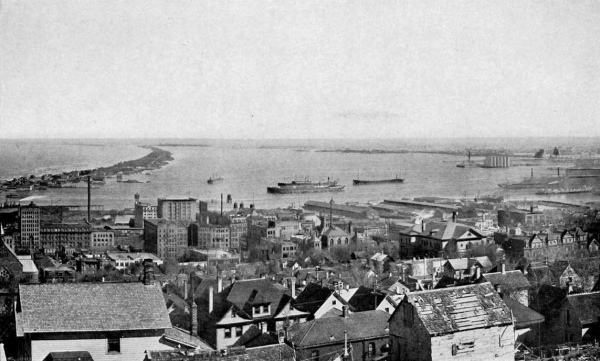
A Bird’s-eye View of the Harbour of Duluth, Taken from the Hill.
From a Photograph by Maher, Duluth.
These are only two of the remarkable facts about Buffalo and Duluth, the Alpha and Omega of the Inland Seas. That they are now two of the greatest freight-distributing points in the United States is shown by figures; that within the next generation they will become the two greatest distributing cities in the world is almost a certainty. It is not only Lake commerce that assures their destinies. Logically, they are situated to rule the world of commerce in the United States. Duluth is approximately midway in the continent, with a clear waterway soon to reach to the ocean, and with the great West behind her already webbed, with Duluth as the centre, by thirty-seven thousand miles of rail; and Buffalo, with sixty million people within five hundred miles of her City Hall, with fifteen great trunk-lines entering the city, with the greatest electrical power of the age at her doors, with “one hand on the ocean and the other on the Inland Seas,” holds a position which no other city can ever hope to attain. According to H. C. Elwood, Chairman of the Transportation Committee of the Chamber of Commerce of Buffalo, the combined rail and water tonnage of that city is not exceeded by that of any other city in the United States, with the exception of Pittsburg. And the story of Buffalo’s commerce has just begun. In 1885, Buffalo’s total tonnage of iron ore received117 by Lake was only a little more than eight thousand,—less than the single cargo carried by one of the great freighters of the Inland Seas to-day! Last year it was five and a half millions. The position that both Buffalo and Duluth hold in the commerce of the Lakes is briefly told in figures. Of the total tonnage of ninety-seven million carried on the Lakes in 1907, more than fourteen and a half million were registered at Buffalo and thirty-five million at Duluth-Superior. In other words, over a half of the total tonnage of the Lakes passed in or out of these two great doors of the Inland Seas in 1907.
There are few cities in the world to-day in which romance and adventure have combined in more extraordinary ways with calamity, failure, and indomitable courage than in the upbuilding of Duluth. Chiselled back into the rocky hillsides, terrace upon terrace, and stretching for miles along the bay front where only a quarter of a century ago was the wild and rugged grandeur of virgin wilderness; built upon rock, and in rock; looking down upon one of the finest harbours in the world on one hand, and up over vast regions red with iron treasure on the other, Duluth is one of the most beautiful cities in the United States—one of the most wonderful and most interesting. Twenty-five years ago, only a village marked this stronghold of the iron barons. The deer, the wolf, the bear, the moose roamed unafraid over places now alive with commercial activity. Into the vast118 unexplored wildernesses, even less than a dozen years ago, prospectors went out with their packs and their guns, and searched and starved and even died for the “ugly wealth” hidden in the ranges that are now giving to the world three quarters of its iron and steel. And to-day many of these same men, “whose callouses of the old prospecting days have hardly worn away,” live in a city of eighty thousand people, whose annual receipts from its industries aggregate fifty-five million dollars, and whose invested wealth is over one hundred and fifty millions. While London, Liverpool, Hamburg, Antwerp, Hong-kong, and Marseilles have had eyes for New York alone in this Western World, while the ports of ancient and historic renown have been struggling among themselves for supremacy, away up at the end of the Lake Superior wilderness the second greatest freight-shipping port in the world was building itself, quietly, unobtrusively, unknown. That is the story of Duluth in a nutshell.
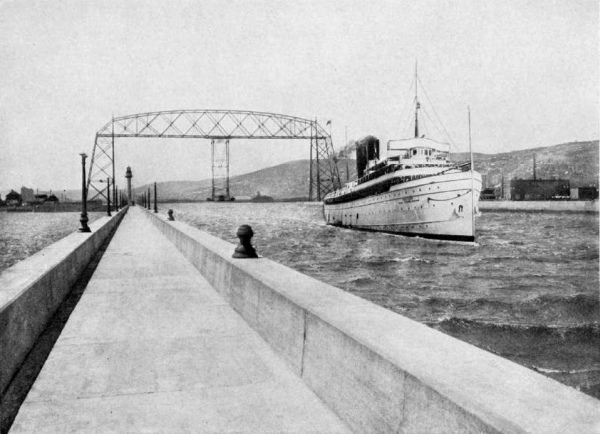
The Ship Canal and Aërial Bridge, Duluth, Minn.
Copyright 1908 by Detroit Photographic Co.
But it is only the first chapter. The others will be written even more quickly, perhaps with even greater results. The commerce of America’s five Inland Seas has but just commenced, and the growth of this commerce and the growth of Duluth go hand in hand. In 1892, for instance, only four thousand tons of ore were shipped from the Duluth-Superior harbour; in 1907, including the sub-port of Two Harbours, the total was nearly thirty millions! And this same percentage of increase holds good with other119 products. Fifteen years ago very few people along our seaboards would have recognised the name of Duluth; to those who knew the town it was often an object of ridicule—the “pricked balloon,” the “town of blasted hopes.” Yet in 1907, this same town, still unknown in a large sense, handled one sixth of the combined tonnage of all the two hundred and forty shipping ports on the coast of the United States. During the two hundred and fifty days of navigation in 1907, an average of fifty-six vessels entered or left Duluth each day, or one ship every twenty-six minutes, day and night, for eight months. These vessels carried cargoes valued at two hundred and eighty-eight million dollars. In other words, over a million dollars a day left or entered Duluth-Superior harbour.
Not long ago a writer who was seeking information on the possibilities of our inland waterways asked me what would happen when, as experts predicted, the ore of the North became exhausted. “Where will Duluth be then?” he questioned. This is what nine people out of ten ask, who are at all interested in the future of Duluth. There seems to be an almost universal opinion among people who do not live along the Lakes that, with the exhaustion of the great iron deposits, the commerce of our Inland Seas will dwindle. A more near-sighted supposition than this could hardly be imagined. At the present time ore is the greatest object of commerce on the Great120 Lakes, and it will continue to be so for many years. It is safe to say that the day is not far distant when fifty million tons of iron ore, instead of thirty million, will leave Duluth each year; and at the same time millions of tons of steel will be leaving by rail. But Duluth’s great future does not rest on iron and steel alone. As I have said, thirty-seven thousand miles of rail already reach out from the city into the vast agricultural regions of the West. It is the one logical doorway of the vast empire at its back, to which it offers the cheapest and shortest route to the Atlantic and Europe; just as it must become the great distributing point through which the bulk of the vast commerce of the East will flow into the West. There is more agricultural and grazing land tributary to it than to any other port in America. And Minnesota is still one of the great timber States of the country in spite of the vast scale on which lumber operations have been carried on within its boundaries during the past few years. Lake, Cook, and other northern counties (several of these counties are each as large as a small State) possess great forest wealth, and for many years to come Duluth will be the great lumber-shipping port of the Lakes.
These are a few of the reasons why Duluthians see in their city a future metropolis of perhaps a million people.
Though a large part of the almost endless fertile regions behind it are still undeveloped, Duluth has121 already become the great grain-shipping port of the world. In 1907, over eighty million bushels of grain were shipped from the Duluth-Superior harbour, or a bushel for every man, woman, and child in the United States. There was a time when it was thought that Chicago would always be the greatest grain port on earth. But that time has passed. Of the grain received at Buffalo in 1907, less than forty-two million bushels came from Chicago, while more than sixty-three million were shipped from Duluth-Superior. And this grain traffic is growing even more rapidly than the ore traffic. Ships can hardly be built fast enough to handle the volumes of wheat, oats, barley, and flax that come by rail into Duluth. The city can handle one thousand cars a day, or a million bushels, and yet this is not fast enough. So great is the crush at times that cars of grain are lost for three weeks in the yards! In the not distant future, Duluth will be handling two thousand cars a day. Not only wheat, oats, corn, rye, and barley are pouring into Duluth from the West, but she has now taken first place as shipper of flaxseed, nearly twenty million bushels having left Duluth-Superior harbour last year. Just what this quantity of flaxseed means very few people unacquainted with that product can realise. Take the four hundred thousand bushels brought down to Buffalo by the D. R. Hanna in a single trip, for instance. It was loaded in seven hours and was the product of forty thousand acres,122 or sixty-two square miles. It was worth $460,000, and would make one million gallons of linseed oil.
Probably the most memorable day in the history of Duluth was April 1, 1907, for on that day official notice was received from New York that the Steel Corporation had decided to establish an iron and steel plant in Duluth. At first it was planned to cost ten million dollars. Now it is believed that much more than this will be expended. Preliminary work has already commenced, and within a year and a half it is expected that the plant will be in operation. This movement on the part of the great corporation that rules the world of steel is for several reasons the most interesting that it has ever made. For years, the ore of the North has been carried a thousand miles to the smelters of the East. To reach Pittsburg, it was not only transported that thousand miles, but was loaded three times and unloaded three times. And, meantime, while millions of dollars were being expended on the transportation of ore, while cities half-way across the continent existed and were growing because of their smelters, the city of Duluth, with the vast iron deposits at her back door, was not making a ton of steel. This is one of the mysteries which the Steel Corporation does not explain; but it is fair to assume that hitherto there has not been a sufficient market for the products of such a plant within paying reach of this port.
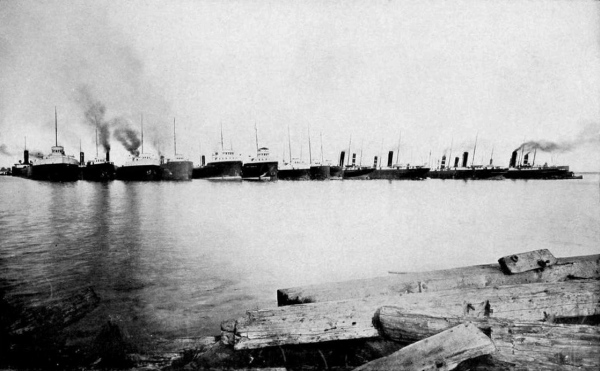
The new plant will bring thirty thousand people123 to Duluth—and this is not the end. Those who are acquainted with the situation say that it is but the first step in the making of a second Pittsburg. “The steel industry,” they say, “brought almost a million people and billions of dollars to Pittsburg—a city a thousand miles from its ore, and without natural advantages. What, then, will it mean to Duluth, with its strategic position on the great highways of commerce, with its cheap water-power, and above all with its ore ready to be dumped direct from the mine cars into the smelters?”
In short, the dreams of Duluth’s old “boomers” are coming true. The great East, with its railroad and manufacturing development, has been supplied with its steel—from Pittsburg. Now it is the West and South-west, and the Orient, to which our great volumes of steel trade will turn. It is Duluth’s chance. Because the ore is at her doors, she can turn out iron and steel cheaper than any other city in the world; and she is the nearest distributing point to the West. This movement to Duluth is inevitable. The world’s steel industry has been constantly moving and changing. Since 1564, the centre of the industry has moved from Birmingham, England, from Lynn through Connecticut to New Jersey, then to Philadelphia, and lastly to Pittsburg, where it has remained for fifty years. Of late years, the tendency has been westward, the movement culminating in Chicago. Now it is centring in Duluth. In a way, Duluth’s124 history will be similar to that of Pittsburg. Duluth and Superior, twin cities with one harbour and identical interests, cannot follow the example of Pittsburg and Allegheny, and unite politically, as State lines divide them, Duluth being in Minnesota and Superior in Wisconsin; but commercially they are fast becoming one. Together they will not only head the ports of the world, probably for all time to come, but will become one of the greatest manufacturing centres on the continent. With a harbour frontage of forty-five miles, with electrical power from the St. Louis Falls second only to that of Niagara, with iron and steel at her doors, and with a world-market behind her, Duluth, already the largest coal-receiving port in the world, possesses manufacturing advantages beyond those of any other city on the continent, with the exception of Buffalo. There are good reasons why this coming Pittsburg of the North will never equal Buffalo in population and commercial activity; there are just as good reasons why no other city in the United States, with the exception of New York and Chicago, will equal Buffalo. At the same time, as a member of the Steel Corporation said to me: “If steel and only a few natural advantages made Pittsburg what it is—what will steel, and all the natural advantages in the world, do for Duluth?”
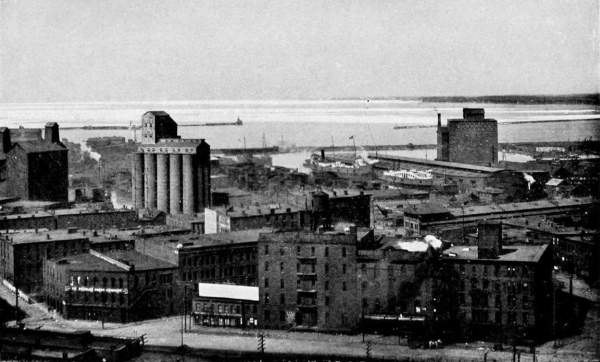
Of course it is not possible to conceive that Duluth, even as a great steel city, would use more than a small fraction of the enormous ore tonnage that is125 annually taken from the Minnesota ranges. If millions of dollars were spent each year in the erection of new steel plants in Duluth, even the annual increase of ore taken from the mines could not be used at home for a long time to come. The ore traffic on the Lakes is bound to become larger even as Duluth develops into a steel city. And a constantly increasing percentage of this ore is going to Buffao—not to be transhipped to Pittsburg, but to be converted into iron and steel in that city. I believe that very few people are aware of the fact that Buffalo is already an important iron- and steel-making plant. The largest independent steel-making plant in the United States is now in operation in South Buffalo. This is the Lackawanna Iron and Steel Company, capitalized at sixty million dollars, employing between six and ten thousand men, and undergoing constant enlargement. The plants of the New York Steel Company and the Wickwire Steel Company are now in course of construction on the Buffalo and Niagara rivers, and other steel- and iron-making plants are in operation. Each year sees Buffalo drawing more and more ore away from the Pittsburg smelters. In 1900, Buffalo made only three hundred and seventy thousand tons of pig-iron. In 1907, the production was one million three hundred and fifty thousand tons, and in 1909 there will be a considerable increase. A recent investigation showed that the many great iron-producing and iron-working plants which extend126 along the navigable waters of the Buffalo have doubled their pay-rolls and almost trebled their production since 1900. The same investigation brought forth the fact that a ton of foundry iron can be produced in Buffalo for sixty-three cents less than in Pittsburg. After a year’s study of the situation in Buffalo, Mr. Elisha Walker, the international expert in iron and steel manufacture, said that, in a few years, Buffalo would rival Pittsburg in the use of iron ore.
While steel plants are generally the most powerful agents that work for the increase of a city’s population and wealth, and while it is true that scores of smaller users of iron and steel are flocking to Buffalo, just as other hundreds grouped themselves about the big parent furnaces in Pittsburg, Buffalo’s great future does not depend upon her development as a steel-manufacturing city. As F. Howard Mason, then Secretary of the Buffalo Chamber of Commerce, said to me: “Buffalo has more than one iron in the fire. Steel is but one of many things that will make her a city of millions a quarter of a century from now.”
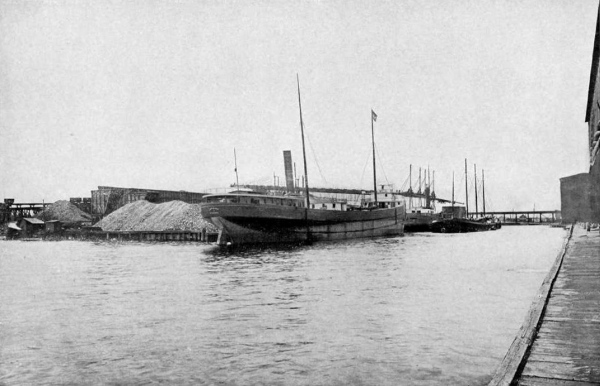
From my own investigations and from my own close study of Lake traffic, I feel confident in saying that, although Buffalo is one of the important ore-converting centres of the country, steel and iron are not the most important of the agents that will work for her future greatness. This may seem inconceivable to those who live in cities the very existence127 of which depends upon iron and steel; yet it is one of the soundest arguments for the optimistic opinion that Buffalo is destined to become the third, if not the second, largest city in the United States. Just as Duluth is the logical shipping and receiving port of the West, so is Buffalo the great receiving and distributing port of the East. Cleveland will always be an important Lake port, but it is impossible to compare its destiny with that of Buffalo. With the new Erie Canal in operation, lake highways from west to east will lead to Buffalo as surely as all roads led to old Rome. This year the total tonnage of Buffalo harbour, which is closed for at least four months of the year, will be considerably greater than that of Liverpool. Of the products passing through the Detroit River in 1907, ninety per cent. of the hard coal was shipped from Buffalo, seventy-five per cent. of the flour and ninety-five per cent. of the wheat came to Buffalo; also seventy-five per cent. of the corn, ninety-eight per cent. of the oats, ninety per cent. of the flaxseed, and ninety-five per cent. of the barley. In other words, Buffalo may be regarded as almost the only receiving port on the Lakes for Western grain.
Mayor Adams hit the nail pretty squarely on the head when he said that Buffalo’s future greatness rests chiefly upon the fact that this city will, within a very few years, be the greatest converting, or manufacturing, point in North America. The cost of128 bringing raw materials to her workshops from all Western points is already reduced to a minimum. The Erie Canal will link her mills with the ocean. The unlimited resources of Niagara furnish her with the cheapest power in the world. Her proximity to the coal-fields provides her with fuel for $1.60 to $2.60 per ton. Natural gas for manufacturing purposes is retailed at a little over twenty-seven cents per thousand cubic feet. And, above all, there are sixty millions of people within five hundred miles of her City Hall. It was between 1900 and 1905 when Buffalo really awoke to her unlimited opportunities. It is interesting to compare her growth between those years with that of Pittsburg, one of the most progressive cities in the United States. In that time Pittsburg’s capital increased twenty-two per cent., Buffalo’s forty-six per cent. The number of wage-earners in Pittsburg increased a little over two per cent., while in Buffalo they increased twenty-nine per cent. The value of Pittsburg’s products increased three per cent.; of Buffalo’s, forty-two per cent. These figures show the remarkable rapidity with which Buffalo is overtaking the cities ahead of her in population.
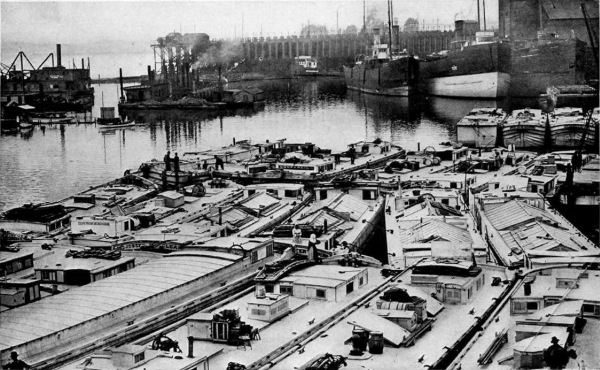
A Fleet of Erie Canal Boats—Capacity of Each 150 Tons.
The boats on the new canal will be 1000 tons each.
Because of the waterways at her door, cheap power, and the millions of consumers within a night’s reach of her mills, Buffalo has become the second city in the United States in the production of flour, now ranking next to Minneapolis, and at her present129 rate of increase she will be the world’s greatest milling centre in another five years. In 1901, she was producing only about half a million barrels of flour; in 1907, her product was over three million barrels, and it is predicted that the output in 1909 will be four millions. Within the last three years Buffalo has become the chief malting city in America. In 1907, her output was ten million bushels as compared with four million in 1900.
To handle her Lake freight at the present time, Buffalo has twenty-four elevators with a total storage capacity of twenty-two million bushels, and a daily elevating capacity of six million bushels; nine ore docks; five coal trestles with a daily loading capacity of twenty-two thousand tons—and with these might be included three railroad storage-yards with an aggregate capacity of four hundred thousand tons. Thirteen lines of steamships, not including the many companies represented by the big freighters, ply the Lakes from Buffalo; and the fifteen trunk lines centring in the city provide two hundred and fifty-three passenger trains a day. With all of this vast machinery working night and day to care for Buffalo’s present traffic, the question naturally arises, What will happen to Buffalo when the new Erie Canal links her with the sea?
During the next decade, or less, Buffalo will astonish the whole world by her industrial growth. The effects of the canal project are already being felt, and manufacturing130 capital is hurrying to Buffalo as never before. The Federal Government is deepening the Niagara River to a depth of twenty-one feet as far down as North Tonawanda, and this, together with the deepening of the Buffalo River, is opening up a new territory for factory sites, soon to be accessible to the largest ships. Millions of dollars of capital are locating, or planning to locate, here. On the one side is the cheap transportation of the Lakes; on the other will soon be the “man-made river reaching to the sea.” With the joining of these waterways no other city in the United States will be able to compete with Buffalo as a manufacturing centre.
The actual task of digging the new canal for which the people of New York voted one hundred and one million dollars, and which will connect Buffalo with tidewater by a thousand-ton waterway, is now at hand. Few people realise just how stupendous this task is. While every intelligent American is acquainted with the Panama Canal project, few know that this connecting link between the Lakes and the ocean is a greater public improvement for the State of New York to carry out than is the building of the Panama Canal for the United States Government, and it is of hardly less commercial value. Its cost will be greater than that of Suez, and in a short time its tonnage will be more than that of Suez. The first one hundred and twenty-five miles were under contract131 in January, 1908, with another sixty-five miles ready to be contracted for.
This great waterway, including the Hudson River, will pass from or to and through the city of New York and adjacent cities in New Jersey, Poughkeepsie, Albany, Troy, Schenectady, Utica, Syracuse, Oswego, Rochester, and Buffalo, besides smaller towns, possessing an aggregate population of over six million. The canal when completed will really terminate at Tonawanda, on the Niagara River, the route to Buffalo from there being via the Niagara River, the federal ship canal, and the Erie Basin. While the old canal has a depth of only from seven to nine feet and a width on the bottom of fifty-two, the new waterway will have a uniform depth of twelve feet, with a minimum width at the bottom of seventy-five feet, thus being capable of carrying boats one hundred and fifty feet long, twenty-five feet beam, and with a draft of ten feet. The present capacity of an Erie Canal boat is two hundred and forty tons, while the new boats will carry a thousand tons.
I have shown in preceding articles what a tremendous saving to the people of the United States is made because of Lake transportation, and this will be greatly increased by the new canal. Large aggregations of capital will own not merely Lake vessels, but terminals and canal fleets as well, so that from Lake ports they can name a through freight rate to New York or to foreign countries. Within132 a few years after its completion, the canal will probably be carrying twenty million tons of freight from Buffalo to the ocean. Taking this figure as a basis, it is easy to figure what a tremendous saving the canal will bring about. It now costs three and a half cents a bushel to send grain from Buffalo to New York. The new canal rate should be not more than a cent a bushel. On twenty million bushels of grain this means a saving of five hundred thousand dollars, which will either go into the pockets of the producer or the consumer or be divided between the two. Freight of all descriptions, manufactured products, and iron and steel, can be transported from Buffalo to tidewater for half of a mill per ton per mile. In other words, on the new canal all kinds of freight can be shipped from Buffalo to New York, a distance of four hundred and forty-six miles, at twenty-two cents per ton. The present cost is eighty-seven cents. On twenty million tons this saving of nearly sixty-five cents a ton would total nearly thirteen million dollars.
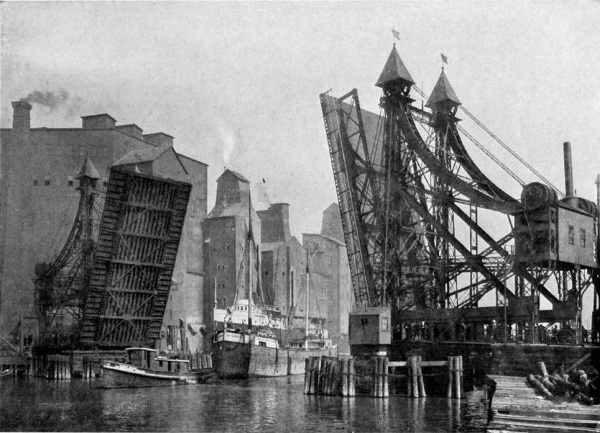
What this would mean to Buffalo it is almost impossible to estimate, especially in regard to the steel industry. Buffalo now has an advantage over Pittsburg in the cost of ore, limestone, and several other matters incident to the manufacture of iron and steel, Pittsburg’s sole remaining advantage being its proximity to coking coal. This will be obliterated. A large percentage of the vast steel and allied industries133 centring at Pittsburg will, of their own volition, move within the boundaries of the State of New York and locate along the Niagara frontier. This industrial migration has already begun. It will continue, naturally, ceaselessly. The ore will meet the coke at Buffalo, and the manufactured product will be floated down the Erie Canal instead of being hauled across the Alleghanies. This is inevitable.
And just as inevitable is the migration of other industries to Buffalo from other cities. Not only does the cheap lake and canal transportation call to them, but also the cheap and unlimited power of Niagara. A few years ago George Westinghouse said: “I expect to live to see the day when a city that will astonish the world will stretch along the entire Niagara frontier—and this city will be Buffalo.” Those who investigate this frontier to-day cannot fail to see the strength of his prediction. Tesla said that Niagara power would revolutionise manufacturing in the United States. It is already revolutionising it in and about Buffalo, and the power of the world’s greatest fall has only been tapped. On the American side the Niagara Falls Power Company is developing one hundred and five thousand horse-power, and the Niagara Falls Hydraulic Power and Manufacturing Company fifty thousand, while on the Canadian side the Canadian Niagara Falls Company is developing fifty thousand horse-power and the Electrical Development Company and the Ontario Power Company134 sixty-two thousand each. Less than four per cent. of the total flow of water over Niagara Falls has been diverted by the companies now in operation. The total fall of water is theoretically capable of producing over seven million horse-power, which would run virtually all of the manufacturing plants in the United States.
At the present time about seventy-five thousand electrical horse-power is consumed in Buffalo by manufacturing and mercantile establishments. What this cheap power means to the city can best be shown in figures. In nearly all cities the power required for manufacturing purposes is derived from steam produced from coal. In its simplest form this method of generating power requires apparatus consisting of steam boilers with their settings, pumps, steam-pipings, flues and stack, facilities for coal-storage, engines, foundations, and beltings—demanding altogether a large amount of floor-space. The cost of an installation of such equipment has been found to be approximately fifty dollars per rated horse-power. Electric motors using Niagara power can be installed for less than thirty dollars per rated horse-power. In other words, the saving in power to the manufacturer is almost one half. On the other hand, a steam plant requires a considerable force of men to operate and maintain it, while electrical power cuts down this service two thirds.
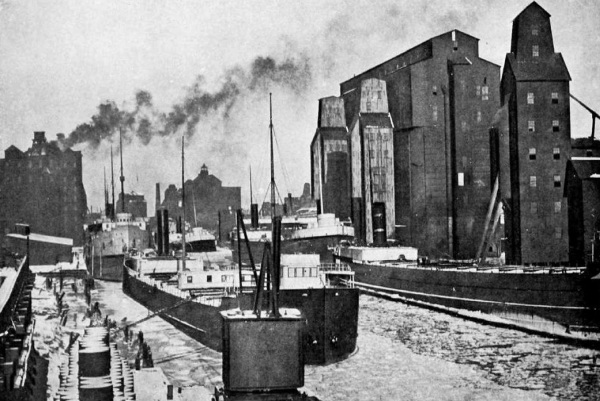
A Scene on Blackwell Canal.
The winter home of big boats in Buffalo.
Why manufacturers are flocking to Buffalo, and135 why the greatest manufacturing city in the world is bound to extend along the Niagara frontier, is graphically shown by the following figures comparing the cost of Buffalo power with that of other representative cities. Assuming the maximum power used to be one hundred horse-power, the number of working hours a day to be ten, and the “load factor,” or average power actually used, to be seventy-five per cent. of the total one hundred, the cost per month in the cities named is about as follows:
| Boston | $937.50 |
| Philadelphia | 839.25 |
| New York | 699.37 |
| Chicago | 629.43 |
| Cleveland | 559.50 |
| Pittsburg | 419.62 |
| Buffalo | 184.91 |
| Niagara Falls | 144.17 |
These figures show that the manufacturer on the Niagara frontier not only possesses the cheapest water-power in the country, but that his power costs him less than half as much as it cost his next nearest rival, the manufacturer at Pittsburg. While power costs his Boston competitor a hundred and fifty dollars per horse-power per year, the Buffalo manufacturer pays less than thirty dollars. Even without cheap transportation rates, this item alone would give him an overwhelming advantage in the race for trade.
Destined to be one of the greatest if not the greatest manufacturing city on earth, Buffalo is also one of the most beautiful. To-day she possesses four136 hundred miles of asphalt pavement—more smooth pavement than is found in Paris, Washington, or any other city. She is the greatest “home city” in America. Out of a population of more than four hundred thousand people, the home-owning population is only thirty thousand below the total registered vote. As a convention city she has only one rival, and that is Detroit. Nature has showered blessings upon her without stint. And I confidently believe that many of the young men and women of Buffalo will live to see the day when one city will stretch along the entire Niagara frontier, with a population exceeded by that of only one or at most two other American cities.
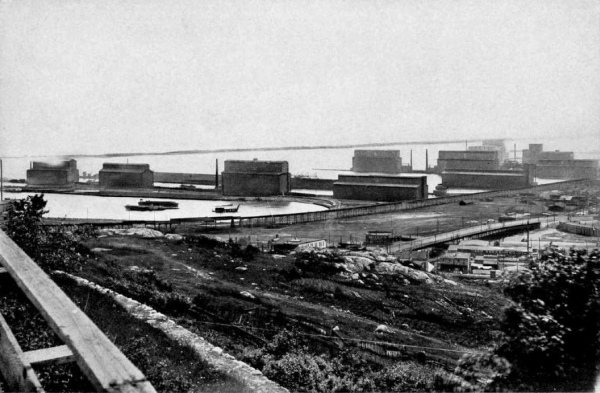
In my previous chapters I have described nearly every phase of Lake shipping, with the exception of one, which, while not being vitally concerned with the story of our fresh-water marine, is still one of the most interesting, and perhaps the least known of all. That is the “inner life” of one of our Great Lakes freighters; the life of the crew and the favoured few who are privileged to travel as passenger guests of the owners upon one of these steel monsters of the Inland Seas. In more than one way our Lake marine is unusual; in this it is unique.
Recently one of the finest steel yachts that ever sailed fresh water came up the St. Lawrence to the Lakes. Its owner was a millionaire many times over. With his wife he had cruised around the world, but for the first time they had come to the Lakes. I had the fortune to converse with him upon his yacht about the craft of other countries, and as we lay at anchor in the Detroit River there passed us the greatest ship on the Inland Seas—the Thomas F. Cole; and, addressing his wife, I asked, “How138 would you like to take a cruise on a vessel like that?”
The lady laughed, as if such a suggestion were amusing indeed, and said that if she were a man she might attempt it, and perhaps enjoy it to a degree, and when I went on to describe some of the things that I knew about “those great, ugly ships,” as she called them, I am quite sure that all of my words were not received without doubt. This little experience was the last of many that proved to me the assertion I have made before—that to nine people out of ten, at least, our huge, silent, red ships that bring down the wealth of the North are a mystery. They are not beautiful. Freighted low down, their steel sides scraped and marred like the hands of a labourer, their huge funnels emitting clouds of bituminous smoke, their barren steel decks glaring in the heat of the summer sun, there seems to be but little about them to attract the pleasure seeker. From the distance at which they are usually seen their aft and forward cabins appear like coops, their pilot houses even less.
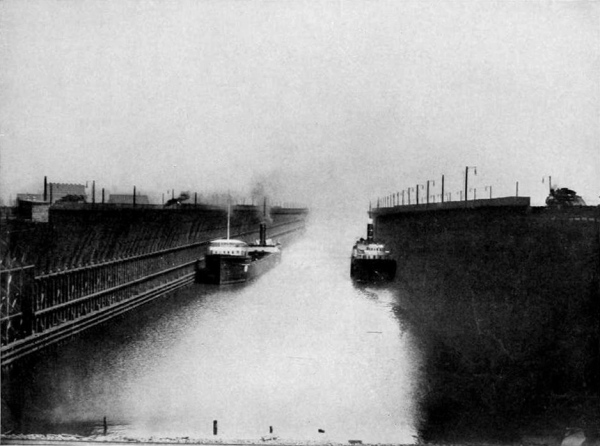
Yet fortunate is the person who has the “pull” to secure passage on one of these monster carriers of the Lakes, for behind all of that uninviting exterior there is a luxury of marine travel that is equalled nowhere else in the world except on the largest and finest of private yachts. These leviathans of the Lakes, that bring down dirty ore and take up dirtier coal, are the greatest money-makers in the world,139 and they are owned by men of wealth. The people who travel on them are the owner’s guests. Nothing is too good for them. Each year the rivalry between builders is increasing as to whose ships shall possess the finest “guests’ quarters.” Behind the smoke and dirt and unseemly red steel that are seen from shore or deck, a fortune has been spent in those rooms over the small doors of which one reads the word “Owners.” You may climb up the steel side of the ship, you may explore it from stem to stern, but not until you are a “guest”—not until the “key to the ship” has been handed to you, are its luxuries, its magnificence, its mysteries, clearly revealed.
My telegram read:
“Take my private room on the Harry Berwind at Ashtabula.”
It was signed by G. Ashley Tomlinson, of Duluth. The Berwind is one of the finest of Tomlinson’s sixteen steel ships and is named after one of the best known fuel transportation men on the Lakes—a vessel that can carry eleven thousand tons without special crowding and makes twelve miles an hour while she is doing it. I reached the great ore and coal docks at Ashtabula at a happy moment.
The other guests had arrived, seven in all—four ladies and three gentlemen, and we met on the red and black dock, with mountains of ore and coal about us, with the thundering din of working machines in our ears, and out there before us, enshrouded in140 smoke and black dust, the great ship that was to carry us for nearly a thousand miles up the Lakes and back again. It was a happy moment, I say, for I met the seven guests in this wilderness of din and dirt—and six of them had never been aboard a freighter in their lives. They had heard, of course, what lay beyond those red steel walls. But was there not a mistake here? Was it possible——
Doubt filled their faces. High above them towered the straight wall of the ship with a narrow ladder reaching down to them. At the huge coal derricks whole cars of coal were being lifted up as if they were no more than scuttles in the hands of a strong man and their contents sent thundering into the gaping hatches; black dust clouded the air, settling in a thousand minute particles on fabric and flesh; black-faced men shouted and worked at the loading machine; the crash of shunting cars came interminably from the yards; and upon it all the sun beat fiercely, and the air that entered our nostrils seemed thick—thick with the dust and grime and heat of it all. A black-faced, sweating man, who was the mate, leaned over the steel side high above us and motioned us aft, and the seven guests hurried through the thickness of the air, the ladies shuddering and cringing as the cars of coal thundered high over their heads, until they came to the big after port with a plank laid to the dock. Up this they filed, their faces betraying more doubt, more uneasiness,141 more discomfort as hot blasts of furnace air surged against them; then up a narrow iron stair, through a door—and out there before them lay the ship, her thirty hatches yawning like caverns, and everywhere coal—and coal dust. The ladies gasped and drew their dresses tightly about them as they were guided along the narrow promenade between the edge of the ship and the open hatches, and at last they were halted before one of those doors labelled “Owners.”
Then the change! It came so suddenly that it fairly took the breath away from those who had never been on a freighter before. The guests filed through that narrow door into a great room, which a second glance showed them to be a parlour. Their feet sank in the noiseless depths of rich velvet carpet; into their heated faces came the refreshing breaths of electric fans; great upholstered chairs opened to them welcomingly; the lustre of mahogany met their eyes, and magazines and books and papers were ready for them in profusion. To us there now came the thunder of the coal as if from afar; here was restfulness and quiet—through the windows we could see the dust and smoke and heat hovering about the ship like a pall.
This was the general parlour into which we had been ushered; and now I hung close behind the ship’s guests, watching and enjoying the amazement that continued to grow in them. From each side of the142 parlour there led a narrow hall and on each side of each hall there was a large room—the guest-chambers—and at the end of each hall there was a bathroom; and in the bedrooms, with their brass beds, their rich tapestries and curtains, our feet still sank in velvet carpet, our eyes rested upon richly cushioned chairs—everywhere there was the luxury and wealth of appointment that a millionaire had planned for the favoured few whom he called his guests.
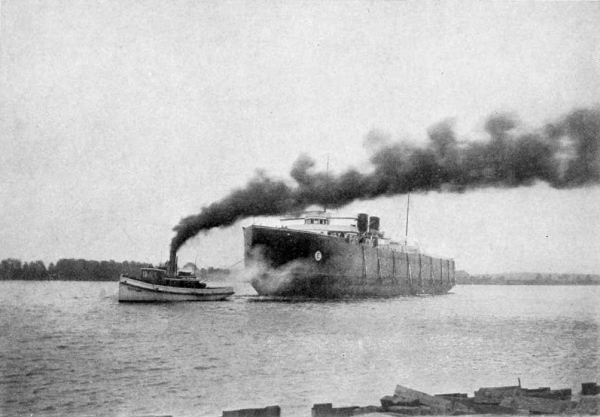
Now I retired from the guest-chambers to my own private room. I am going a good deal into detail in this description of the guests’ quarters of a great freighter like the Berwind, for I remember once being told by a shipbuilder of the Clyde that he “could hardly believe that such a thing existed,” and I know there are millions of others who have the same doubts. The forward superstructure of a Great Lakes freighter might be compared to a two-story house, with the pilot-house still on top of that; and from the luxurious quarters of the “first story,” which in the Berwind are on a level with the deck of the vessel, a velvet-carpeted stair led to the “observation room”—a great, richly furnished room with many windows in it, from which one may look out upon the sea in all directions except behind. And from this room one door led into the Captain’s quarters, and another into the private suite of rooms which I was fortunate enough to occupy on this trip. The finest hotel in the land could not have afforded finer conveniences143 than this black and red ship, smothered in the loading of ten thousand tons of coal. In the cool seclusion of its passenger quarters a unique water-works system gave hot and cold water to every room; an electric light plant aft gave constant light, and power for the fans. Nothing was wanting, even to a library and music, to make of the interior of this forward part of the ship a palace fit for the travel of a king. Within a few minutes we had all plunged into baths; hardly were we out and dressed when the steward came with glasses of iced lemonade; and even as the black clouds of grime and dirt still continued to settle over the ship we gathered in the great observation room, a happy party of us now, and the music of mandolin and phonograph softened the sounds of labour that rumbled to us from outside.
Then, suddenly, there fell a quiet. The ship was loaded. Loud voices rose in rapid command, the donkey-engines rumbled and jerked as their cables dragged the steel hatch-covers into place, and the freighter’s whistle echoed in long, sonorous blasts in its call for a tug. And then, from half a mile away, came the shrieking reply of one of those little black giants, and up out of the early sunset gloom of evening it raced in the maelstrom of its own furious speed, and placed itself ahead of us, for all the world like a tiny ant tugging away at a prey a hundred times its size. Lights sprung up in a thousand places along shore, and soon, far away, appeared the blazing eye144 of the harbour light, and beyond that stretched the vast opaqueness of the “thousand-mile highway” that led to Duluth and the realms of the iron barons of the North. Once clear, and with the sea before us, the tug dropped away, a shudder passed through the great ship as her engines began to work, our whistle gave vent to two or three joyous, triumphant cheers, and our journey had begun.
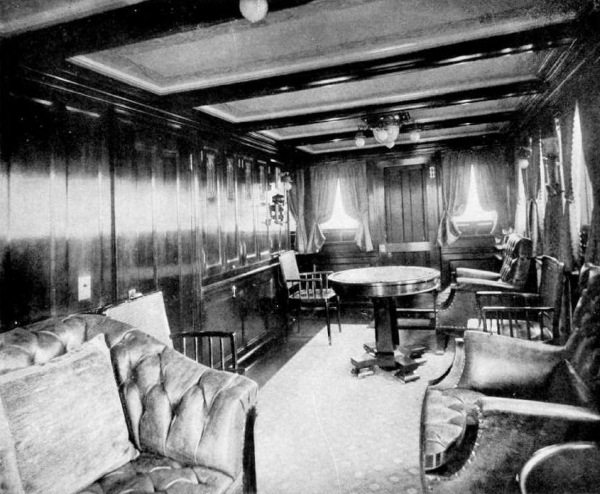
Observation Room on the “Wm. G. Mather.”
Which gives an idea of the luxuriousness of the guests’ quarters on a Great Lakes freighter.
It was then that our steward’s pretty little wife, Mrs. Brooks, appeared, smiling, cool, delightfully welcome, and announced that dinner was ready, and that this time we must pardon them for being late. Out upon the steel decks men were already flushing off with huge lengths of hose, the ship’s lights were burning brilliantly, and from far aft, nearly a tenth of a mile away, there came the happy voice of a deckhand singing in the contentment of a full stomach and the beautiful freshness of the night. Not more than a dozen paces from our own quarters was a narrow deckhouse which ran the full length of the hatches—the guests’ private dining-room. It was now ablaze with light, and here another and even greater surprise was in store for those of our party who were strangers to the hospitality which one receives aboard a Great Lakes freighter. The long table, running nearly the length of the room, glittered with silver, and was decorated with fruits and huge vases of fresh flowers, and at the head of the table stood the steward’s wife, all smiles and145 dimples and good cheer, appointing us to our seats as we came in. On these great ore and grain and coal carriers of the Inland Seas, the stewards and their wives, unlike those in most other places, possess responsibilities other than those of preparing and serving food. They are, in a way, the host and hostess of the guests, and must make them comfortable—and “at home.” On a few vessels, like the Berwind, there are both forward and aft stewards, with their assistants, who in many instances are their wives. The forward steward, like our Mr. Brooks, is the chief, and buys for the whole ship and watches that the aft steward does his work properly. Outside of this he devotes himself entirely to the vessel’s guests, and is paid about one hundred dollars a month and all expenses, while his wife gets thirty dollars for doing it. So he must be good. The stewards of Lake freighters are usually those who have “graduated” ashore, for even the crews of the Lakes are the best fed people in the world. Mr. Brooks, for instance, had not only won his reputation in some of the best hotels in the land, but his books on cooking are widely known, and especially along the fresh-water highways. I mention these facts because they show another of the little known and unusual phases of life in our Lake marine. For breakfast, dinner, and supper the tables in the crew’s mess-room are loaded with good things; very few hotels give the service that is found in the passengers’ dining-room.
146 Thus, from the very beginning, one meets with the unusual and the surprising on board one of these big steel ships of the Lakes. While towns and cities and the ten thousand vessels of the seas are sweeping past, while for a thousand miles the scenes are constantly changing—from thickly populated country to virgin wilderness, from the heat of summer on Erie to the chill of autumn on Superior,—the vessel itself remains a wonderland to the one who has never taken the trip before. From the huge refrigerator, packed with the choicest meats, with gallons of olives and relishes, baskets of fruits and vegetables—from this to the deep “under-water dungeons” where the furnaces roar night and day and where black and sweating men work like demons, something new of interest is always being found.
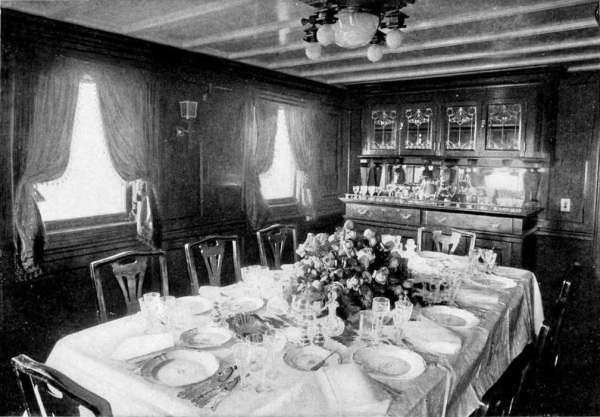
For the first day, while the steel decks are being scrubbed so clean that one might lie upon them without soiling himself, the passengers may spend every hour in exploring the mysteries of the ship without finding a dull moment. Under the aft deck-houses, where the crew eat and sleep, are what the sailors call the “bowels of the ship,” and here, as is not the case on ocean craft, the passenger may see for the first time in his life the wonderful, almost appalling, mechanism that drives a great ship from port to port, for it must be remembered that the “passenger” here is a guest—the guest of the owner whose great private yacht the great ship is, in a way,147 and everything of interest will be shown to him if he wishes. Of the bottom of this part of the ship the “brussels-carpet guest”—as sailors call the passenger who is taking a trip on a freighter for the first time—stands half in terror. There is the dim light of electricity down here, the roaring of the furnaces, the creaking and groaning of the great ship, and high above one’s head, an interminable distance away it seems, one may see where day begins. Everywhere there is the rumbling and crashing of machinery, the dizzy whirling of wheels, the ceaseless pumping of steel arms as big around as trees; and up and up and all around there wind narrow stairways and gratings, on which men creep and climb to guard this heart action of the ship’s life. The din is fearful, the heat in the furnace-room insufferable, and when once each half-minute a furnace door is opened for fresh fuel, and writhing torrents of fire and light illumine the gloomy depths, the tenderfoot passenger looks up nervously to where his eyes catch glimpses of light and freedom far above him. And then, in the explanation of all this—in the reason for these hundreds of tons of whirling, crashing, thundering steel—there comes the greatest surprise of all. For all of this giant mechanism is to perform just one thing—and that is to whirl and whirl and whirl an insignificant-looking steel rod, which is called a shaft, and at the end of which, in the sea behind the ship, is the screw—a thing so small that one stands in148 amazement, half doubting that this is the instrument which sends a ten-thousand-ton ship and ten thousand tons of cargo through the sea at twelve miles an hour!
After this first day of exploration, the real joyous life of the ship comes to one. Every hour of every day is one of pleasure. You are on the only ship in the world into every corner of which a passenger is allowed to go. You are, in so far as your pleasure and freedom go, practically the owner of the ship. The crew and even the captain may not know but what you are one of the owners, for nothing but your name is given to the officers before you come aboard. Of course, the steward has the privilege to tell you to keep out of his kitchen, and the captain for you to keep out of the pilot-house—but they never do it. That guest, for instance, who haunts the pilot-house almost from morning to night, who insists upon taking lessons in steering, and who on any other craft in the world would soon be told to remain in his cabin or mind his business, may be a millionaire himself—a millionaire who is giving this line of ships many thousands of dollars’ worth of freight each year. So the captain and the crew must be affable. But, as I have said before, this is accepted as a pleasure and not as a duty on the Inland Seas. I have taken trips on a score of vessels, and it means much when I say that never have I encountered an unpleasant captain, and that only once did I meet with a mate who was not pleasant to his passengers.
149 So, from the first day out, the big steel ship is an “open house” to its guests. Forward and aft of the cabins, great awnings are stretched, thick rugs and carpets are spread upon the deck, and easy chairs are scattered about. The captain and his mates are ready with the answers to a thousand questions. They point out objects and locations of interest as they are passed. There, in the late storms of last autumn, a ship went down with all on board; on yonder barren coast, five or six miles away, the captain guides your glasses to the skeleton of a ship, whose tragic story he tells you; he names the lighthouses, the points of coasts, and tells you about the scores of ships you pass each day. He shows you how the wonderful mechanism of the ship is run from the pilot-house, and he gives you lessons in the points of the compass, and perhaps lets you try your hand at the wheel. And each hour, if you have been abroad, you see more and more how an ocean trip cannot be compared to this. In a preceding chapter I have described what you see and what you pass in this thousand-mile journey to Duluth; how you slip from summer to autumn, from the heart of the nation’s population to vast, silent wildernesses where the bear and the wolf roam unmolested; how great cities give place to mining and lumber camps, and you come into the great northern lake where darkness does not settle until after nine o’clock at night.
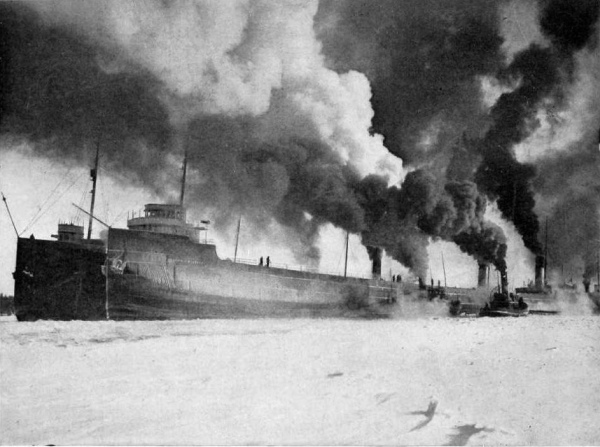
Tugs Trying to Release Boats Held in the Ice at the Soo.
Copyright 1906 by Young, Lord & Rhoades, Ltd.
But these are not the only things which make a trip on a Great Lakes freighter interesting. It is what you can do. There are a dozen games you can play, from hatch-bag to shuffle-board; there is music and reading, eating and drinking—for the steward is constantly alive to your wants, always alive to add to your pleasures. And there is excitement—if not of one kind then of another. You may be thrilled by the sudden alarm of fire aboard ship, and find yourself burning with relief when you discover that you are witnessing nothing but an exciting fire drill; it may be a wrestling or boxing match between two of the ship’s champions, a race over the steel hatches, or—something like the following incident:
One of the greatest sources of entertainment for guests aboard a Lake freighter is in the study of the men and boys of the crew, for the average crew of twenty-five or thirty always possesses some odd characters. Our party was very much amused by one individual, a youth of about twenty, large, round-faced, full-fed, a young man of unbounded good humour whose two great joys in life were his meals—and sleep. This youth never lost an opportunity to take a nap. After his dinner in the mess-room, he would promptly fall into a doze in his chair, to be aroused by a dash of cold water or some other practical joker’s trick; if he sat down on a hatch he would sleep; he would fall asleep leaning against the cabin. His151 actions caused no little uneasiness on the part of the captain, who liked the boy immensely. “Some day he will fall asleep and topple overboard,” he said.
We had come into Superior, where the clear, dry air exerts a peculiar effect upon one. Coming suddenly from the warm atmosphere of the Lower Lakes a person has difficulty in keeping his eyes open half of the time up there. We were off Keweenaw Point when the thrilling alarm was spread that “Dopey,” the sleepy youth, had fallen overboard. The aft steward brought the news forward. Billy had eaten a huge dinner and was taking a comfortable siesta standing, half leaning over the aft rail. A moment after passing him the steward returned, bent upon stirring the boy from his dangerous position, and found him gone. The vessel was searched from stem to stern. Even the passengers joined in the hunt. But there was found no sign of the missing youth, and a deep gloom fell upon the people of the ship. An hour later, one of the young ladies approached the steep, narrow stair that led down into the forward locker. The mate himself had searched this gloomy nook for Billy. I was a dozen feet behind the girl and she turned to me with a white, startled face.
“Come here—quick!” she cried. “Listen!”
Together we bent our heads over the opening—and up to our ears there came a mysterious sound now so low that we could hardly hear it, then louder—152something that for a moment held us speechless and set our hearts beating at double-quick. It was the snoring of a sleeping person! In another instant we were down in that dingy hole of ropes and cables and anchor chains, and there, curled up in the gloom, we found Billy, sleeping a sleep so sound that it took a good shaking to awaken him. On deck he explained the mystery. The passing of the steward aft had aroused him from his nap against the rail, and he had wandered forward, seeking the cool seclusion of the locker.
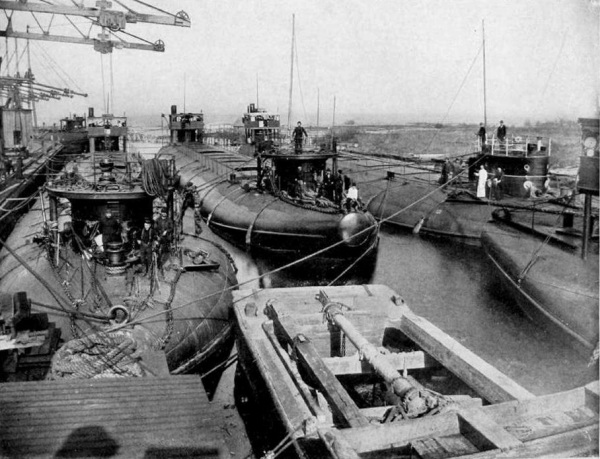
Whaleback Barges Preparing for Winter Quarters at Conneaut, Ohio.
(The Whaleback is a type of vessel that has been tried and found wanting. They are going out of use.)
While this little affair did not end in a tragedy, I give it as an illustration of the fact that something of interest, if not excitement, is constantly occurring to keep the guests of a Great Lakes freighter alive to the possibilities of the trip. The night following Billy’s mysterious disappearance, for instance, the two young ladies aboard our ship nearly brought about a mutiny. Before going into the details of this incident, it is necessary for me to repeat what I have said in a preceding paragraph—that the seamen of our Lakes are the best fed working people in the world. If a captain does not provide the best of meats and vegetables and fruits, and in sufficient quantities, he may find himself minus a crew when he reaches port. One day as I was leaning over the aft rail the steward approached me and said:
“Do you see that ship off there?”
He pointed to a big down-bound freighter.
153 “Notice anything peculiar about it?” he continued.
I confessed that I did not.
“Well, this is the noon hour,” he went on, “and the sea-gulls always know when it’s feeding time. But there are no gulls following that ship. There are a good many more ships in that same line—and there’s never a gull behind them. Do you know why? It’s because the grub on those boats is so poor. The gulls have learned to tell them as far as they can see ’em, and they won’t have anything to do with ’em, and that’s the Lord’s truth, sir! Any man on the Lakes will tell you so, and the men on those boats most of all. They don’t take a job there until they’re down and out and can’t get work anywhere else.”
On the afternoon of Billy’s adventure, the young lady who discovered him was taken slightly ill and was not present at dinner. Late that night, however, she was much improved—and ravenously hungry. As the steward and his wife were in bed there was no chance of getting anything to eat forward. In some way the girl had learned that a part of the crew, who were in the night watch, had luncheon in the aft mess-room at midnight, and this young lady and her chum, and the three young men in the party, planned to wait until after that hour and then, stealing quietly aft, help themselves to the “leavings.” At twelve-thirty, the decks were dark and silent, with154 the watch ahead of the forward deck-houses, and the young people made their way unobserved to the mess-room. Not a soul was about, and on the table was meat and cake and pickles, and a huge pot of coffee was simmering on the range. The five helped themselves. No one interrupted them, and when fifteen or twenty minutes later they slipped back to their quarters the table was pretty well cleaned. Now it just happened that the night men, instead of eating at midnight, ate at one—an hour later, and when they came in after six hours of hard work, tired and hungry, only the wreck of what should have been, greeted their astonished eyes. The men were in a rage. They had been imposed upon as no self-respecting, liberty-loving man of the Lakes will allow himself to be imposed upon—in the way of food; and it took the combined efforts of the two stewards and their wives, and the humble apologies of the three young men, to straighten the affair out. Thereafter, at midnight, the mess-room door was locked.
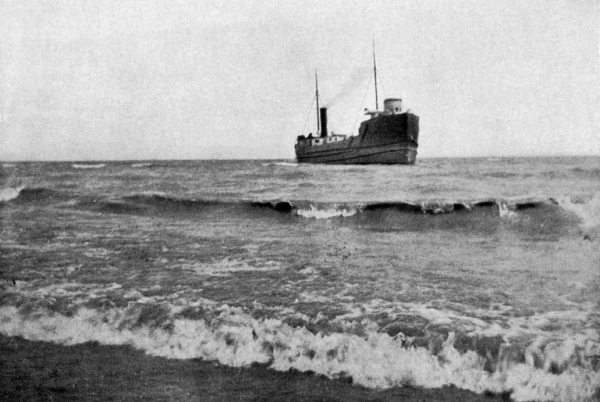
The more one comes in touch and sympathy with the lives of these men of the Lakes the more one’s interest increases; and it is not until one eats and drinks with them aft, and secures their confidence and friendship, that he is let into the secrets of the inner and home life of these red-blooded people, which is unlike the life of any other seafaring men in the world. It is when this confidence and friendship155 is won that you begin to reap the full pleasure of a trip on a Great Lakes freighter; it is then that the romance, the picturesqueness, and the superstition of the Lake breed creep out. Not until that time, for instance, will you discover that these rough strong men of the Lakes are the most indomitable home-owners in the world. A home is their ambition, the goal toward which they constantly work. From the deckhand to the young, unmarried mate it is the reward of all their labour, the end for which they are all striving. And there are good reasons for this—reasons which have made the “home instinct” among Lake sailors almost a matter of heredity. The ships of the Inland Seas are almost constantly in sight of land. Now it is a long stretch of coast a mile or so away; again it is a point stretching out to sea, or the shores of some of the most beautiful streams in America. And wherever there is land within shouting or megaphone or “whistle” distance of the passing vessels, there nestle the little homes of those who run the ships of our fresh-water marine. It may be that for an entire season of seven or eight months the Lake sailor has no opportunity of visiting his family. Yet every week or so he sees his home and his wife and children from the deck of his ship. It is easy for those ashore to learn from the marine officers when a certain vessel is due to pass, and at that hour wives and sweethearts, friends and children, assemble on the shore to bid their loved ones Godspeed. All156 of the vessels on the Lakes have their private code of signals. Perhaps in the still hours of night, the sleeping wife is aroused by the deep, distant roar of the freighter’s voice. For a moment she listens, and it comes again—and from out there in the night she knows that her husband is talking to her; and the husband, his eyes turned longingly ashore, sees a light suddenly flash in the darkness, and his heart grows lighter and happier in this token of love and faith that has come to him. And in the hours of day it is more beautiful still; and the passengers and crew draw away, leaving the man alone at the rail, while the wife holds up their baby for the father to see, and throws him kisses; and there is the silence of voiceless, breathless suspense on the deck that the faint voice of the woman, or the happy cries of the children, may reach the husband and father, whose words thunder back in megaphone greeting. It is beautiful and yet it is pathetic, this constant union of the people of the Lake breed. And the pathos comes mostly when there is no answer from the little home ashore, for it is then that visions of sickness, of misfortune, and possibly of neglect cast their gloom.
In a hundred other ways that I might describe does one see life on a Great Lakes freighter as on none of the vessels of the salt seas. It is a life distinct from all others, a life that is building a people within itself—the people of the Lake breed.
While the modern romance of the Great Lakes, the vast commerce that has grown upon them, the great cities along their shores, and the part they have played in the history of the last generation form, to my mind, one of the most absorbing and at the same time one of the most fruitful subjects for the writer of to-day, it is to the “dim and mysterious ages of long ago” that one must allow his imagination to be carried, if he would understand, in its fullest measure, the part that our Inland Seas should hold within the hearts of the American people. It has been my desire, in this volume, to establish between our people and our Lakes that bond of friendship which unfortunately has never existed except upon their very shores. In the years in which I have studied the Lakes, their commerce, and their people, I have been astonished at the dearth of material which has been published about them, and not until this discovery came upon me forcefully did I understand that our own glorious Inland Seas, holding in perpetual160 inheritance for the American people one half of the fresh water of the whole globe, are, indeed, “aliens in the land of their birth.”
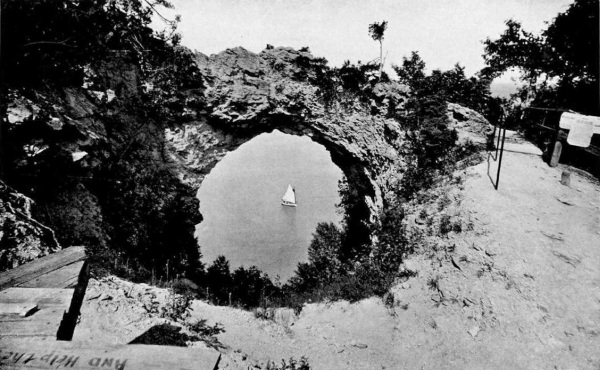
Arch Rock, Mackinac Island.
One of the Natural wonders of the world.
For this reason, I am adding to my preceding chapters a brief history of the Lakes. It is not what might be called a history in detail, for such a story of the Inland Seas would fill volumes in itself. No other portion of the globe has been fraught with more incident of historical and romantic interest than these fresh-water heritages of our nation. The dramas that have been played upon them or along their shores would fill libraries. Their unrevealed pages of romance and tragedy would furnish rich material for the writers of a century. About them lie the dust of three quarters of the aboriginal inhabitants of North America. Along their shores were fought some of the world’s most relentless wars of absolute extermination. Upon their waters occurred the most romantic adventures of the early exploration of the continent. Every mile of these waters, now clouded with the smoke of a gigantic commerce, is fraught with the deepest historical interest. And yet, as I write this, there comes to my mind a thought of those countless thousands of Americans who, travelling afar for their pleasures, seek in every quarter of the globe that their feet may tread in awesome respect upon spots hallowed because of their historical associations, whether those associations be of fact, of legend, or of song.
161 The romance of the Lakes does not begin with their early discoverers; neither does it begin with the primitive inhabitants along their shores. It dawns with their making. Unnumbered thousands of years ago, before the glaciers of the Ice Age crept over the continent; when prehistoric monsters, still living in a tropical world, roamed throughout what is now the Lake region; and when man, if he existed at all, was in his crudest form, the Great Lakes were still unborn. Where their ninety-five thousand square miles of surface now afford the world’s greatest highways of water commerce there were then vast areas of plain, of highland and plateau, rising at times to the eminence of mountains. Those were the days when the North American continent was completing itself, when the last handiwork in the creation of a world was in progress. In place of the Lakes there were then a number of great rivers in these regions—rivers, which despite the passing of ages, have left their channels and their marks to this day. These rivers were all of one system and were all tributary to one great stream, the Laurentian River, whose channel to the sea was that of the St. Lawrence of to-day. Were it possible for one to conceive himself back in those primitive times a journey over this first great river system of the continent would have carried him, first of all, from the still unfinished ocean along the south shore of what is now Lake Ontario. He would have travelled within ten miles of where162 scores of towns and cities now flourish, and almost directly opposite what is now the Niagara River he would have encountered another great stream pouring into the Laurentian from the south and west. This river continued almost through the middle of what is now Lake Erie, and opposite where Sandusky is now situated divided itself into two branches, which still exist in the Maumee and the Detroit. The Laurentian continued northward close along the southern shore of Georgian Bay, turned southward to the centre of the Lake Huron basin, where the Huronian River, sweeping across central Michigan, joined it from Saginaw Bay. The Laurentian itself passed northward through the Straits of Mackinaw and terminated in what is now Lake Michigan. The story of this vast water system has been left in clearly defined outlines; its indelible marks are ancient valleys, sand-filled channels of the great streams, and worn escarpments. Seldom has science had an easier story to read of ages that are gone.
Then came the second step in the creating of the Lakes of to-day. Slowly life changed as the Glacial Age approached, and with the sweeping back of life the rivers, too, passed out of existence. During the slow passing of centuries, their channels were filled, and the valleys were obstructed with drift, so that when the Ice Age had come and gone their channels no longer ran clear and unobstructed to the sea. As a consequence, great areas were submerged,163 and hundreds of thousands of square miles of what is now fertile land, populated by millions and dotted by cities, became an ocean. But the continent was still in process of formation. The land in the Lake region began to rise, and continued in its elevation until out of the chaos of sea the Lakes were formed. To the north-east, as the centre of the continent rose, there was a tilting of the land oceanward, and this warping dropped Lake Ontario below the level of the other Lakes, thus interposing a barrier to free communication to the sea and giving birth to Niagara Falls.
In this way, so far as science can tell, the Great Lakes of to-day were brought into existence. How early human life existed along their shores it is impossible even to guess, but that the earliest life of the continent should first of all gather in the valleys of the vast water system that gave them birth, and afterward reassemble along their shores, is highly probable. The earliest discoverers to penetrate into the wildernesses of the West found these shores inhabited by powerful nations. Other nations were facing extermination. Still others had ceased to exist and were forgotten except in legend. Along the Inland Seas have been found evidences of a superior race to the warlike aborigines of the days of La Salle. But only these evidences, utensils of copper and stone and clay, remain as proof of their existence. What they were, when they lived, and how they164 died, is one of the mysteries that will remain forever unsolved.
By the time the known history of the Lakes really begins their inhabitants had degenerated into warlike, ferocious savages, bent upon battle and extermination, and for the most part constantly embroiled in war of one kind or another. From Lake Ontario to the end of Superior the Lake regions were one great battle-ground, and this sanguinary history had extended so far into the past that with the coming of the first French explorers the Indians could give no comprehensive idea of when it had begun. At this time, early in the seventeenth century, the Lake country was the bone of contention among three quarters of the aborigines of North America. There was hardly a tribe that was not fighting some one of its neighbours, and the remnants of vanquished nations were constantly fleeing from their enemies and escaping total extermination by seeking safety in the West and South. In Northern Michigan and in Wisconsin there lived three branches of the Algonquin tribe, the Ottawas, the Ojibwas, and the Pottawatomies. The Ottawas had been driven westward, and the Ojibwas at this time were invading the hunting grounds of the Crees, who were entrenched on the northern shore of Lake Superior, their territory extending northward to Hudson Bay. On their west, the Ojibwas were also at war with the powerful Dakotas, who, fighting eastward from the Mississippi,165 had secured a foothold on Superior. To the eastward, encroaching upon the tribes of Lake Ontario, were the Iroquois, or Five Nations, consisting of the Mohawks, Oneidas, Onondagas, Cayugas, and the Senecas. Between these and the fierce Algonquins of the Upper Lakes were wedged the Hurons and the Eries, fighting vainly against the almost total extermination which became their fate a little later. It was in the war between 1650 and 1655 that both the Eries and the Neuters, on the southern shore of Lake Erie, were wiped out of existence by the Iroquois, and it was about this same time that the Hurons received their death-blow. The few that escaped fled to the Mississippi and promptly became involved in a war with the Sioux. Reduced to a pitiable remnant the once powerful Sacs and Foxes were awaiting their end along Green Bay.
In these days, the Lakes were already playing a part in commerce as well as in war. Great fleets of Indian canoes made annual voyages from the Upper to the Lower Lakes, and war fleets were common spectacles from almost every coast. The greatest of these fleets, so far as is known, was that of the Iroquois, which in 1680 carried six hundred selected braves across Lake Erie, up the Detroit River, through Lake St. Clair, Lake Huron, the Straits of Mackinaw, and down to the foot of Lake Michigan, where the adventurous navigators were utterly repulsed by the warriors of the Illinois. Another Iroquois fleet166 was annihilated near Iroquois Point, in Lake Huron. In 1600, according to stories told by the Indians, a fierce naval battle in which several hundred war canoes were engaged was fought in the middle of Lake Erie by the Wyandots and the Senecas. Only one Seneca canoe escaped.
It was at this time, when the Lake country and the Lakes themselves were the stage upon which were being played the most thrilling dramas of aboriginal history, that the Inland Seas were first visited by their white discoverers. In 1615, the Franciscan friar, Joseph Le Caron, in company with three other Franciscans and twelve Frenchmen, invaded the seat of the Huron nation on Matchedash Bay, where Champlain joined him a few days later. The Hurons were preparing to attack their old enemies, the Iroquois, and Champlain accompanied them on their expedition. The campaign was unsuccessful but it led to the Frenchman’s discovery of Lake Ontario. Stephen Brule, an unlettered and reckless adventurer, was the first white man to rest eyes upon Lake Superior, his voyage up Lake Huron being made some time in 1629. Brule, however, was more interested in ingots of copper which he found than in the greatest body of fresh water on the globe, and he returned south almost immediately, while it was left for Raymbault and Jogues, two hopeful missionaries in search of a passage to China, to make the first navigation of Superior. This they did in 1641. Five years after167 Brule’s discovery, another adventurer, Jean Nicolet, paddled in a birch canoe from Georgian Bay across Lake Huron and through the Straits of Mackinaw, and thus discovered Lake Michigan. As surprising as it may seem, Erie was the last of the Great Lakes to be found by white men, and although its existence was known to the French as early as 1640, it was not until 1669 that Joliet, its discoverer, made his voyage upon it.
The situation as it existed in the entire Lake country at the time of the coming of these first explorers was so unreasonably tragic that, viewed from the present day, it approaches dangerously near to having a touch of the comic about it. As one early writer says, “It was as if a pack of dogs were fighting over a bone. Only—where was the bone?” There was hardly an Indian tribe that was not at war with some other tribe, and in most instances, according to the discoverers, there were no evident causes for the sanguinary conflicts. “It was as if all the savages were impelled by a bad spirit, and a rage of extermination was sweeping over the land,” wrote one of the early Fathers. It is a popular superstition that the extinction of the red man must be ascribed to the coming of the white, but nothing shows more graphically the error of this belief than these conditions of the seventeenth century in the Lake country. The aborigines were exterminating themselves. They were doing the work completely, mercilessly.168 Nations had already been put out of existence. The Eries and Neuters were but lately annihilated. The once powerful Hurons were reduced to a remnant. The Sacs and Foxes were doomed. Existing tribes were weakened and scattered by ceaseless war. And sweeping down from the east the all-powerful Iroquois, the Romans of the wilderness, were coming each year to add to the completeness of the extermination.
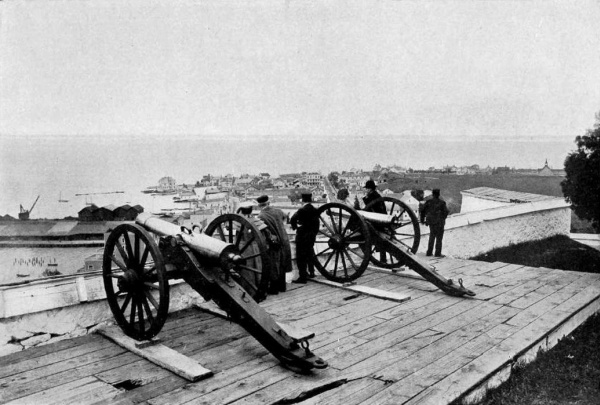
Now came the whites, and with their presence there developed slowly a check to the indiscriminate slaughter. At no time in the world was the missionary spirit more active, and scores of the disciples of the Church plunged fearlessly into the wilderness of the Lake regions, daring their perils of starvation and torture and death that the word of God might reach the hearts of the savages. And with them there came hundreds of adventurous spirits, trappers employed by the “Hundred Associates,” fortune-hunters, and reckless souls who had no other object than the excitement of exploration and discovery, but all of whom were staunch Catholics. The very fearlessness of these white invaders acted as a governor on the hostile energies of the savages, and their interests, in a small way at first, began to be diverted into other channels than those of war. Among the neutral nations on the Niagara River, Father Joseph de la Roche d’Aillon formed a mission early in the seventeenth century. As early as 1615, the Recollects169 had established a mission among the Hurons, which was later continued by the Jesuits. For more than thirty years, the missionaries had laboured among the Hurons when, in 1648, the Senecas and Mohawks fell upon their country, razed twenty of their villages, killed most of their 3000 fighters, and totally destroyed them as a people. Two of the Jesuit Fathers, Brébeuf and Daniel, gave up their lives in the fearful massacres of those days. It was only five years later that the Iroquois, destroyers of the Hurons, requested the French to send missionaries among them, and for nearly twenty years the zealous Jesuits brought about a lull in the sanguinary conflicts of the Five Nations, but at the end of that time when war flamed out anew they were compelled to abandon their missions. Meanwhile, along the Upper Lakes, the missionary movement was being prosecuted with extreme vigour. Garreau and Claude Allouez, with other missionaries, worked along the shores of Superior, establishing missions among the Sacs and Foxes and Pottawatomies. In 1668, Marquette established his famous mission at Sault Ste. Marie, and three years later founded the mission of St. Ignace on the Straits of Mackinaw.
It would take a volume to describe the adventures of these early Fighters of the Faith, their trials and sacrifices, their successes and failures. The briefness of our sketch compels us to move quickly from these absorbing scenes to the first great event in170 the history of Lake navigation, and to the beginning of that encroachment of the English which was to develop a hundred years of war along the Inland Seas. While the Jesuit Fathers were sacrificing their lives among the savages and while the Indian wars of extermination were still in progress, the French farther east had already begun to feel the hostile influence of the English. To check this influence La Salle and Count Frontenac brought about the erection of Fort Frontenac, in 1673, on the present site of Kingston. At this time, Robert Cavelier, Sieur de la Salle, a young man of eminence and learning, was of the supreme faith that he was destined to discover a water passage through the American continent to China and Japan, and the building of Fort Frontenac was only the first step in the gigantic scheme which he planned to carry out. A part of this scheme was the building of a vessel of considerable size in which La Salle planned not only to make a complete tour of the Lakes but in which he hoped to discover the route that would lead to the Orient. Five years later, the young adventurer made the portage around Niagara Falls, and at the mouth of Cayuga Creek, in Niagara County, New York, where is now located the town of La Salle, he began the construction of the first vessel ever to sail the Inland Seas.
There are different estimates as to the size of the ship, but that it was somewhere between fifty and171 sixty tons there is little doubt. Assisting in this work were Tonty and Hennepin, and it took all of the persuasive powers of the three to keep the Griffin, as the vessel had been named, from the hostile hands of the Senecas as she lay in her stocks. The ship, when launched, was completely rigged, found with supplies for a long voyage, and armed by seven pieces of cannon and a quantity of muskets. She carried two masts and a jib, and was decorated with the usual ornaments of an ancient ship of war, including a flying griffin at the jib-boom and a huge eagle aft. For hundreds of miles about, the Indians came to see this wonderful “floating fort” before she set sail. Thirty-two souls were to form the crew of the Griffin in her adventurous search for the route to Cathay, and on the day that she turned her prow up the Niagara River, La Salle and his followers fell upon their knees, invoking upon themselves the mercies of God in an undertaking which, they believed, was to be one of the most venturesome of their age. With all on board singing the Te Deum Laudamus, the Griffin passed into Lake Erie, and while at the sight of the great water ahead of them the priests again invoked the blessings of God, the first ship to sail the Lakes boldly headed into those “vast and unknown seas of which even their savage inhabitants knew not the end.”
According to the historian Hennepin, who was a member of the expedition, days and nights of the172 wildest speculation, of hope, of fear, and of anxious anticipation now followed. Rumour filled the seas ahead of them with innumerable perils. The hardy navigators knew not at what instant destruction might overtake them in any one of a dozen ways in which they supposed themselves to be threatened. Each morning and night the entire crew joined in prayers and in singing the hymns of the Church. Lake Erie was crossed in safety, and on the eleventh of August the Griffin entered the Detroit River. Hennepin was enthralled with its wonderful beauty. “The river was thirty leagues long,” he says, “bordered by low and level banks, and navigable throughout its entire length. On either side were vast prairies, extending back to hills covered with vines, fruit trees, thickets, and tall forest trees, so distributed as to seem rather the work of art than nature.” Passing between Grosse Isle and Bois Blanc Island, the Griffin sailed slowly up the river, frequent stops being made along its course; it passed the present site of Detroit, and on the day of the festival of Saint Claire the navigators entered the lake which they gave that name. On the twenty-third of August, the Griffin entered into Lake Huron, the Franciscans chanting the Te Deum for the third time, and the entire crew joining in offering up thanks to the Almighty for the smiling fortune that had thus far accompanied them on their voyage.
Crossing Saginaw Bay the Griffin lay for two days173 among the Thunder Bay islands and then continued her way into the North. Almost immediately after this, La Salle and his companions were caught in a terrific storm, and in the height of its fury, when it was thought that the end had come and that all the demons of this mysterious world were working their destruction, La Salle made a vow that if God would deliver them he would erect a chapel in Louisiana to the memory of St. Anthony de Padua, the tutelary saint of the sailor. As if in response to this vow, the wind subsided and the storm-beaten Griffin found shelter in Michilimackinac Bay, where a mission had been built among the Ottawas. Early in September, the Griffin sailed into Lake Michigan and continued to Washington Island, at the entrance to Green Bay. Here a party of missionaries and traders had been established for a year. They had collected a large quantity of furs, valued at about twelve thousand dollars, and La Salle changed his original plans and sent the Griffin back to Niagara with this treasure, with the idea of continuing his own exploration by canoe.
On the eighteenth of September, 1679, La Salle bade adieu to the Griffin and her crew, and from the point of a headland watched her white sails until they dropped below the horizon. It was the last he ever heard or saw of the ship. No sign of her was ever afterward found, no soul who sailed with her lived to tell the story of her tragic end. In the174 years that followed, it was rumoured that Indians boarded and destroyed her, and massacred her crew. Hennepin was of the opinion that she was lost in a storm. Others believed that some of her crew had mutinied and that after murdering their companions they had joined the Ottawas, where they met their own fate. From time to time in recent years, relics have been found along the Lakes which have revived stories of the mysterious disappearance of the Griffin, but none of these finds have yet thrown reasonable light upon the tragic end of this first vessel to navigate the Inland Seas and of the venturesome spirits who manned her. By all but a few the Griffin is forgotten, or has never been known. Yet by the millions who live along the Great Lakes she should be held in much the same reverence as are the caravels of Columbus by the whole nation.
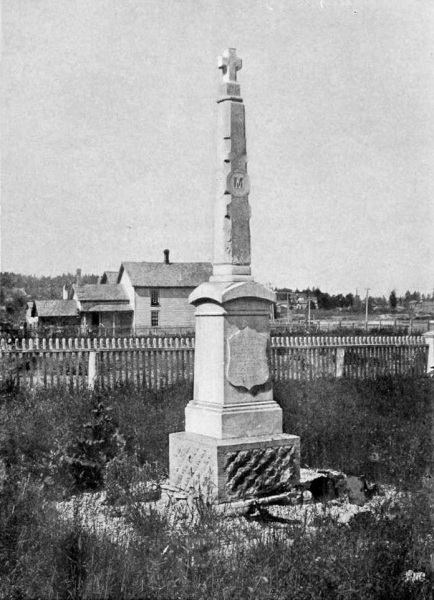
For more than a hundred years after the sailing of the Griffin the Great Lakes and the country about them were destined to be the scenes of almost ceaseless war. The fury of the internecine strife of the Indians was on the wane. Their conflicts of extermination had worked their frightful end and it now came time for them to give up the red arena of the Inland Seas to other foes, among whom the last vestiges of their power were doomed to melt away like snow under the warmth of the sun. For unnumbered generations they had fought among themselves. Nations of red men had been born, and nations had died. The Lake regions were white with their bones and red with their blood, and now those that remained of them were to be used as pawns in the games of war between the English and the French, among whom they were still to play an important though a fatal part.
The romantic voyage of the Griffin marked that era when the French were gaining possession of the Lakes. Eight years before La Salle’s expedition, Simon Francis Daumont had taken formal possession176 of the Inland Seas in the presence of seventeen different Indian nations. In 1761, a fort had been erected at Mackinaw, and Daniel Deluth, after whom the city of Duluth was named, planted a colony of French soldiers among the Sioux and Assiniboines of Minnesota. From this time on, the power of the French steadily gained in ascendancy and the work of winning the allegiance of the Indians progressed for a number of years without interruption. In 1686, Fort Duluth was built on the St. Clair River, and fifteen years later, in 1701, Cadillac built a fort on the present site of Detroit, which was destined to play a picturesque and important part in the century of war that was to follow. Other forts of the French were at Michilimackinac (Mackinac), Chicago, Green Bay, and on the Niagara River. Nearly all of the Indians of the Lake regions had become their allies, with the exception of the Iroquois. The forests and streams were the haunts of French traders. The Church was establishing itself more and more firmly among the tribes. The adventurous trappers of the fur companies were even living among the savages, and there was fast developing between the red men and the French that bond of friendship which was to remain almost unbroken through all of the troublous times that were to follow. The power of France, at this time, seemed bound to rule the destinies of the Inland Seas.
On the other hand, the Iroquois were the implacable177 enemies of the French and their allies, and the friends of the English. They were distributed over a territory which embraced the Lake Ontario regions and which extended to the English settlements of the East, thus offering a free and safe road of travel to English traders into the domains of the French. Reduced to less than a quarter of the fighting strength that they had possessed before the wars of extermination, they were still the terror of all other Lake tribes, and the English were not slow to take advantage of the opportunities which their friendship offered them. At every possible point the Five Nations checked the movements of the French, and at the same time assisted the English traders to invade their territory. In 1684, De la Barre, then Governor of Canada, determined to destroy this last menace to French dominion, and sent word throughout the Lake regions calling upon his warrior allies to assemble at Niagara for a great war of extermination upon the Iroquois. De la Barre himself proceeded to Lake Ontario with a powerful force of nearly two thousand men, but an epidemic of sickness attacked his army and the only result of the “campaign of extermination” was a peaceful conference with the Oneidas, Onondagas, and Cayugas.
The failure of De la Barre’s plans was the first great blow to French dominion. The English traders became more daring and parties penetrated even as far as Michilimackinac, one of the French strongholds.178 These traders were regarded as fair game by the French wherever found, but though several parties were captured the invasion from the East did not cease. Alarmed at the growing danger, the French determined to make another campaign against the Iroquois. To the existence of the Five Nations they ascribed their peril. With these fierce warriors out of the way they could easily hold the English back.
In 1687, the Marquis Denonville, who had succeeded De la Barre, gathered two thousand troops and six hundred Indian warriors at Montreal, and with the advice that a thousand Indian allies would meet him at Niagara set out for the land of the Iroquois. On June 23d, the forces met at Fort Frontenac and from there proceeded to Irondequoit, in the enemy’s country. Only the Senecas, one branch of the Five Nations, had gathered to meet the invaders, and in the fierce battle that followed, the French and their allies were defeated and driven to the shores of the lake. Satisfied with their victory, the Senecas did not press the invaders, and Denonville took advantage of his opportunity to build Fort Niagara, after which he led the remnant of his defeated army back to Montreal, leaving a garrison of one hundred men in the new stronghold. During the winter that followed, the Senecas besieged the fort with such success that less than a dozen of its defenders escaped with their lives.
179 News of the defeat of the French spread like wildfire. It penetrated to the farthest fastnesses of the known wildernesses. English traders began to swarm into the Lower Lake regions. The Indian nations allied to the French were thrown into a panic. The war spirit of the Iroquois was aroused to a feverish height by their victory, and they swarmed to the invasion of the French dominions. Fort Frontenac was captured and burned. Both the allies and the French were swept back with tremendous slaughter, and their power upon the Lower Lakes was broken. “It seemed,” said an early writer, “as if the Five Nations would sweep over the entire Lake country, driving all enemies from their shores, and thus delivering into the hands of the English all that the French had gained.”
But, in this hour of victory, the shadow of doom was hovering over the martial people of the Five Nations. For unnumbered years the conquerors of the New World, the time had at last come for their fall. The War of the Palatinate was at hand, and the hostilities of the French and the English spread to land and sea. Rumours came that Frontenac was about to sweep down upon New York, and the faithful Iroquois turned back to defend the city of their White Father. They threw themselves between the invaders and their friends, an unconquerable barrier. New York was saved, but in the struggle the power of the Five Nations was broken. For many years they180 still remained a force to be reckoned with, but as the conquering Romans of the Wilderness and the terror of a score of nations, extending even to the Mississippi, their history was at an end. In their passing it must be said that a braver man, a truer friend, or a more relentless foe never existed on the American continent than the Iroquois warrior.
There now came a brief lull in the warfare of the Lakes. The end of the War of the Palatinate was closely followed by Queen Anne’s War, but hostilities did not openly break out along the Inland Seas. The Treaty of Utrecht in 1713 left France technically in possession of the Lakes, but, even after this treaty, the English claimed as a sort of inheritance from the Iroquois the regions of Lake Ontario and Lake Erie. This fact again gave opportunity for plenty of excitement and trouble. The French had rebuilt Fort Frontenac and were establishing other strongholds, their object being to hem the English along their seacoast possessions by means of a string of forts extending from Canada southward. To frustrate these designs Governor Burnett, of New York, began the erection of a trading-post at Oswego in 1720. The French at once reciprocated by rebuilding Fort Niagara of stone, whereupon, in 1727, the English added a strong fort to their holdings in Oswego. This all but started active hostilities again. Beauharnois, the Governor of Canada, flew into a high dudgeon, sent a written demand for the English to181 abandon the fort, and threatened to demolish it unless this was done. The response of the English was to strengthen their garrison. Instead of carrying out his threat of war, Beauharnois began the strengthening of all the French forts, a work which continued for several years. Meanwhile the French trappers, traders, and priests of the Upper Lakes had been stirring the passions of the Indians against the encroaching English. The latter, in 1755, built two warships on Lake Ontario, and it was pointed out to the Western tribes that these were two of the terrible engines that were intended to work their destruction. By the time of the breaking out of the Seven Years’ War, the French, though their population was less than a tenth of that of their enemies, were splendidly prepared for war.
Actual operations in this last struggle between the French and the English for the possession of the Lakes began in 1756, when De Lery and De Villier set out with some six hundred men to capture Oswego and other forts. On the Onondaga River, De Villier encountered Bradstreet and his English and was completely defeated, more than a hundred of his men being killed. Meanwhile, from Fort Frontenac, General Montcalm was preparing to descend upon Oswego, and on the ninth of August, 1756, he arrived in sight of the English stronghold with three thousand men under his command. On the twelfth the battle began. From the beginning it was a surprise to both combatants.182 The victory of the French was comparatively easy and complete. The English loss was one hundred and fifty killed and wounded. Nearly two thousand prisoners were taken, one hundred and twenty cannon and mortars, six war vessels, and an immense amount of stores and ammunition. The blow was a terrific one for the English. Oswego had been their Gibraltar. In it were their shipbuilding yard, nearly all of their heavy ordnance, and a large part of the stores that were to supply them during the war. For the first time, the English realised what a terrible loss they had sustained in the breaking of the power of the Five Nations.
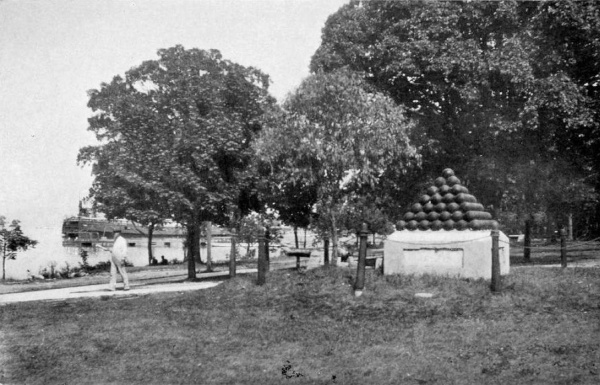
It was not until 1758 that the English regained a little of their lost prestige. Everywhere the French had been victorious. But, in the summer of this year, Colonel Bradstreet attacked Fort Frontenac with thirty-five hundred men, and after two days of battle the garrison surrendered. This was as decisive a blow to the French as was the loss of Oswego to the English. Ten thousand barrels of supplies, nearly a hundred cannon, and five vessels were destroyed. The French now saw that the beginning of the end was at hand. Little Fort Niagara was burned the following year to keep it from falling into the hands of their enemies, and a little later Fort Niagara surrendered. At this time French reinforcements were on their way to Niagara, but hearing of the fall of this last stronghold the ships183 which bore them were destroyed at the northern end of Grand Island, in a bay which from that time has been known as Burnt Ship Bay, and at the bottom of which, until a comparatively short time ago, the remains of the old vessels were plainly to be seen. With the fall of Montreal in 1760, the last flag of the French passed from the Great Lakes. Their warships were scuttled, their forts in the North surrendered, and within a few months England was everywhere supreme along the Inland Seas.
There now followed a curious and absorbingly interesting phase of Lake history. The English had conquered the French—but they had not conquered the red allies. The warriors of the Upper Lakes could not be made to understand the situation. “We fight until there are none of us left to fight,” they said. “Why is it that our French brothers have run? Shall we run because they have run? We were their friends and brothers. We are their friends now, and though you have conquered them we will still fight for them, so long as there are among us men who can fight.” A more beautiful illustration of the friendship and loyalty of the Indian warrior could hardly be conceived than this.
And it was largely this loyalty, this loyalty to a race that had been destroyed in their regions, that was to result in those terrible wars and massacres which marked the course of English rule along the Lakes, almost as regularly as mile-posts mark the184 course of a road. In the hearts of the savages there was an intense, ineradicable hatred of the English. They, and not the French, were regarded as the usurpers and despoilers of the country. This hatred was even greater than that of the Five Nations toward the French. It was something, as one old writer says, “beyond description, beyond the power to measure.”
In these days, a fearful fate was rolling up slowly for the string of forts along the Inland Seas, a doom that came without warning and with terrible completeness. At the head of the great conspiracy which was to result in the destruction of all the forts held by the English, with the exception of that at Detroit, was Chief Pontiac. On May 16, 1763, the first blow fell. By what was called treachery on the part of the Indians, but what would be termed stratagem in a white man’s war, Fort Sandusky was captured and its entire garrison, with the exception of one man, was massacred. Meanwhile a band of Pottawatomies from Detroit had hurried to the fort at the mouth of St. Joseph’s River, at the head of Lake Michigan, and, on the morning of the twenty-fifth, killed the whole of its garrison with the exception of three. Eight days later Michilimackinac (Mackinac) fell. On the morning of this fatal day, a large party of Ojibwas were to play a game of ball with the Sacs, and not a breath of suspicion filled the breasts of the doomed officers and men.185 Discipline was relaxed on account of the game. Excitement ran high. The Indians were in the best of spirits, and had never seemed more friendly. Their sole thought seemed to be of the great game. Scores of blanketed squaws and old men had assembled, and these, without creating suspicion, had gathered close to the open gates. The game began, and the shouting, struggling savages rushed this way and that in pursuit of the ball. Now they would surge far from the stockade, now so close that they would crush against its pickets. Suddenly the ball shot high into the air and fell inside the fort, and a hundred yelling savages rushed to the gates. Instantly the scene was changed. The squaws and the old men threw back their blankets and gave hatchets and guns to the warriors as they rushed past them. Within a few minutes, seventeen men were killed and the rest of the garrison were prisoners. Five of these prisoners were afterward killed by their captors. The fate of the garrison at Presque Isle was less terrible. For two days, the defenders of the fort held off the savages and then surrendered upon the promise that their lives would be spared. The prisoners were carried to Detroit.
During this time, while the conspiracy was working with such terrible success at nearly every point, the great Pontiac himself had failed in his designs upon Detroit. The garrison at this point was the strongest on the Lakes, being composed of one hundred and186 twenty men under the command of Major Gladwin and some forty or fifty traders and trappers. They were strongly entrenched behind palisades twenty-five feet high, were well supplied with the necessities of war, and Pontiac regarded them as invincible unless he could overcome them by stratagem. By the merest chance a fearful massacre was averted. Early in May Major Gladwin received warning of Pontiac’s plotting, but paid comparatively little attention to it until, under a clever pretext, the Indian chieftain asked that he and a number of his warriors be allowed to enter the fort. Under their blankets Pontiac and his braves carried hatchets and short-barrelled rifles, their intention being to take the unprepared garrison by surprise and during the first excitement of the fray to throw open the gates for the hundreds of armed savages waiting near. But when the Indians came within the palisades they found the garrison under arms and awaiting them.
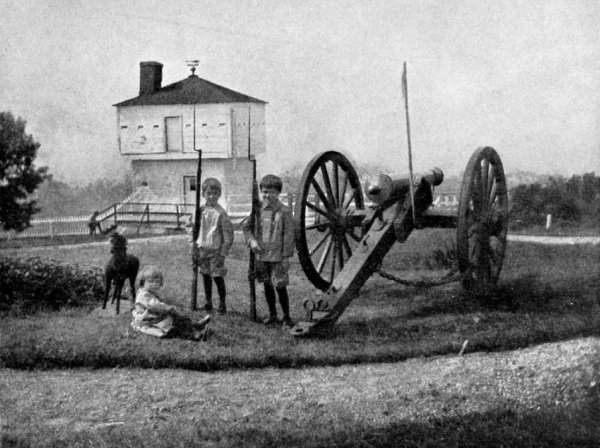
Old West Blockhouse, Fort Mackinac.
Built by the British, about 1780.
This frustrated all of the great chief’s carefully laid plans, and the attack was postponed. Three days later Pontiac again asked admittance to the fort, but was refused. Knowing that in some way his plot had been revealed to the English, Pontiac at once began his attack and for several hours fought desperately to take the stronghold, but was repulsed again and again with great loss. Desultory fighting, attacks and counter-attacks, were frequent features of the siege that followed. Meanwhile twenty187 boats and a hundred men, together with a large quantity of supplies, had left Fort Niagara for Detroit under the command of Lieutenant Cuyler, and these reinforcements were anxiously awaited by the besieged. They were destined never to reach Detroit. On June 28th, Lieutenant Cuyler and his command landed on Point Pelee with the intention of camping there for the night. Hardly had they drawn their boats upon the beach when they were greeted by a tremendous volley of musketry, and with frightful yells a horde of savages rushed down upon them from their ambush. Taken completely by surprise the English made no resistance but fled precipitately for their boats. Less than forty men, many of them wounded, escaped in three boats and made for Fort Sandusky, which they found had been destroyed. All hope of reaching Detroit was now abandoned and the worn and wounded remnants of the reinforcing party rowed back to Niagara.
Meanwhile the condition of the garrison at Detroit was becoming desperate. Both ammunition and food were becoming exhausted, many of the defenders were wounded or sick, and each day seemed to add to the strength of the savage besiegers. On the morning of June 30th, seven weeks after the beginning of the siege, a large number of boats flying the English flag were seen coming up the river. Joy gave place to horror when it was seen that these boats were filled with Indians and with white prisoners, the188 latter being those who were captured at Point Pelee. While these savage victors had been making their way westward, Lieutenant Cuyler and his handful of fugitives were on their way to Niagara, where they brought news of the destruction of Fort Sandusky and of the possible fate of Detroit. At Fort Niagara was the armed schooner Gladwin, named after the defender of Detroit, and on July 21st, she sailed for the besieged fort carrying with her supplies and a reinforcement of sixty men. On the night of the 23d, while the schooner was lying becalmed between Fighting Island and the mainland in the Detroit River, she was attacked by the Indians, who were completely repulsed. For several days, while slowly making her way up the river against headwinds and current, the cannon of the Gladwin spread consternation and havoc among the savages along the shores. Late in July, Captain Dalzell arrived with a score of barges, bringing cannon, ammunition, supplies, and an additional force of three hundred men. Pontiac, however, was still hopeful of success. His force had been increased by more than a thousand warriors, and this fact led to the sending of another reinforcement from Fort Niagara. Six hundred regulars under the command of Major Wilkins left late in September. Near Pointe-aux-Pins they encountered a terrific gale on Lake Erie in which seventy men and three officers besides an immense amount of stores and ammunition were lost, a calamity which189 compelled the survivors to return to Niagara. Winter brought partial relief to Detroit. The great number of Pontiac’s warriors made the struggle for subsistence a hard one and with the coming of the cold months the tribes separated to keep from starvation, leaving only a part of their fighting men to maintain the siege, thus removing for the time being the immediate danger of the capture and massacre of the garrison.
During the winter that followed, the English prepared to begin a campaign in the spring of a magnitude heretofore unknown among the wilderness tribes. The daring and confidence of the Indians were becoming more and more menacing. On September 14th, one of the most terrible massacres of the Lake country occurred at Devil’s Hole, three miles below Niagara Falls. The Devil’s Hole is now visited by thousands of tourists each year, but probably not one in a hundred knows of the bloody conflict that gave it its name. On that day, a convoy of soldiers were returning to Fort Niagara from Fort Schlosser, and in the gloomy chasm of the “Hole,” which leads from the bluffs above down to the river, a party of ambushed Senecas were awaiting them. Unaware of their danger, the soldiers came within a few rods of the ambush, and in the massacre that followed all but three of the total number of twenty-four were killed. A strong force from Niagara came to give the Indians battle and was190 completely defeated, losing about twoscore of its men.
The English were now practically wiped out of the Lake country, with the exception of along the Niagara and at Detroit, and the investment at the latter place threatened to be successful unless prompt steps were taken for the relief of the fort with an overwhelming force. It was not until August of the following year that a force sufficiently powerful for the campaign was gathered at Fort Schlosser. With three thousand men, General Bradstreet set out in bateaux to first strike a blow at the Indians along Lake Erie. Instead of fighting, however, the Ohio tribes were anxious to make peace with the invaders, and after a few skirmishes and many promises on the part of the Indians, Bradstreet reached Detroit. The long siege, which had existed for more than a year, was broken, treaties of peace were signed with many Indian tribes, and the English again secured possession at Michilimackinac, Green Bay, and Sault Ste. Marie. But Pontiac was irreconciliable and, like Robert Bruce of old, fled into the West with a few of his followers to await another opportunity to swoop down upon his enemies.
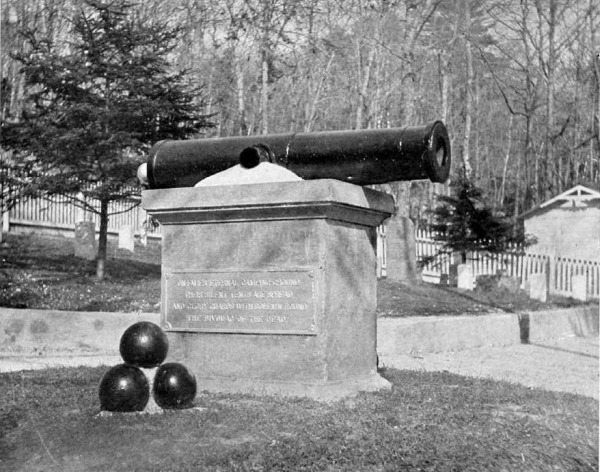
But the balance of fate still seemed to be with the untamed children of the wilderness, for Bradstreet’s return to Fort Niagara was marked by disasters sufficient to offset much that he had achieved. At Rocky River, near Cleveland, he was caught in a191 terrific gale and met a fate similar to that which had overtaken Major Wilkins in the preceding September. In the rush for shore, twenty-five of his bateaux, six cannon, and a great quantity of his baggage and ammunition were lost, together with scores of his men. The force was now divided, a part of it to make its way through the wilderness, and the remainder to travel in the uninjured bateaux. Bradstreet reached Niagara on November 4th, but for twelve weeks the land force fought its way through tangles of forest and swamp, fighting, starving, and dying of disease and exposure. The number of those who were lost in the storm and in this overland march has never been recorded, but it was so large as to occasion petitions to the government, which was an unusual thing in those days of war and carnage. From that day to this, at various times, Lake Erie has given up relics of the lost fleets of Major Wilkins and General Bradstreet in portions of old bateaux, gun-flints, musket-barrels, bayonets, cannon balls, and other objects. At one time, when a sandbar at the mouth of the Rocky River changed its position, a vast quantity of these relics were revealed, showing that one of the lost bateaux had sunk there and had been uncovered after a lapse of many generations.
For a number of years after the subjugation of the Indian tribes, the peace of the Lakes was disturbed only by the rivalries of the fur-traders and unimportant skirmishes with the savages. The era192 of warships on the Inland Seas had now begun, and by the time the Revolutionary War broke out, they were patrolled by quite a number of armed vessels bearing the flag of England. The Lakes were destined to play but a small part in the struggle for independence, however, and the most tragic event of these years upon them was the loss in a storm of the British ship Ontario, of twenty-two guns, which went down between Niagara and Oswego with her entire crew and more than a hundred of the 8th King’s Own Regiment. At this time, Spain was scheming to gain a foothold in the Lake regions, and, in 1781, a force under Don Eugenio Purre left St. Louis in the depth of winter and captured the English fort at St. Joseph. For only a few hours the flag of Spain floated over the Lake country, Don Eugenio’s scheme being merely to secure a “claim” to the regions, and once his banner had risen triumphantly above the captured fort he abandoned his position and retreated to St. Louis.
Several times during the Revolutionary War it was proposed that an attempt be made to capture Detroit, but no efforts were made in this direction, so that when peace was declared and the colonies were granted their independence, England still remained in possession of the Great Lakes. It was not until 1796 that the line of forts along their shores were surrendered into the hands of the Americans. On July 4th of that year, Forts Niagara, Lewiston,193 and Schlosser floated for the first time in history the banner of the new nation, and a week later, Captain Moses Porter raised the same emblem above Detroit. Thus after having been the stage of almost ceaseless war for more than a century and a half did it seem that peace had at last come to the Great Lakes regions. Yet were the clouds already gathering which a few years later were to burst forth in another storm of blood along the shores and upon the waters of the Inland Seas.
The years of peace which followed the surrender of the English along the Lakes were not ones of rapid development. It was as if this vast country, bathed in blood for more than a hundred and fifty years, had fallen into a restful sleep. Until 1800 there was almost no emigration west. By the new nation, the shores of Lake Erie were still regarded as in the far wilderness. The fur-trade, it is true, increased in volume, but not until after 1805 did the traffic of the Lakes begin to show any decided growth. From then on conditions brightened. Settlers began going into Ohio. Lake Ontario developed a considerable shipping-trade, and both the United States and Great Britain began to strengthen their naval forces, the American ships being almost entirely on Lake Ontario. At the time of the breaking out of the War of 1812, American interests on Lake Erie were almost entirely unguarded, the only vessel patrolling it being a small brig armed with six-pounders which, after its capture by the British, was named the Detroit. To195 make the situation of the Americans still worse a curious change had been working among the Indians and French. The bitter enemies of the English only a few years before, they now became their staunchest allies, and the first blow struck was largely by the Ottawas and Chippewas, who joined Captain Roberts at St. Joseph in an attack upon Mackinac. Lieutenant Hanks, who was in command of the fort, had no knowledge of the declaration of war and fell an easy victim to the strategy of Roberts and his Indians and French. Not a gun was fired in the capture of this important post, which gave to the victors the key to the entire North, and at once placed them in a commanding position for the approaching struggle.
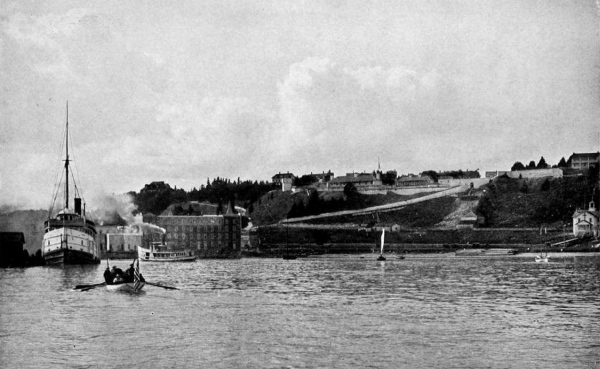
Events now began to assume a more warlike aspect along the Lakes. At Detroit, the Americans had been assembling in force, and on July 12, 1812, General Hull crossed the river into Canada at the head of twenty-two hundred men, his object being to prevent further construction on British fortifications which were in progress near Sandwich. Seven days later, Commodore Earle, in command of the British naval forces on Lake Ontario, made a futile bombardment of Sacketts Harbour. Meanwhile at York, now Toronto, Major-General Brock was assembling his forces, and before Hull crossed the river, he had established himself at Fort Niagara and had sent reinforcements under Colonel Proctor196 to Amherstburg, a few miles down the river from Detroit, where the British were to act as a check to Hull. The latter had prepared to march upon Malden when General Brock’s appearance at the head of a large body of British and Indian troops sent him in precipitate retreat to Detroit.
Before his attack upon the Americans, Brock sought an interview with the Indian chief Tecumseh and succeeded in winning his friendship to the British cause. On August 15th, the attack upon Detroit was made, beginning with a bombardment from guns situated across the river. The Americans in their trenches were eager for battle. Never had a garrison been more confident of repulsing an enemy. As the British and Indians swept up to the attack, the men stood behind their shotted guns with lighted matches in their hands. When the enemy was less than five hundred yards away, and as his men, anxiously awaiting the order to fire, were sighting along their guns, General Hull suddenly commanded the white flag to be hoisted above the fort. Never were two combatants more thoroughly astounded. With a powerful force, strongly entrenched, Hull had surrendered without firing a shot. Two thousand men longing for battle and with the odds all in their favour became the prisoners of less than eight hundred British and six hundred Indians. It was a humiliating defeat. In an hour the prowess of the Americans had dropped to the lowest ebb. Hull’s cowardice197 not only placed the British in supreme control of the Upper Lake region but added greatly to the foes of the Americans. Those Indian tribes that had remained neutral at once turned to the British, and the disaffected militia of Canada were moved into enthusiastic support of Brock. On this same day Hull was directly responsible for one of the most horrible massacres of the Lake country. The commander at Fort Dearborn, which stood on the present site of Chicago, had received orders from Hull to evacuate his position, and, on the morning of Brock’s bombardment of Detroit, the fort’s entire garrison of seventy soldiers, together with many women and children, set out from its protection. They had gone as far as what is now Eighteenth Street when they were attacked from the rear by Miami Indians and a merciless slaughter followed. When only twenty men remained, the little force surrendered, and the captives were distributed among the savages.
At about this time there occurred an event on Lake Erie which somewhat lightened the gloom occasioned by the American reverses. Commodore Chauncey, in command of the American naval forces on Ontario, had sent Commander Jesse D. Elliott up to Erie to begin the construction of a navy. Elliott was a born fighter and not slow to grasp opportunities that came his way, and when he learned that the British ships Detroit and Caledonia were anchored under Fort Erie, he set out from Black Rock with198 one hundred and twenty-eight men, ran his boats alongside the two ships, and captured them in a fierce hand-to-hand conflict which began at three o’clock in the morning. The two vessels were at once got under way and the Caledonia was brought within the protection of an American battery near Black Rock. The Detroit was less fortunate and was compelled to haul to within a few hundred yards of a British battery. Elliott refused to abandon her until his ammunition gave out, and even then succeeded in bringing his prize to Squaw Island, where she was within the range of both American and British batteries. No sooner would one side gain possession of her than her captors would be driven off by the guns of the other, and in these attacks and counter-attacks the vessel was destroyed. Elliott, however, had the nucleus for his new fleet in the captured Caledonia.
At the beginning of the war, it was believed by both British and American officers that at least one of the decisive battles for the mastery of the Lakes would be fought somewhere on the Niagara frontier, and no sooner had Brock arranged civil and military matters in the West after the fall of Detroit than he hastened back to this scene of action. Meanwhile the Americans had been preparing to attack Queenston, near Niagara Falls, and from that point begin their invasion of Canada. The British were strongly entrenched upon the Heights but their199 force was considerably inferior in number to that of Colonel Van Rensselaer, who was in command of the Americans. On the evening of October 12th, a dozen boats began ferrying the troops across the river, while at the same time, Colonel Chrystie, with three hundred men, and Colonels Stranahan, Mead, and Bloom were marching to Lewiston. Early on the morning of the 13th, the British opened fire, in the face of which the Americans began scaling the Heights, driving the enemy back as they advanced. At the time of the crossing of the Americans, Brock was at Fort George but lost no time in hastening to the field of battle. In a little marshy plot at the foot of the summit on which the final struggle occurred, now marked by a small stone monument and overgrown with long grass and weeds, a bullet struck him through the body and he fell mortally wounded. This was a terrible blow to the British, but, in the face of the calamity, they gallantly mustered their forces for the recapture of the Heights. There were still about fifteen hundred Americans across the river, and if once they were allowed to join Colonel Van Rensselaer a position would be achieved of even greater importance than that of the British at Detroit and Mackinac. With one thousand men, the British began a furious attack of the Heights, which were defended by not more than three hundred of the Americans who had crossed the river. The battle was one of the most desperate and at the same time200 one of the most picturesque of the war, parties of the combatants being at times on ground so precipitous that it was difficult to maintain a footing. The Americans were gradually beaten back, and, notwithstanding the fact that a superior force was only a short distance away, they were compelled to surrender, those surrendered including all that had crossed the river, the majority of whom took no part in this last battle of the Heights. Ninety Americans were killed, about one hundred wounded, and over eight hundred became prisoners of war. The British lost less than one hundred and fifty men killed and wounded.
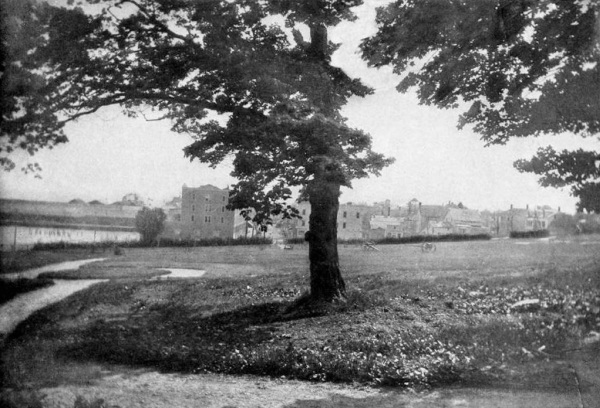
Thus far almost unbroken disaster had followed the American land forces in the Lake regions, much of which must be ascribed to the incompetence of commanding officers. Another fatal mistake was made a few weeks after the battle of Queenston Heights when, on November 28th, another invasion of Canada was attempted. Three thousand men under General Smyth were to comprise this expedition. At three o’clock in the morning, twenty-one boats left the American shore near Black Rock, but met with such a warm reception at the hands of the British that a number of the boats were compelled to fall back, and in the general excitement only a part of the force landed. Captain King, in command of one division, captured two batteries after a desperate struggle, spiked the guns, and with the assistance201 of Commander Angus and his men would have won a complete victory had not the latter, for some reason that has never been explained, retreated in his boats. As a consequence Captain King and a number of his men were captured, and thus a second attempt at a Canadian invasion fizzled out in complete disaster. This was practically the end of the campaign of the year 1812. There had been several minor naval events besides those which I have described and a few small operations on land, but all of them were unimportant.
The following year opened more auspiciously for the Americans, who were the first to begin active hostilities. On April 25th, Commodore Chauncey set sail with a squadron of fourteen vessels and seventeen hundred troops to attack York (Toronto). At this time York was poorly defended notwithstanding the fact that a 24-gun ship was almost completed in the harbour and an immense quantity of supplies were stored there. The Americans began disembarking early in the morning of the 27th, under the command of Brigadier-General Pike, while the armed schooners beat up to the fort and opened on it with their long guns. A strong wind forced the small boats, in which the troops were being carried, so close to the works that the landing instead of being made at a safe distance as had been planned was in the face of a galling fire. Despite this, General Pike assembled his men on the beach and began an immediate202 assault, the Canadians and English being driven from their works with heavy loss. In the moment of defeat, the garrison fired their powder magazine, and in the terrific explosion that followed, fifty-two of the victors were killed and one hundred and eighty wounded. Altogether the Americans lost seventy killed in both the land and naval forces, and the British one hundred and eighty killed and wounded and two hundred and ninety prisoners. The 24-gun ship was burned, and another vessel, the Gloucester, was added to the American fleet.
This victory was of tremendous importance to the Americans, and it was determined to at once follow it up by an attack on Fort George, where the British General Vincent was stationed with a force of over two thousand men, fifteen hundred of whom were regulars. On May 26th, Commodore Chauncey reconnoitred the enemy’s position and afterward held their interest while the Conquest and Tompkins destroyed a battery some distance down the lake. A part of General Vincent’s regulars attempted to prevent a landing at this point, but they were so terribly cut up by the short-range fire of the ships that they could offer but little opposition. So great was their loss that the British made little further effort to hold their position, blew up their fort, and retreated. Of the Americans, eighteen were killed and forty-seven wounded. The British203 loss was fifty-two killed, nearly three hundred wounded, and five hundred taken prisoners.
This last blow lost the Niagara frontier to the British. General Vincent at once gave orders that Forts Chippewa and Erie and all public property as far down as Niagara Falls should be destroyed. The magazine at Fort Erie was fired, and a little later, Lieutenant-Colonel Preston, in command of the Americans at Black Rock, took possession of what remained of the stronghold, thus giving Perry an opportunity to get out of the Niagara River five of the vessels which were to play such an important part in the naval history of Lake Erie. Sacketts Harbour was now in much the same condition that York (Toronto) had been, and was even more poorly defended. The British planned to regain a part of their lost prestige by its capture, and on May 27th, Commodore Sir James Lucas Yeo sailed with a large fleet and a strong land force under Sir George Prevost to make the attack. On the 29th, eight hundred of the British regulars landed, but despite the astonishing inadequacy of the American garrison they were beaten back with a loss of fifty-two killed and two hundred and eleven wounded, while the Americans lost but twenty-three killed and one hundred and fourteen wounded. The British squadron returned to Kingston, and for several weeks thereafter co-operated with the army forces and made several unimportant naval captures while Chauncey awaited204 the completion of the new ship Pike. During July, General Dearborn was recalled from his command at Fort George because of the capture by the British of Lieutenant-Colonel Boerstler and seven hundred men, and during this same month Black Rock was captured by the enemy and recaptured by the Americans, but it was not until the 30th that an important blow was struck by either side. On this day the Americans again descended upon York, destroyed eleven transports, burned the barracks, and captured a considerable quantity of supplies and ammunition.
Both the Americans and the British were now looking for a decisive naval battle between Yeo and Chauncey upon Lake Ontario. The squadrons were quite evenly matched with the advantage, if any, in favour of the Americans. Both commanders watched for a favourable opportunity to attack, but not until the 11th of August was a gun fired. After an almost harmless long-distance cannonade between the fleets, the Julia and Growler, two of Chauncey’s vessels, became separated from the main squadron and were cut off and captured by Yeo. For a month, the two fleets were chasing or evading each other, and it was not until the 11th of September that they approached close enough for another engagement, which was only slight. These “chase-and-run tactics” continued until the 28th, when the squadrons came together again in York Bay. In the action that followed, Yeo’s ships were badly damaged and ran205 for protection into Burlington Bay. This victory, although not resulting in the capture of the British fleet, completely established Chauncey’s supremacy and for the remainder of the season Yeo remained at Kingston.
For some months past, Captain Oliver Hazard Perry, acting under Commodore Chauncey, had been devoting his energies to the creating of a fleet on Lake Erie, and with such energy that on the memorable morning of September 10th, when from the masthead of the Lawrence at Put-in-Bay was seen the approaching squadron of Captain Robert Barclay, he had under his command nine vessels carrying a total of fifty-four guns and five hundred and thirty-two men. These vessels were the Lawrence, Niagara, Caledonia, Ariel, Scorpion, Somers, Porcupine, Tigress, and the Trippe. Barclay’s fleet was composed of the Detroit, Queen Charlotte, Lady Prevost, Hunter, Chippeway, and Little Belt, carrying a total of sixty-three guns and four hundred and forty men. It is interesting to note, according to Theodore Roosevelt’s Naval War of 1812, that notwithstanding the superior number of their guns the British ships were capable of throwing a broadside of only 459 pounds as against 936 pounds from the American squadron, a fact which shows the overwhelming superiority of Perry’s fleet and incidentally robs his victory of some of its glory.
In my examination of the many and various206 accounts of the naval battle of Lake Erie, I have found that the most complete and authentic report is that of Mr. Roosevelt, who goes with minute detail into the preparation, comparative strength, and handling of the two squadrons, and inasmuch as this battle of Erie is one of the most thrilling episodes of our Inland Seas, I have secured the very kind permission of Mr. Roosevelt to use a part of his description of the actual contest. Soon after daylight, on September 10th, Perry got under way and advanced toward the enemy in battle form.
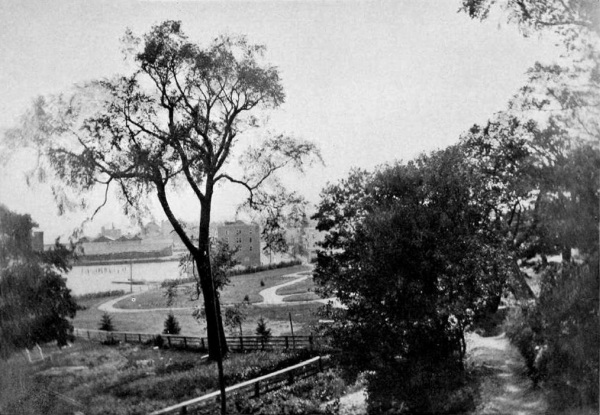
“As, amid light and rather baffling winds, the American squadron approached the enemy” [says Roosevelt], “Perry’s straggling line formed an angle of about fifteen degrees with the more compact one of his foes. At 11.45, the Detroit opened the action by a shot from her long 24, which fell short; at 11.50, she fired a second which went crashing through the Lawrence, and was replied to by the Scorpion’s long 32. At 11.55, the Lawrence, having shifted her port bow-chaser, opened with both the long 12’s, and at meridian began with her carronades, but the shot from the latter all fell short. At the same time, the action became general on both sides, though the rearmost American vessels were almost beyond the range of their own guns, and quite out of range of the guns of their antagonists. Meanwhile, the Lawrence was already suffering considerably as she bore down on the enemy. It was twenty minutes before she succeeded in getting within good carronade range, and during that time the action at the head of the line was between the long guns of the Chippeway and Detroit, throwing 123 pounds, and those of the Scorpion, Ariel, and Lawrence, throwing 104 pounds. As the enemy’s fire was directed almost207 exclusively at the Lawrence she suffered a great deal. The Caledonia, Niagara, and Somers were meanwhile engaging, at long range, the Hunter and Queen Charlotte, ... while from a distance the three other American gun-vessels engaged the Prevost and Little Belt. By 12.20 the Lawrence had worked down to close quarters, and at 12.30 the action was going on with great fury between her and her antagonists, within canister range. The raw and inexperienced American crews committed the same fault the British so often fell into on the ocean and overloaded their carronades. In consequence, that of the Scorpion upset down the hatchway in the middle of the action, and the sides of the Detroit were dotted with marks from shot that did not penetrate. One of the Ariel’s long 12’s also burst. Barclay fought the Detroit exceedingly well, her guns being most excellently aimed, though they actually had to be discharged by flashing pistols at the touchholes, so deficient was the ship’s equipment. Meanwhile, the Caledonia came down too, but the Niagara was wretchedly handled, Elliott keeping at a distance which prevented the use either of his carronades or of those of the Queen Charlotte, his antagonist; the latter, however, suffered greatly from the long guns of the opposing schooners, and lost her gallant commander, Captain Finnis, and first lieutenant, Mr. Stokes, who were killed early in the action; her next in command, Provincial Lieutenant Irvine, perceiving that he could do no good, passed the Hunter and joined in the attack on the Lawrence at close quarters. The Niagara, the most efficient and best-manned of the American vessels, was thus almost kept out of the action by her captain’s misconduct. At the end of the line the fight went on at long range between the Somers, Tigress, Porcupine, and Trippe on one side, and Little Belt and Lady Prevost on the other; the Lady Prevost making a very noble fight, although her 12-pound carronades rendered her208 almost helpless against the long guns of the Americans. She was greatly cut up, her commander, Lieutenant Buchan, was dangerously, and her acting first lieutenant, Mr. Roulette, severely wounded, and she began falling gradually to leeward.
“The fighting at the head of the line was fierce and bloody to an extraordinary degree. The Scorpion, Ariel, Lawrence, and Caledonia, all of them handled with the most determined courage, were opposed to the Chippeway, Detroit, Queen Charlotte, and Hunter, which were fought to the full as bravely. At such close quarters the two sides engaged on about equal terms, the Americans being superior in weight of metal, and inferior in number of men. But the Lawrence had received such damage in working down as to make the odds against Perry. On each side almost the whole fire was directed at the opposing large vessel or vessels; in consequence the Queen Charlotte was almost disabled, and the Detroit was frightfully shattered, especially by the raking fire of the gunboats, her first lieutenant, Mr. Garland, being mortally wounded, and Captain Barclay so seriously injured that he was obliged to quit the deck, leaving his ship in command of Lieutenant George Inglis. But on board the Lawrence matters had gone even worse, the combined fire of her adversaries having made the grimmest carnage on her decks. Of the 103 men who were fit for duty when the action began, 83, or over four fifths, were killed or wounded. The vessel was shallow, and the wardroom, used as a cockpit, to which the wounded were taken, was mostly above water, and the shot came through it continually, killing and wounding many men under the hands of the surgeon.
“The first lieutenant, Yarnall, was three times wounded, but kept to the deck through all; the only other lieutenant on board, Brooks, of the marines, was mortally wounded. Every brace and bowline was shot away, and the brig almost209 completely dismantled; her hull was shattered to pieces, many shot going completely through it, and the guns on the engaged side were by degrees all dismounted. Perry kept up the fight with splendid courage. As the crew fell one by one, the commodore called down through the skylight for one of the surgeon’s assistants; and this call was repeated and obeyed till none were left; then he asked, ‘Can any of the wounded pull a rope?’ and three or four of them crawled up on deck to lend a feeble hand in placing the last guns. Perry himself fired the last effective heavy gun, assisted only by the purser and chaplain. A man who did not possess his indomitable spirit would have then struck. Instead, however, Perry determined to win by new methods, and remodelled the line accordingly, Mr. Turner, in the Caledonia, when ordered to close, had put his helm up, run down on the opposing line, and engaged at very short range, though the brig was absolutely without quarters. The Niagara had thus become next in line astern of the Lawrence, and the sloop Trippe, having passed the three schooners ahead of her, was next ahead. The Niagara now, having a breeze, steered ahead for the head of Barclay’s line, passing over a quarter of a mile to windward of the Lawrence, on her port beam. She was almost uninjured, having so far taken very little part in the combat, and to her Perry shifted his flag. Leaping into a rowboat, with his brother and four seamen, he rowed to the fresh brig, where he arrived at 2.30, and at once sent Elliott astern to hurry up the three schooners. The Trippe was now very near the Caledonia. The Lawrence, having but fourteen sound men left, struck her colors, but could not be taken possession of before the action recommenced. She drifted astern, the Caledonia passing between her and her foes. At 2.45, the schooners having closed up. Perry, in his fresh vessel, bore up to break Barclay’s line.
“The British ships had fought themselves to a standstill.210 The Lady Prevost was crippled and sagged to leeward, though ahead of the others. The Detroit and Queen Charlotte were so disabled that they could not successfully oppose fresh antagonists. There could thus be but little resistance to Perry, as the Niagara stood down, and broke the British line, firing her port guns into the Chippeway, Little Belt, and Lady Prevost, and the starboard ones into the Detroit, Queen Charlotte, and Hunter, raking on both sides. Too disabled to tack, the Detroit and Charlotte tried to wear, the latter running up to leeward of the former; and, both vessels having every brace and almost every stay shot away, they fell foul. The Niagara luffed athwart their bows, within half pistol-shot, keeping up a terrific discharge of great guns and musketry, while on the other side the British vessels were raked by the Caledonia and the schooners so closely that some of their grape-shot, passing over the foe, rattled through Perry’s spars. Nothing further could be done, and Barclay’s flag was struck at 3 P.M. after three and a quarter hours’ most gallant fighting.”
In this conflict off Put-in-Bay, the American loss was twenty-seven killed and ninety-six wounded. Of these, twenty-two were killed and sixty-one wounded aboard the Lawrence. The British loss was forty-one killed and ninety-four wounded, the loss falling most heavily on the Detroit and Queen Charlotte.
Immediately after the battle, Perry wrote his famous dispatch to General Harrison: “We have met the enemy and they are ours; two ships, two brigs, one schooner, and one sloop”; and in a postscript he added, “Send us some soldiers to help211 take care of the prisoners, who are more numerous than ourselves.”
It is interesting to note what became of the vessels which played such an important part in this tragic drama of Lake Erie. The Lawrence, afterward repaired, was sunk in Misery Bay for preservation. Long afterward a part of her stem was raised and kept as a memorial. For years the Niagara was a training ship on Lake Erie, and was then sunk near the Lawrence. The Ariel, Little Belt, Chippeway, and Trippe were destroyed by the British at Buffalo. The Detroit was also sunk near the Lawrence, but in 1835, she was raised and rigged by a Captain Miles. She was afterwards purchased by a Niagara man, and as a spectacle for a crowd of curious people was allowed to break herself to pieces on the rocks above the Falls. The Queen Charlotte, Lady Prevost, and the Hunter were used in the Lake trade, and the Caledonia became the General Wayne. Both the Scorpion and the Tigress were recaptured by the British on Lake Huron.
The effects of Perry’s victory over Barclay’s squadron were immediate. The British at once gave up all hope of retaining their possessions on the Upper Lakes, and General Proctor began the evacuation of Forts Detroit and Malden. With all the boats that he could get into his possession he began a precipitate flight up the river Thames, where he was joined by the Indian chief Tecumseh and his212 warriors. Encouraged by this reinforcement he determined to select his own position for giving battle to the Americans, who were hurrying across country from Amherstburg under the command of General Harrison. Meanwhile, a number of the smaller American war vessels made their way up the Thames and Proctor prepared to meet them with his own armed boats. Harrison’s force, which outnumbered Proctor two to one, came up to the enemy close to the river, and the fierce charge of Colonel Johnson and his Kentucky horsemen almost immediately broke the enemy’s line. After a desperate struggle the regulars surrendered, but Tecumseh, who had from one thousand to two thousand warriors, continued to fight until he fell mortally wounded, when his braves broke and fled. The armed boats in the river were destroyed to keep them from falling into the hands of the Americans. Only a few years ago, two of these were discovered and raised. An accompanying illustration shows one of these vessels just after it was brought above the water, with a heap of old cannon balls amidships.
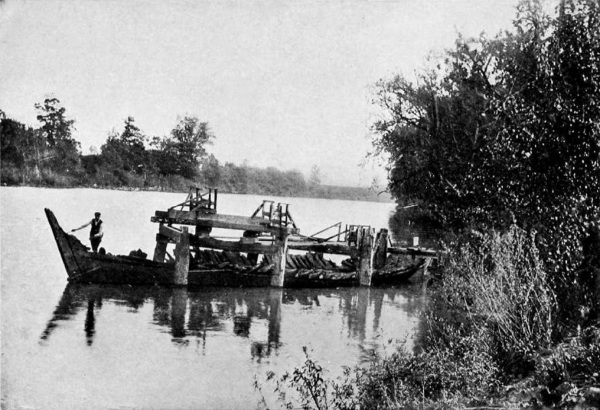
Perry’s victory and Harrison’s defeat of the British virtually decided the war along the Lakes, although, during the following winter, the British prepared to make one more tremendous effort to regain a part of the supremacy they had lost. This effort was to be made on Lake Ontario. During the whole of the winter of 1813–14, both Yeo and Chauncey213 strained every resource to prepare themselves for this final conflict, and it was during this time that the largest ships of war that ever floated on the Lakes were built, among them being the American ship Superior, to carry sixty-two guns, and the British ships Prince Regent, fifty-eight, and the Princess Charlotte, forty-two. The two fleets were pretty evenly matched, each squadron having eight ships, but with the Americans leading in tonnage, number of men, and guns. Yeo, however, was prepared for battle earlier than Chauncey, and taking advantage of this he prepared to attack Oswego, which was garrisoned by less than three hundred men and was in a wretched state of defence. On the 3d of May he set sail, having on board his squadron a detachment of over a thousand troops. The fire of the fort was drawn on the fifth, but it was not until the following day that the battle began in earnest, when five of the British warships began a terrific bombardment under cover of which eight hundred troops and two hundred seamen were landed. The little garrison fought with desperate valour and when they were finally driven from their position the British had lost ninety-five men, a number a third as great as the American force opposed to them. The Americans lost six men killed and thirty-eight wounded, the remainder escaping to the Falls.
On May 19th, Yeo transferred his operations to Sacketts Harbour, where he began a strict blockade,214 much to the discomfiture of Chauncey, who still lacked important material for the completion of the Superior. It was while attempting to capture several small boats with a part of this material that two British gunboats, three cutters, and a gig, carrying several heavy guns and one hundred and eighty men, started up Sandy Creek on the thirtieth, and ran into an ambush laid by Major Appling and one hundred and twenty American riflemen. In the terrific volleys that followed, the British suffered heavily, eighteen of their number being almost immediately killed and fifty wounded. The entire force was captured with a loss on the American side of but one wounded. On June 6th, Commodore Yeo raised his blockade and from then until July 31st, when Chauncey brought out his squadron, nothing of importance was accomplished with the exception of two or three successful cutting-out expeditions on the part of the Americans. Even after this date, until the close of navigation, the two fleets acted merely in the capacity of watch-dogs, neither daring to attack the other. During the greater part of this period, Yeo was penned up in Kingston, while Chauncey, whose superior force would have made his co-operation of tremendous value to the land forces under General Brown, peremptorily refused this assistance, saying that his object was the destruction of the enemy’s fleet and not to “become a subordinate or appendage of the army.” On the other hand, he could not get215 Yeo to fight, so that his powerful force remained practically useless.
Meanwhile General Brown undertook his contemplated invasion of Canada, sending Generals Scott and Ripley to the attack of Fort Erie, which soon surrendered. A few days later, on July 5th, General Riall with a force of nearly 2000 British met the Americans near Chippewa, and one of the fiercest and most important battles of the war was the result. Notwithstanding the superior numbers of the enemy, the victory fell to the Americans, whose loss was 61 killed and 255 wounded as against 236 killed and 322 wounded on the British side. It was at this critical moment, when a successful and complete invasion of Canada might have been made, that General Brown wrote to Chauncey asking for his co-operation. Soon after this, General Riall was reinforced by 800 men under Sir George Gordon Drummond, and on the 25th of July, General Scott was sent against them with a force of 1200 men.
Scott was unaware of the full strength of the enemy until he found Riall and Drummond drawn up to meet him at Lundy’s Lane. This was at five o’clock in the afternoon, and with the idea of impressing upon the British that the entire American army was at his back, General Scott at once began the attack. The struggle was one of intense courage on both sides and continued until 10.30 at night, when the British were driven from the field, leaving216 General Riall a prisoner. The American loss had also been so severe that they retired from the field, abandoning a captured battery. During the night, this battery was again manned by the British and a bloody fight ensued the following morning before it was recaptured. At Lundy’s Lane, the Americans lost 171 killed and 571 wounded; the British 84 killed and 559 wounded. General Scott had been severely wounded in the struggle, and General Brown was laid up with injuries at Back Rock, so that the command fell upon General Ripley who at once made preparations to recross into the American frontier. Brown sent positive orders that this move should not be made and that General Ripley should hold Fort Erie. On August 2d, General Drummond, who had been reinforced by over 1000 men, laid siege to this stronghold, and for two weeks desultory fighting occurred around it. On the night of the 14th, at twelve o’clock, a terrific assault was begun upon the works and continued until daylight. The British had captured one of the bastions and it was while holding this position that a fearful explosion occurred directly under their feet, killing and wounding the greater portion of them and striking the decisive blow of the siege. The American loss was 17 killed and 56 wounded, while the British lost 221 killed and 174 wounded.
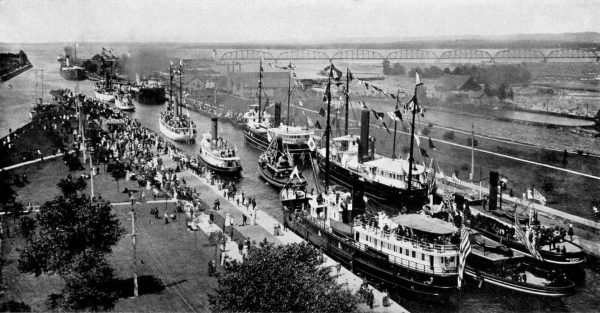
For several weeks, both sides continued to strengthen their positions, and by the middle of September,217 5000 Americans under Generals Brown and Porter were ready for an attack on the British. On the 17th, Riall was engaged by the entire American force and was driven from the position he had taken, with a loss of about 500 in killed and wounded. Meanwhile, General Izard’s division was hurrying to the frontier and with his arrival the American force was increased to 8000. Riall and Drummond in the face of these overwhelming odds retreated to Fort George and Burlington Heights, and on November 4th, Fort Erie was blown up, General Izard believing that it would be of no further use to the Americans. Active operations along the frontier then ceased for the winter.
During this breaking of British power along the Niagara frontier, there had occurred one or two interesting events on the Upper Lakes. Now that the British had lost their fleet on Erie, and that they had become almost fugitives from the American forces, those that remained of them seemed endowed with almost superhuman courage and ability. Captain Sinclair had sailed up into Lake Huron with the Niagara, Caledonia, Ariel, Scorpion, and Tigress, and had burnt the fort and barracks of St. Joseph, when the first of these exploits occurred. On August 4th, Sinclair had made an unsuccessful attack on Fort Michilimackinac (Mackinac), had burned a blockhouse, and then departed for Lake Erie, leaving the Scorpion and Tigress on Lake Huron. On the218 3d of September, four small boats filled with British made an attack on the Tigress under cover of darkness, and after a brief hand-to-hand struggle captured her. The commander of the Scorpion had no knowledge of this attack, and on the 5th, he innocently ran within a couple of miles of the Tigress, which was still flying the American flag. Early the following morning, the Tigress ran close up to the Scorpion, cleared her deck with a volley of musketry, and captured her without resistance being made. Meanwhile on the night of August 12th, a daring British expedition in small boats captured the armed schooners Somers and Ohio, with another armed ship, the Porcupine, lying near. In this exploit, seventy British seamen in small boats had captured two well-armed vessels carrying ninety men and with a strong sistership a few cable-lengths away, an achievement which has few rivals in naval history.
But these latter events, brilliant though they were, were of but slight importance. The British were defeated and broken from end to end of the Lakes, and peace was at hand. On December 24, 1814, fifteen days before the battle of New Orleans, peace was declared at Ghent, and with the signing of the treaty the sanguinary history of the Lakes, a story that had covered more than two centuries of ceaseless war and bloodshed, was at an end. From this time on, their history was to be one of colonization and commerce.
219 For a number of years previous to the War of 1812, there had been a growing tendency on the part of the people of the East to emigrate into the West, but the unsettled conditions of the whole Lake region, threatened by Indian war and the bloody feuds of rival trading-companies, held the bulk of the pioneers along Lake Ontario. Now the floodgates burst loose. Thousands of settlers hurried into Ohio, and others pushed on through the wilderness into Michigan. In 1818, the Walk-in-the-Water, the first steamer to float upon the Upper Lakes, was launched in Lake Erie, and began making trips from Buffalo to Detroit, charging eighteen dollars per passenger for the journey. Other vessels engaged in the passenger trade and emigrants were enabled to travel entirely by water. By 1820, Ohio possessed a population of over half a million. Nineteen out of twenty of the west-bound pioneers stopped somewhere along the shores of Lake Erie, and at this date Michigan’s population was less than nine thousand. But with the coming of other steamers, not only Michigan, but Illinois and Wisconsin began to receive a part of the westward-flowing tide. The Erie Canal had been opened as early as 1825, and the rapidity of the growth of commerce on the Inland Seas may be judged by the fact that in 1836 more than three thousand canal-boats were employed upon it, a large part of their traffic being the transportation of emigrants and their effects to the larger vessels on220 Lake Erie. During this year, there were ninety steamboat arrivals at Detroit, and one of these vessels, the United States, carried as high as seven hundred emigrants on a single trip. From that day to this, the ships of the Great Lakes have never been able to more than keep pace with the demands of trade. In 1836, vessel-men earned as high as eighty per cent. on the cost of their vessels. To-day they are still earning thirty.
Beginning with 1839, the emigrant travel to Chicago was so great that a line of eight vessels engaged in this traffic alone, each vessel making the trip once in sixteen days. It was now impossible to build ships fast enough to keep pace with the developing commerce. During the ten years between 1830 and 1840, the population of Michigan increased from 31,000 to 212,000, and practically the whole of it came by lake. In 1840, Wisconsin’s population was less than 31,000; ten years later, it was 305,000. By 1846, the value of the commerce of the Lakes was already enormous. Its value for that year is estimated to have been over eighty millions of dollars. In 1835, the American Fur Company built the John Jacob Astor, the first large ship to sail Lake Superior, and the trade in copper began soon after. With the discovery of the rich mineral deposits, hundreds of prospectors began flocking into the North, men with capital hurried to the regions of the red metal, and, in the race after wealth, vessel-men did not wait221 to build ships on Superior but hauled their vessels bodily across the mile portage at Sault Ste. Marie. In 1855 was built the Falls Canal, and from that date, the commerce of Superior became an important factor in the traffic of the Lakes. All that was needed to make it the most important body of fresh water on the globe was the discovery of iron. This discovery, and the part that iron has played in the making of our nation, have been described in preceding pages.
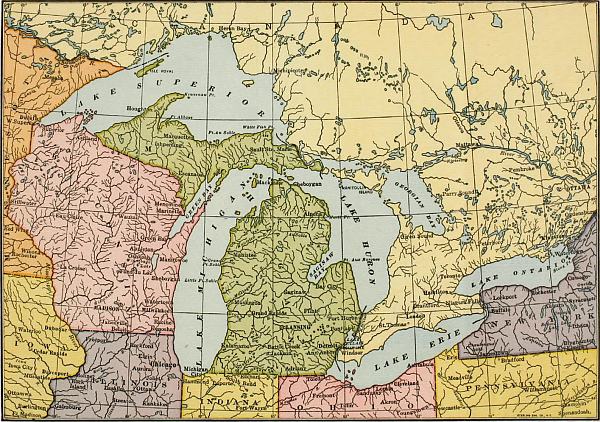
The Story of its Discovery in 1540, with an account of the Later Explorations, and with Special Reference to the Voyages of Powell through the Line of the Great Canyons.
By Frederick S. Dellenbaugh
Member of the United States Colorado River Expedition of 1871 and 1872
435 pages, with 200 Illustrations, and Frontispiece in Color. $3.50 net
“His scientific training, his long experience in this region, and his eye for natural scenery enable him to make this account of the Colorado River most graphic and interesting. No other book equally good can be written for many years to come—not until our knowledge of the river is greatly enlarged.”—The Boston Herald.
“Mr. Dellenbaugh writes with enthusiasm and balance about his chief, and of the canyon with a fascination that make him disinclined to leave it, and brings him thirty years later to its description with undiminished interest.”—New York Tribune.
By Archer B. Hulbert
Associate professor of American History, Marietta College,
Author of “Historic Highways of America,” etc.
390 pages, with 100 Illustrations and a Map. $3.50 net
An interesting description from a fresh point of view of the international struggle which ended with the English conquest of the Ohio Basin, and includes many interesting details of the pioneer movement on the Ohio. The most widely read students of the Ohio Valley will find a unique and unexpected interest in Mr. Hulbert’s chapters dealing with the Ohio River in the Revolution, the rise of the cities of Pittsburg, Cincinnati, and Louisville, the fighting Virginians, the old-time methods of navigation, etc.
“A wonderfully comprehensive and entirely fascinating book.”—Chicago Inter-Ocean.
Its Historic and Romantic Associations and Picturesque Setting
By Edgar Mayhew Bacon
Author of “The Hudson River,” “Chronicles of Tarrytown,” etc.
340 pages, with 50 Drawings by the Author, and with Numerous Photographs and a Map. $3.50 net
Impressed by the important and singular part played by the settlers of Narragansett in the development of American ideas and ideals, and strongly attracted by the romantic tales that are inwoven with the warp of history, as well as by the incomparable setting the great bay affords for such a subject, the author offers this result of his labor as a contribution to the story of great American Waterways, with the hope that his readers may be imbued with somewhat of his own enthusiasm.
“An attractive description of the picturesque part of Rhode Island. Mr. Bacon dwells on the natural beauties, the legendary and historical associations, rather than the present appearance of the shores.”—N. Y. Sun.
By James Oliver Curwood
With about 80 Illustrations. Probable price $3.50 net
This profusely illustrated book, as entertaining as it is informing, has the twofold advantage of being written by a man who knows the Lakes and their shores as well as what has been written about them. The general reader will enjoy the romance attaching to the past history of the Lakes and not less the romance of the present—the story of the great commercial fleets that plough our inland seas, created to transport the fruits of the earth and the metals that are dug from the bowels of the earth. To the business man who has interests in or about the Lakes, or to the prospective investor in Great Lakes enterprises, the book will be found suggestive. Comparatively little has been written of these fresh-water seas, and many of his readers will be amazed at the wonderful story which this volume tells.
Historical—Legendary—Picturesque
By George Waldo Browne
Author of “Japan—the Place and the People,” “Paradise of the Pacific,” etc.
385 pages, with 100 Illustrations and a Map. $3.50 net
While the St. Lawrence River has been the scene of many important events connected with the discovery and development of a large portion of North America, no attempt has heretofore been made to collect and embody in one volume a complete and comprehensive narrative of this great waterway. This is not denying that considerable has been written relating to it, but the various offerings have been scattered through many volumes, and most of these have become inaccessible to the general reader.
This work presents in a consecutive narrative the most important historic incidents connected with the river, combined with descriptions of some of its most picturesque scenery and delightful excursions into its legendary lore. In selecting the hundred illustrations care has been taken to give as wide a scope as possible to the views belonging to the river.
By Archer Butler Hulbert
Professor of American History, Marietta College; author of “The Ohio River,”
“Historic Highways of America,” etc.
350 pages, with 70 Illustrations and Maps. $3.50 net
Professor Hulbert tells all that is best worth recording of the history of the river which gives the book its title, and of its commercial present and its great commercial future. An immense amount of carefully ordered information is here brought together into a most entertaining and informing book. No mention of this volume can be quite adequate that fails to take into account the extraordinary chapter which is given to chronicling the mad achievements of that company of dare-devil bipeds of both sexes who for decades have been sweeping over the Falls in barrels and other receptacles, or who have gone dancing their dizzy way on ropes or wires stretched from shore to shore above the boiling, leaping water beneath.
Historical—Legendary—Picturesque
By Edgar Mayhew Bacon
Author of “Chronicles of Tarrytown,” “Narragansett Bay,” etc.
600 Pages, with 100 Illustrations, including a Sectional Map of the Hudson River. $3.50 net
“The value of this handsome quarto does not depend solely on the attractiveness with which Mr. Bacon has invested the whole subject, it is a kind of footnote to the more conventional histories, because it throws light upon the life and habits of the earliest settlers. It is a study of Dutch civilization in the New World, severe enough in intentions to be accurate, but easy enough in temper to make a great deal of humor, and to comment upon those characteristic customs and habits which, while they escape the attention of the formal historian, are full of significance.”—Outlook.
Historical and Descriptive
By Edwin Munroe Bacon
Author of “Walks And Rides in the Country Round About Boston,” etc.
500 Pages, with 100 Illustrations and a Map. $3.50 net
From ocean to source every mile of the Connecticut is crowded with reminders of the early explorers, of the Indian wars, of the struggle of the Colonies, and of the quaint, peaceful village existence of the early days of the Republic. Beginning with the Dutch discovery, Mr. Bacon traces the interesting movements and events which are associated with this chief river of New England.
Its History—Its Myths—Its Scenery—Its Commerce
By William Denison Lyman
Professor of History in Whitman College, Walla Walla, Washington
Fully Illustrated. Probable price, $3.50 net
This is the first effort to present a book distinctively on the Columbia River. It is the intention of the author to give some special prominence to Nelson and the magnificent lake district by which it is surrounded. As the joint possession of the United States and British Columbia, and as the grandest scenic river of the continent, the Columbia is worthy of special attention.
In Preparation:
Each will be fully illustrated and will probably be published at $3.50 net
1.—Inland Waterways
By Herbert Quick
2.—The Mississippi River
By Julius Chambers
3.—The Story of the Chesapeake
By Ruthella Mory Bibbins
4.—Lake George and Lake Champlain
By W. Max Reid
Author of “The Mohawk Valley,” “The Story of Old Fort Johnson,” etc.
Punctuation, hyphenation, and spelling were made consistent when a predominant preference was found in this book; otherwise they were not changed.
Simple typographical errors were corrected; occasional unbalanced quotation marks retained.
Ambiguous hyphens at the ends of lines were retained.
Index not checked for proper alphabetization or correct page references.
Page 190: “irreconciliable” probably is a misprint for “irreconcilable”.
Page 226: Index entry for “Ship-builders” referenced page v, but the term was split across pages vi-vii, and is shown here as being on page vi.